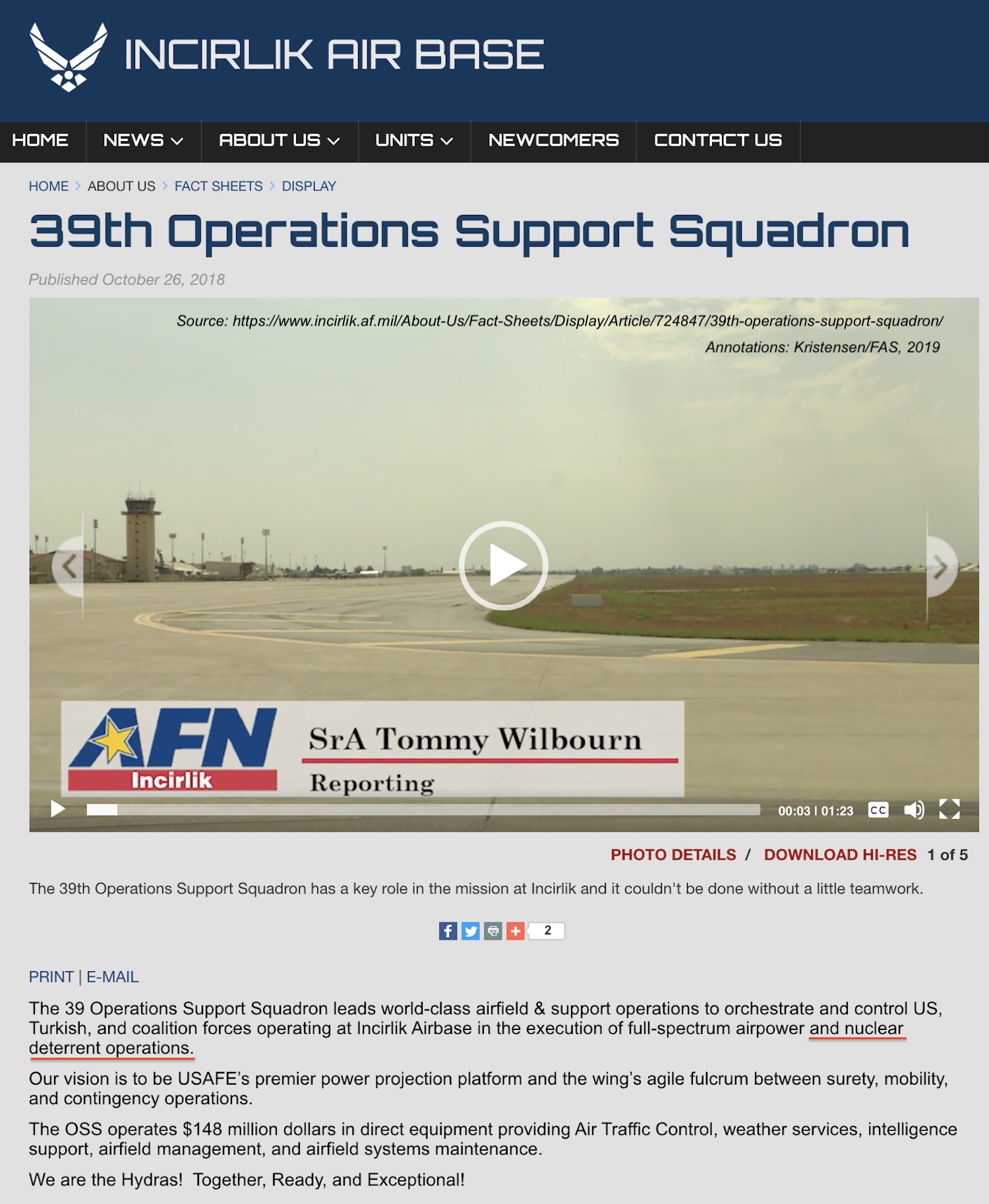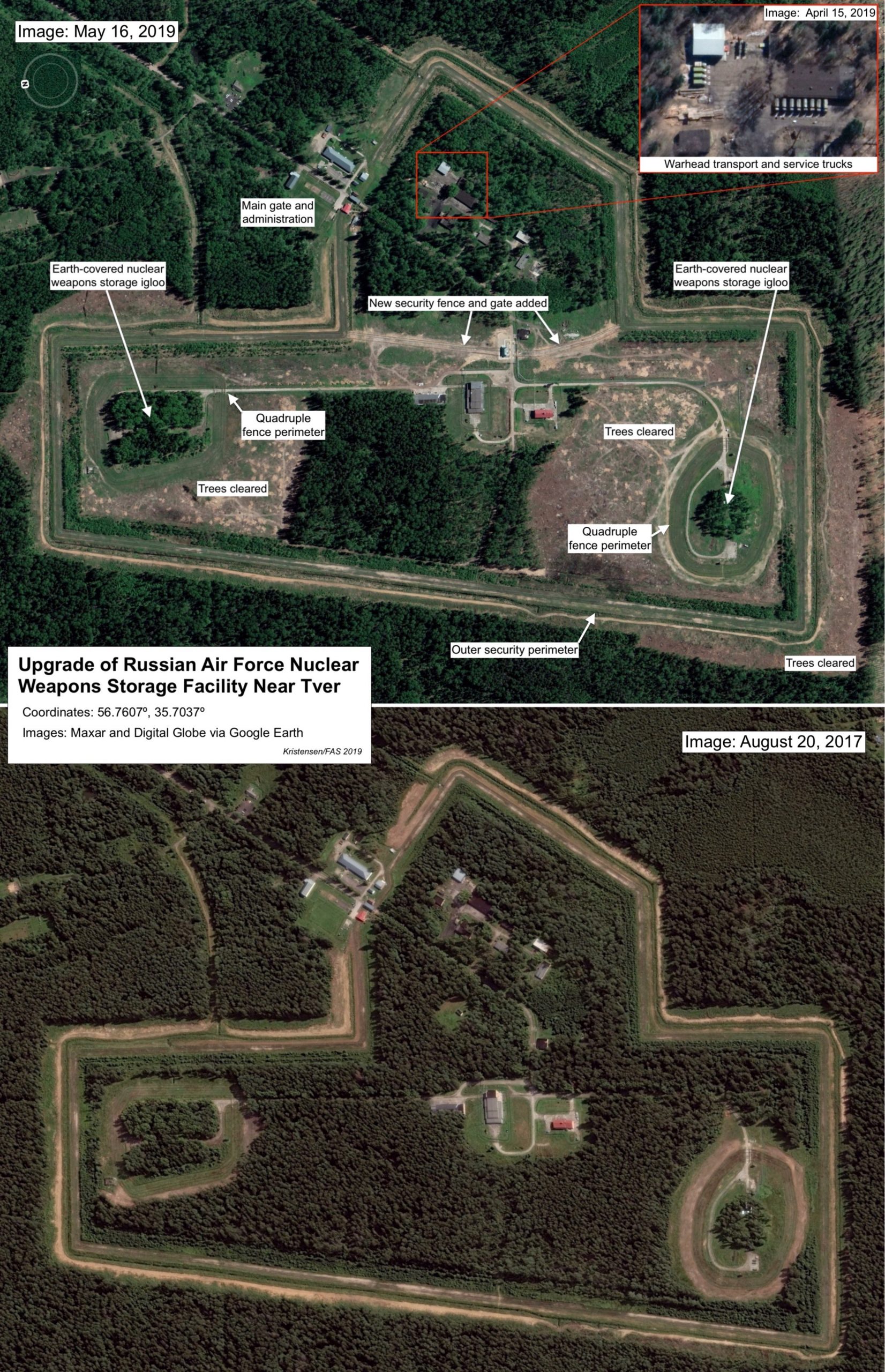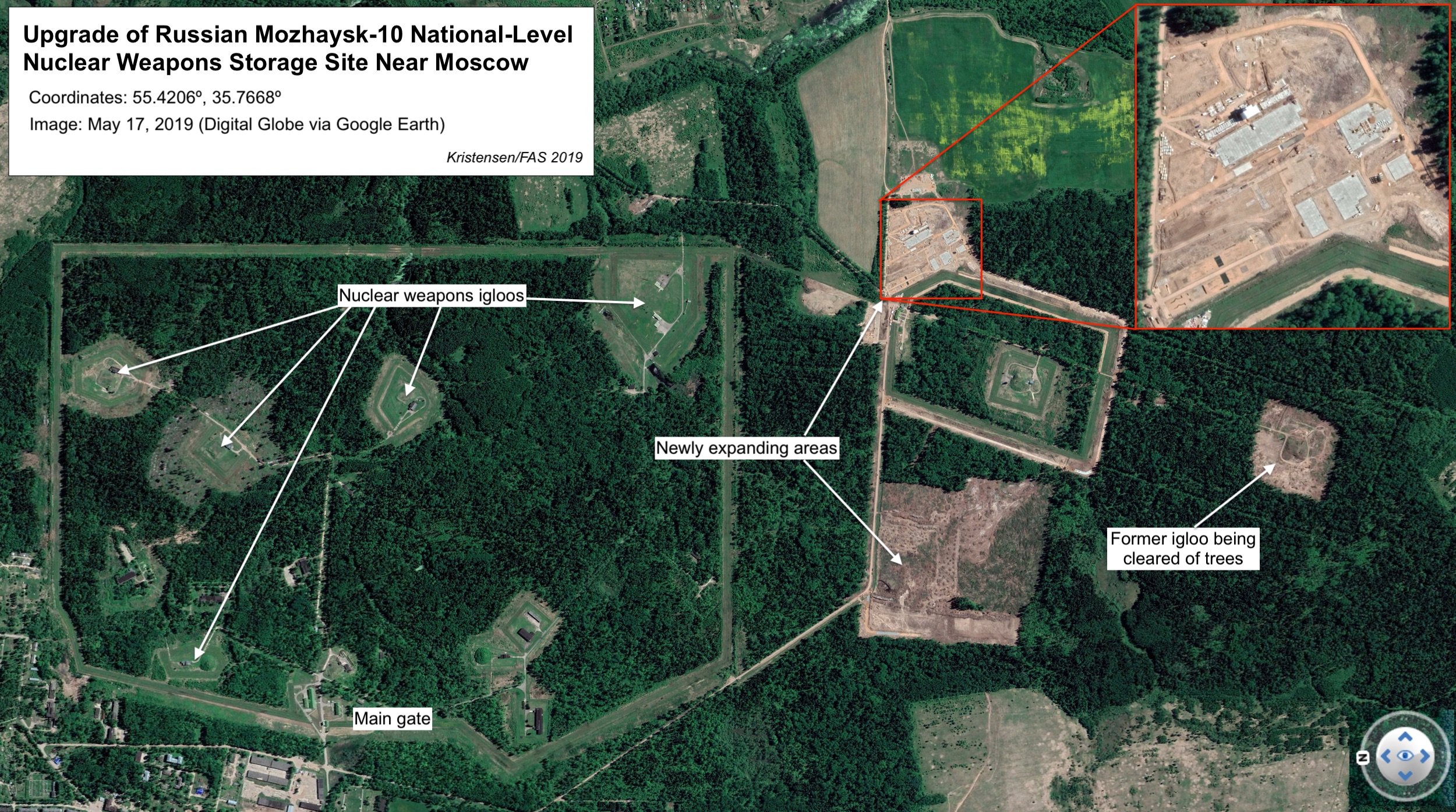NATO Tactical Nuclear Weapons Exercise And Base Upgrades
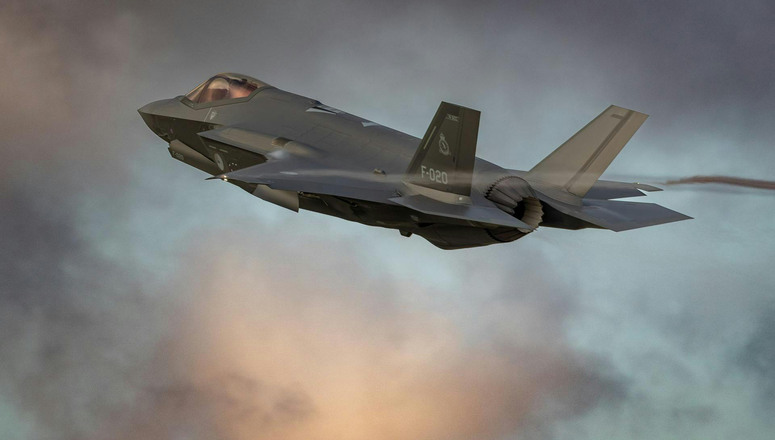
NATO chose to use a Dutch F-35A as illustration in the press release for its tactical nuclear weapons exercise Steadfast Noon.
NATO today began its annual tactical nuclear weapons exercise in Europe. Known as Steadfast Noon, the two-week long exercise involves more than 60 aircraft from 13 countries and more than 2,000 personnel, according to a NATO press release. That is slightly bigger than last year’s exercise that involved “up to 60” aircraft.
The exercise is co-hosted by Belgium and the Netherlands at the Kleine Brogel and Volkel airbases, respectively. Flight operations are focused over the North Sea and surrounding countries including Belgium, Denmark, Germany, the Netherlands, and the United Kingdom. NATO says a total of eight bases are involved.
The NATO press release does not identify the countries or bases that are involved, but an article in Key.Aero previously reported that a NATO spokesperson had identified the following:
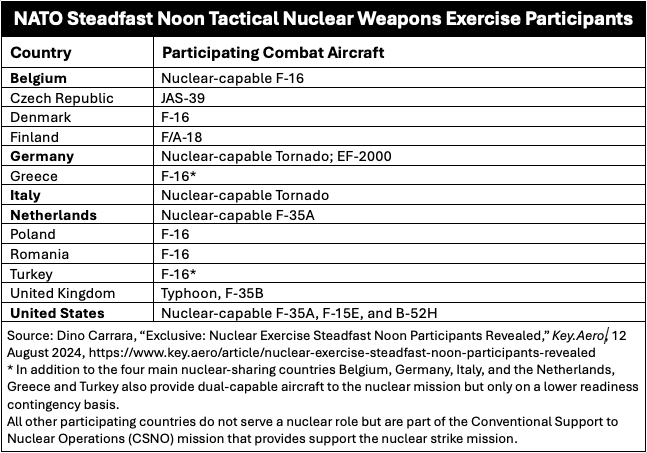
The thirteen countries match the number of participants identified in the NATO press release. Of these, Finland is obviously the most interesting – perhaps surprising – because the former neutral country has chosen to participate in a nuclear exercise only 18 months after it became a member of NATO.
Base Modernizations
The exercise coincides with major upgrades underway at most of the nuclear bases in Europe. This modernization involves security upgrades to the underground vaults that store the U.S. nuclear weapons, underground cables and nuclear command and control systems, and facilities needed for the new F-35A nuclear-capable fighter-bomber.
Several of the nuclear bases in Europe have recently seen construction of a special loading pad for use by the US C-17 aircraft that transport nuclear weapons and service equipment. This includes Kleine Brogel in Belgium, Ghedi in Italy, and Volkel in the Netherlands. The new pads at Ghedi and Volkel have walls to conceal the nuclear weapons transports. In this year’s Steadfast Noon exercise area, Kleine Brogel Air Base in Belgium has undergone extensive upgrades to weapons maintenance facilities, including the US Air Force 701st Munitions Support Squadron (MUNSS) – the unit responsible for the physical security and maintenance of the weapons, as well as for delivering custody of the weapons to the user country’s air forces if directed to do so. This includes a new drive-through facility for nuclear weapons maintenance trucks. In addition, a large tarmac for C-17A nuclear transport aircraft has been added next to the presumed nuclear weapons area, construction of a high-security facility possibly related to nuclear weapons maintenance has been nearly completed, a new control tower has been added, and underground cables and the Alarm Communication & Display (AC&D) system have been upgraded. Much of this was previously visible on satellite images on Google Earth and described by FAS last year, but since then the image has been removed and all images of the base on Google Earth have been blurred to obscure details. In the interest of nuclear transparency, the image is included here:
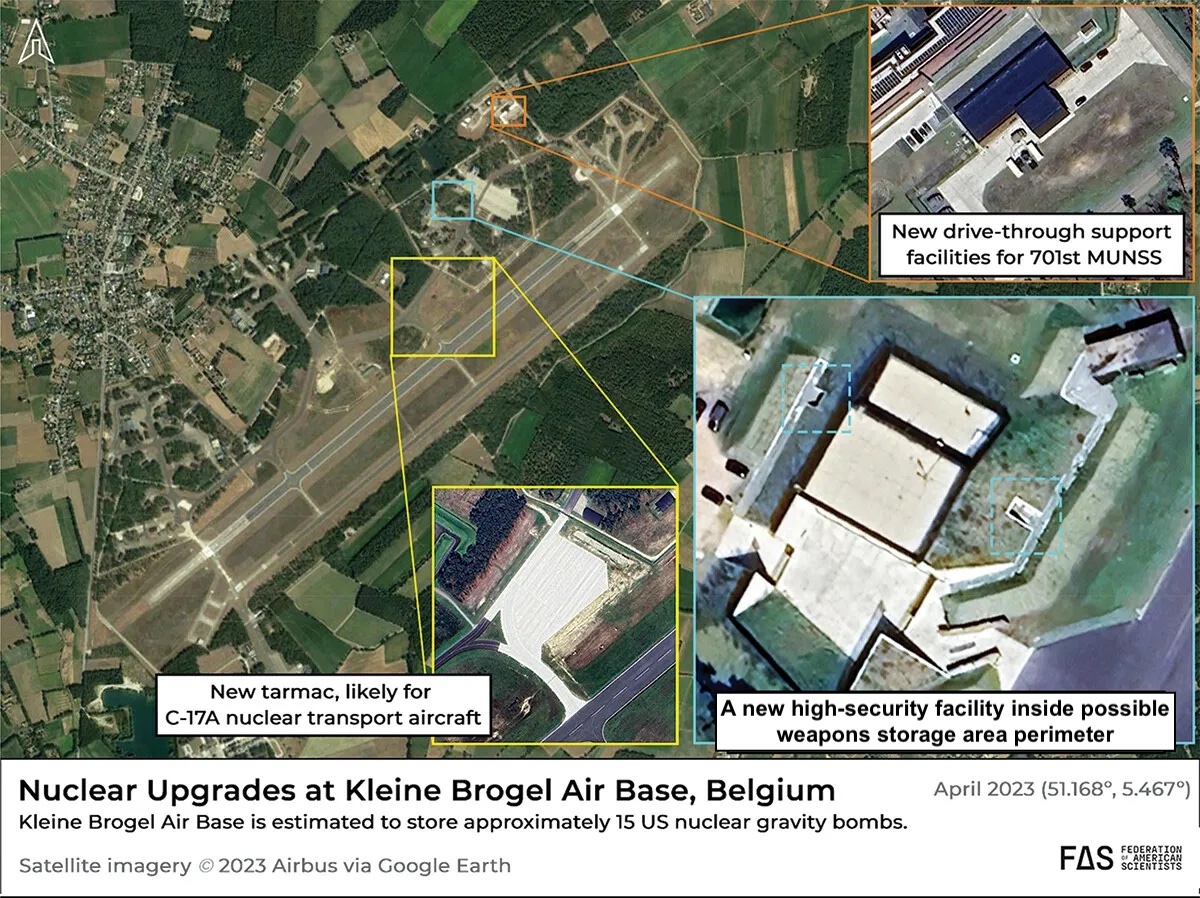
Clear images of Kleine Brogel Air Base are now gone from Google Earth. This one was available last year but has since been removed.
In the Netherlands, Volkel Air Base has gone the extra mile to hide operations by building a wall in front of a parking area where aircraft enthusiasts used to watch and film the aircraft. A spokesperson at the base confirmed the purpose of the new wall: “We believe it is important that personnel can work safely and undisturbed. The visibility-restricting measures make it difficult to photograph operational equipment and air base personnel.” For the first time, this Steadfast Noon exercise will include the Royal Netherlands Air Force’s newly nuclear-certified F-35A fighter-bombers.

Walls have been built at Volkel Air Base to hide weapons loading and prevent the public from observing operations and equipment.
The German base at Büchel is in the middle of a year-long upgrade that includes a service area for the F-35A at the northern end of the base, a refurbished runway, as well as what appears to be a security upgrade of the nuclear weapons area with a possible loading pad for the US C-17 transport aircraft that are used to transport nuclear weapons and limited life components.
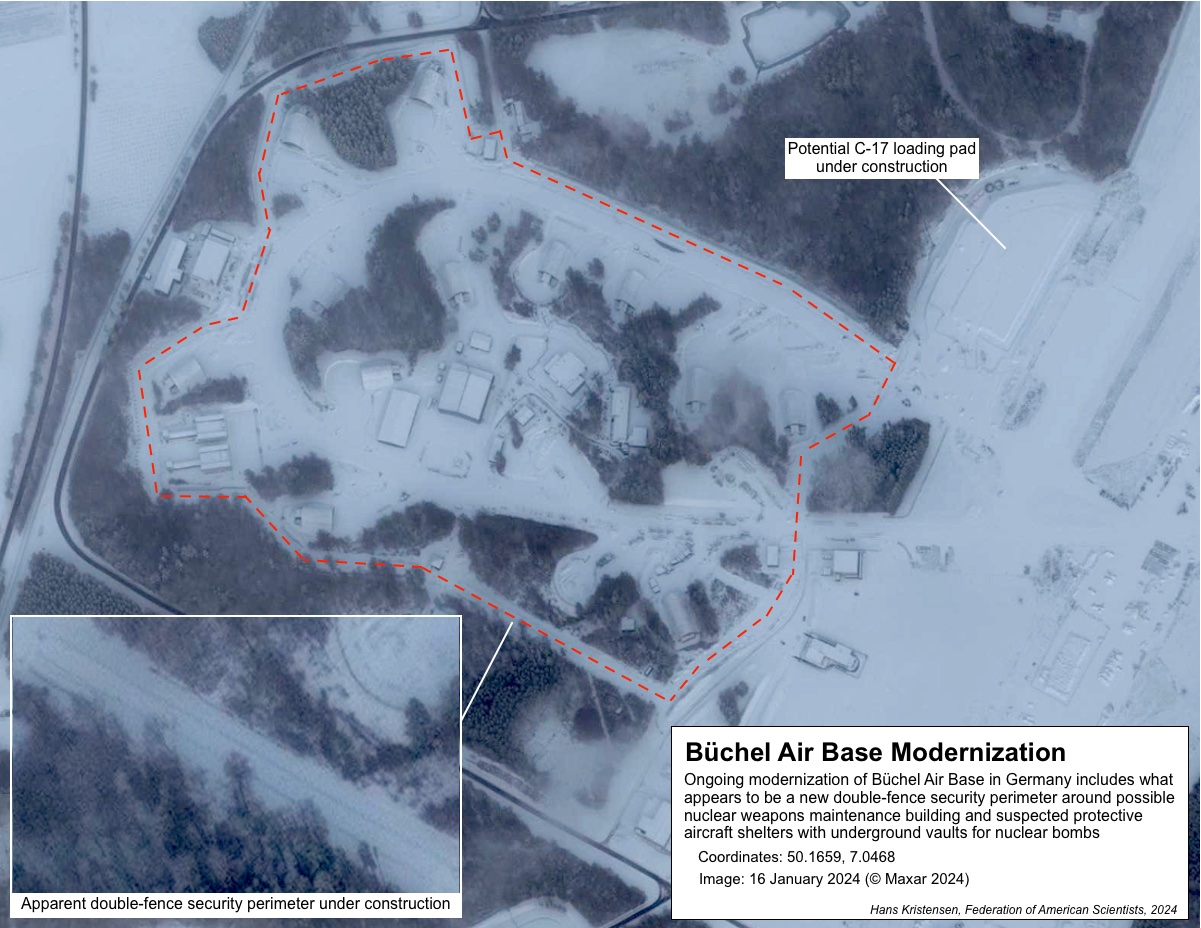
Modernization of Büchel Air Base in Germany appears to include a new double-fenced security perimeter around the nuclear shelters.
Finally, in this year’s Steadfast Noon operating area the most significant new development is the return of the nuclear mission to RAF Lakenheath, the home of the US Air Force 48th Fighter Wing with F-15E and F-35A fighter-bombers. The base previously was a major nuclear base with 33 underground storage vaults and over 100 nuclear bombs; but in the mid-2000s the US Air Force withdrew all the weapons and the nuclear mission was mothballed.
That began to change in 2022 when RAF Lakenheath was quietly added to the list of bases undergoing nuclear upgrades. Although the Pentagon tried to removed evidence of the change, other documents made it clear that the nuclear mission was returning. Satellite images of construction at RAF Lakenheath indicate that approximately 22 of the 33 protective aircraft shelters with underground WS3 vaults are involved in the nuclear upgrade.
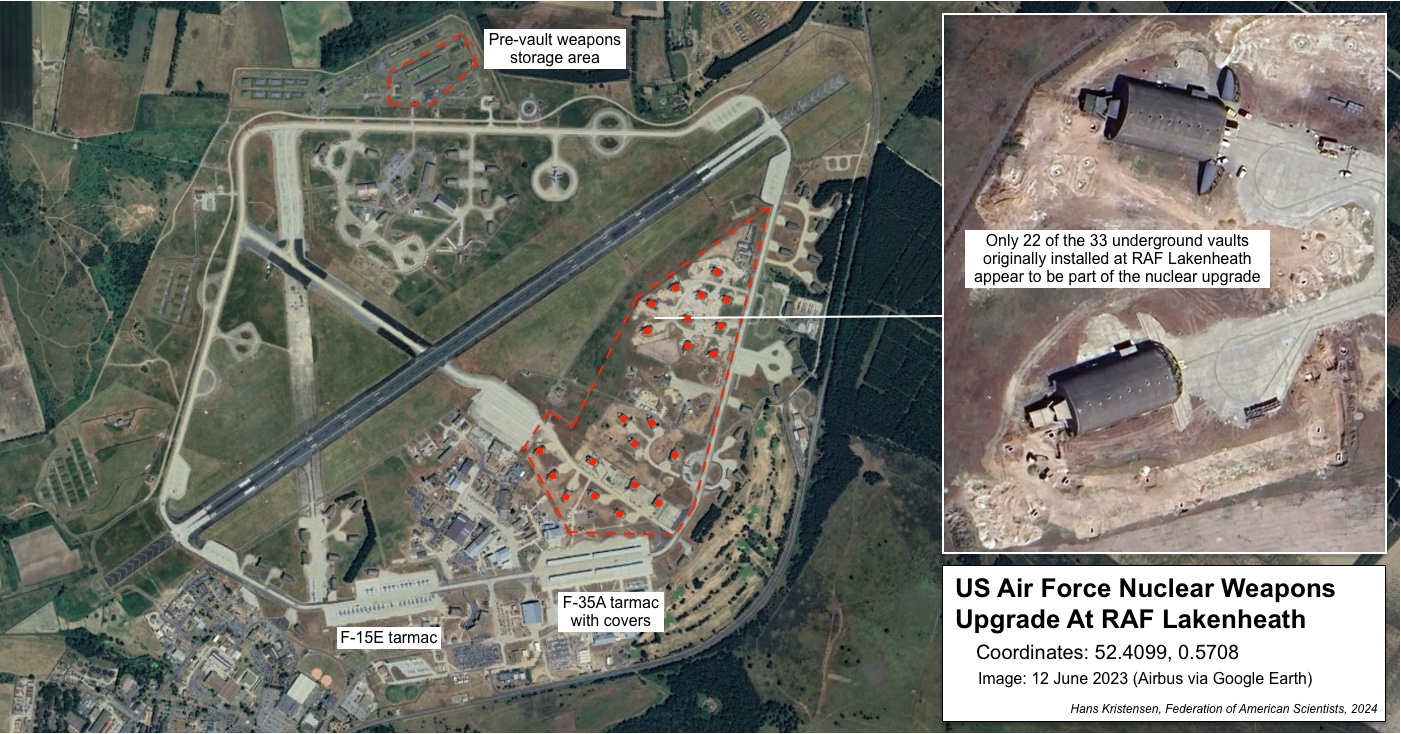
Return of the nuclear mission to RAF Lakenheath appears to include 22 of the original 33 protective aircraft shelters with underground weapons vault.
It is unclear if nuclear weapons will return to RAF Lakenheath or the upgrade is intended as a backup to increase flexibility and reduce vulnerability of the tactical nuclear weapons posture in Europe. After the 2016 coup attempt in Turkey and the policies of the Erdogan government, there has been speculations that the remaining weapons at Incirlik Air Base could be withdrawn; To that end it is interesting that the number of vaults that appear to be readied at RAF Lakenheath is about the same as the numbers remaining active at Incirlik.
Weapons Modernization
In addition to base and aircraft modernizations, the US Air Force is in the process of the replacing the legacy B61-3 and B61-4 tactical nuclear bombs with the new B61-12 guided nuclear bomb. The priority has been to supply the B-2 bombers at Whiteman AFB with the new weapon, but preparations are now underway to ship the B61-12 to bases in Europe and return the B61-3/4 bombs to the United States for dismantlement. The National Nuclear Security Administration (NNSA) reported recently that the B61-12 is technically certified for not only US Air Force fighter-bombers but also certified NATO aircraft (F-16, F-35A, and Tornado).

The B61-12 nuclear bomb is now technically certified on the B-2 bomber and all US and NATO dual-capable fighter aircraft.
It is unknown if the B61-12 has been shipped to Europe. NATO officials have only been willing to say preparations are underway. If so, it is unlikely to go to all bases at the same time or necessarily within a short period of time; Instead, the new weapon will probably replace the old weapons gradually depending on aircraft and base upgrade status.
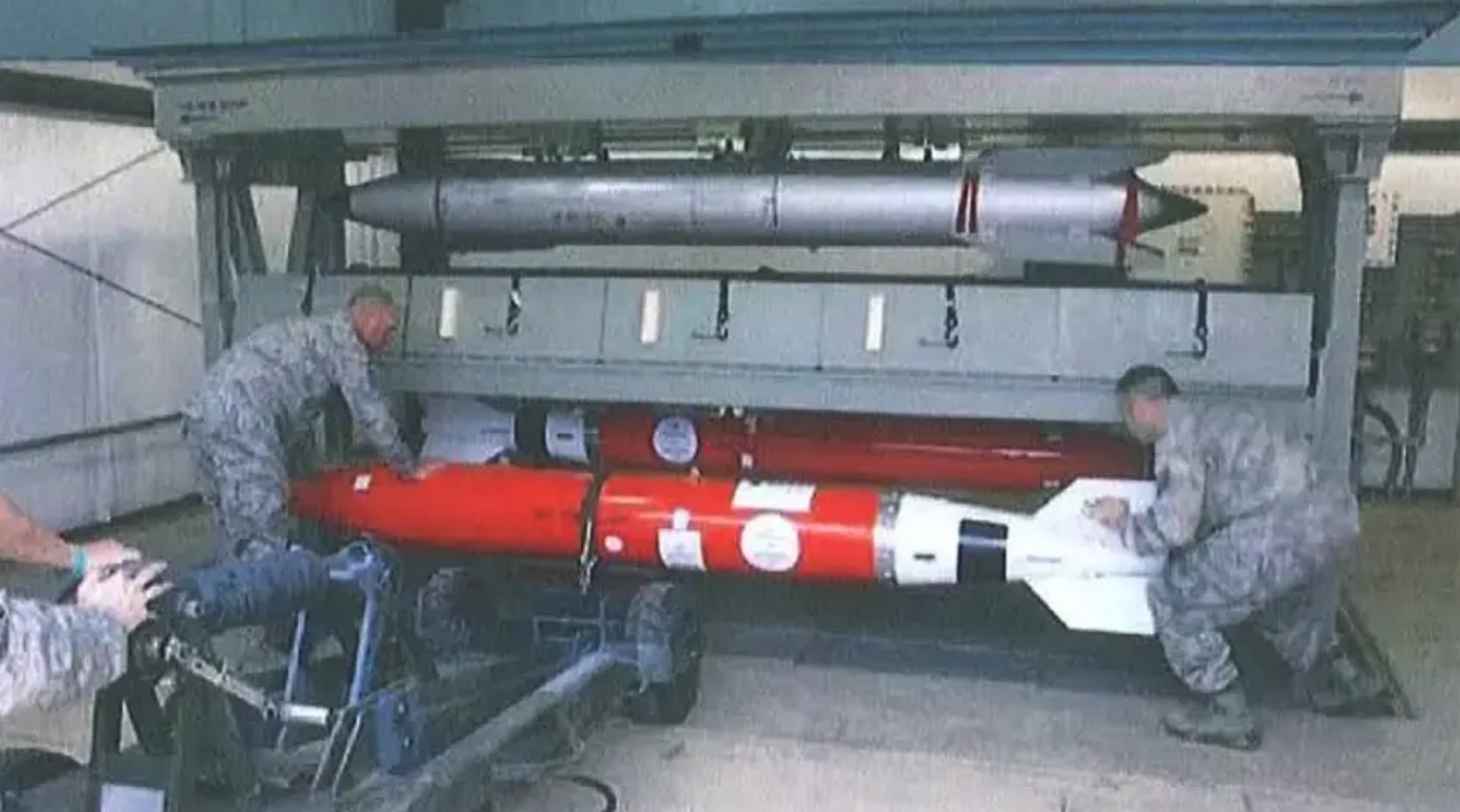
Load training of B61-12 (bottom) and legacy B61-4 (top) in a weapons storage vault of the kind installed at bases in Europe. Each vault can store up to four bombs but normally only have one or two. Image credit: US Air Force via The War Zone.
Our current estimate is that there are roughly 100 B61 nuclear bombs deployed in Europe at six bases in five countries. They constitute a small part of the total US nuclear stockpile of roughly 3,700 nuclear weapons.
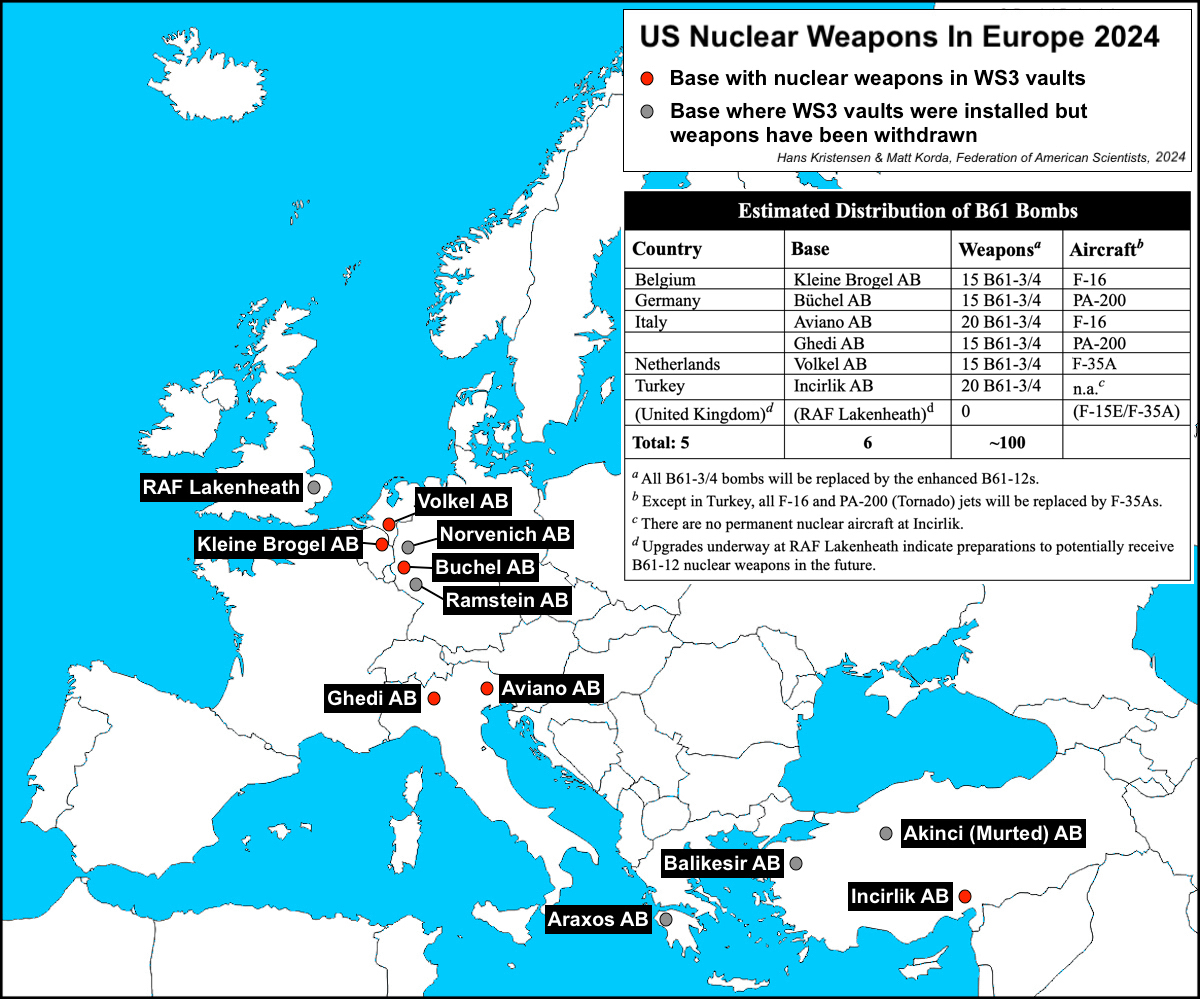
Broader Context
Steadfast Noon is an annual exercise and planning for this one began over a year ago, NATO says. Nonetheless, the two-week long tactical nuclear weapons exercise with over 60 aircraft from 13 countries is taking place during very tense relations with Russia who for nearly three years has waged a brutal full-scale war against Ukraine and issued numerous warnings to NATO about potential use of nuclear weapons.
Earlier this year, Russia held a series of diverse tactical nuclear weapons exercise and distributed pictures and videos to make sure it was noticed in the West. And most recently Russian president Vladimir Putin announced possible changes to Russia’s nuclear doctrine that appeared intended to signal a lower threshold for potential use of nuclear weapons.
In response, some analysts and institutes in the West are advocating for more nuclear weapons and broadening of the nuclear weapons sharing mission to more countries for what they believe is necessary to “strengthen deterrence” against Russia.
The United States has already increased the role and profile of nuclear bombers in support of NATO and US ballistic missile submarines have resumed visits to European ports – one submarine recently surfaced off Norway in a clear nuclear signal. In announcing the start of exercise Steadfast Noon, NATO Secretary General Mark Rutte said that “Steadfast Noon is an important test of the Alliance’s nuclear deterrent and sends a clear message to any adversary that NATO will protect and defend all Allies.” (Emphasis added.)
Combined, these action and reaction steps clearly have raised the nuclear profile over the past several years and are likely to be followed by more. With hardened rhetoric and increased signaling, the salience of nuclear weapons is again growing. Whether this will change the other sides’ behavior for the better or increase nuclear competition and risks even more remains to be seen.
This research was carried out with generous contributions from the Carnegie Corporation of New York, the Joseph Rowntree Charitable Trust, the New-Land Foundation, Ploughshares, the Prospect Hill Foundation, Longview Philanthropy, and individual donors.
Was There a U.S. Nuclear Weapons Accident At a Dutch Air Base? [no, it was training, see update below]
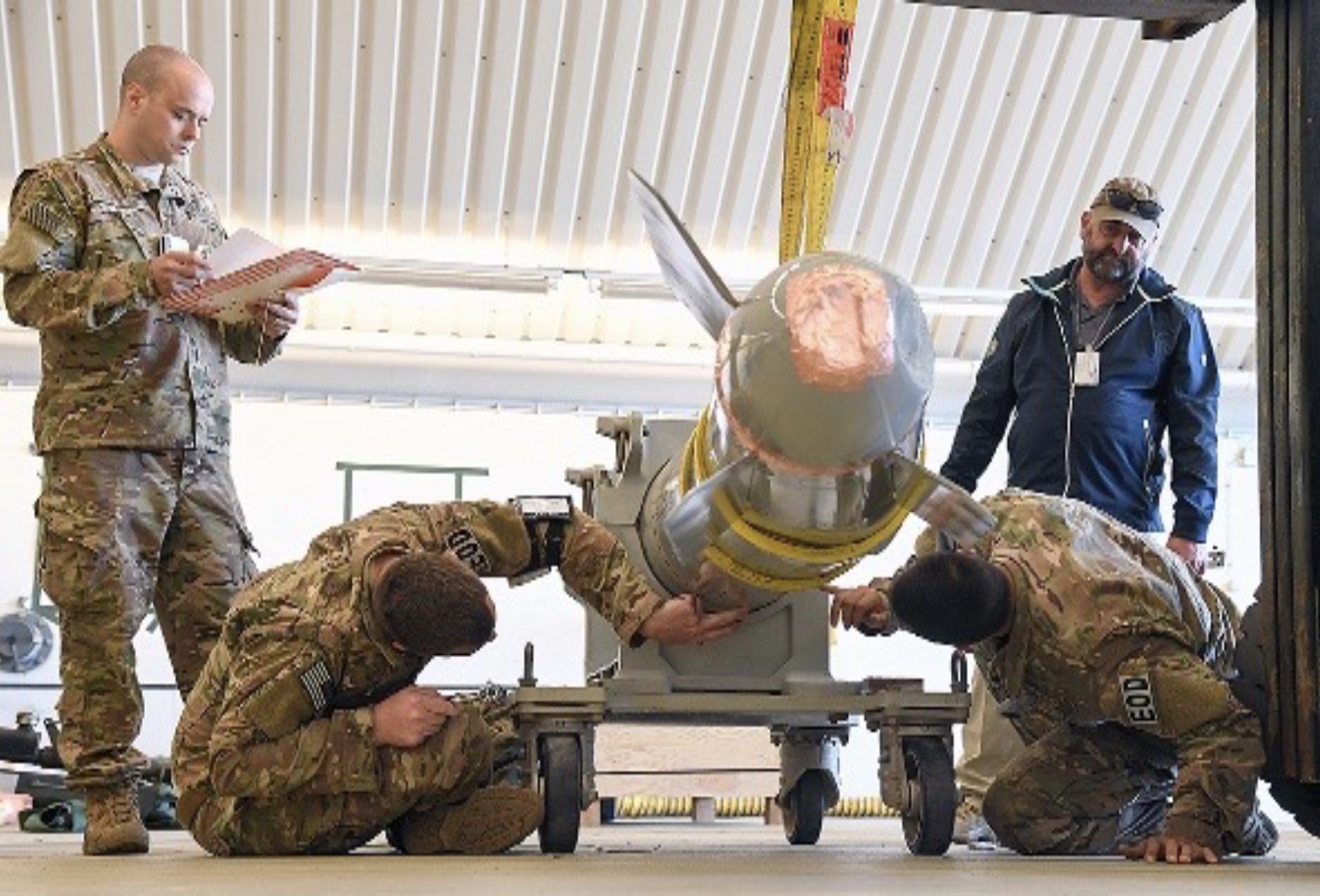
Did the U.S. Air Force suffer a nuclear weapons accident at Volkel Air Base?
Did the U.S. Air Force suffer a nuclear weapons accident at an airbase in Europe a few years back? [Update: After USAFE and LANL initially declined to comment on the picture, a Pentagon spokesperson later clarified that the image is not of an actual nuclear weapons accident but of a training exercise, as cautioned in the second paragraph below. The spokesperson declined to comment on the main conclusion of this article, however, that the image appears to be from inside an aircraft shelter at Volkel Air Base.]
A photo in a Los Alamos National Laboratory (LANL) student briefing from 2022 shows four people inspecting what appears to be a damaged B61 nuclear bomb. The document does not identify where the photo was taken or when, but it appears to be from inside a Protective Aircraft Shelter (PAS) at Volkel Air Base in the Netherlands.
It must be emphasized up front that there is no official confirmation that the image was taken at Volkel Air Base, that the bent B61 shape is a real weapon (versus a trainer), or that the damage was the result of an accident (versus a training simulation).
If the image is indeed from a nuclear weapons accident, it would constitute the first publicly known case of a recent nuclear weapons accident at an airbase in Europe.
Most people would describe a nuclear bomb getting bent as an accident, but U.S. Air Force terminology would likely categorize it as a Bent Spear incident, which is defined as “evident damage to a nuclear weapon or nuclear component that requires major rework, replacement, or examination or re-certification by the Department of Energy.” The U.S. Air Force reserves “accident” for events that involve the destruction or loss of a weapon.
It is not a secret that the U.S. Air Force deploys nuclear weapons in Europe, but it is a secret where they are deployed. Volkel Air Base has stored B61s for decades. I and others have provided ample documentation for this and two former Dutch prime ministers and a defense minister in 2013 even acknowledged the presence of the weapons. Volkel Air Base is one of six air bases in Europe where the U.S. Air Force currently deploys an estimated 100 B61 nuclear bombs in total.
The United States is modernizing its air-delivered nuclear arsenal including in Europe and Volkel and the other air bases in Europe are scheduled to receive the new B61-12 nuclear bomb in the near future.
Image Description
What does the image itself show? It appears to show a damaged B61 nuclear bomb shape strapped to a four-wheel trolly. The rear of the bomb curves significantly to the left and one of four tail fins is missing. There is also pink tape covering possible damage to the rear of the tail. The image first (to my knowledge) appeared in a Los Alamos National Laboratory student briefing published last year that among other topics described the mission of the Accident Response Group (ARG) to provide “world-wide support to the Department of Defense (DoD) in resolving incidents and accidents involving nuclear weapons or components in DoD custody at the time of the event.”
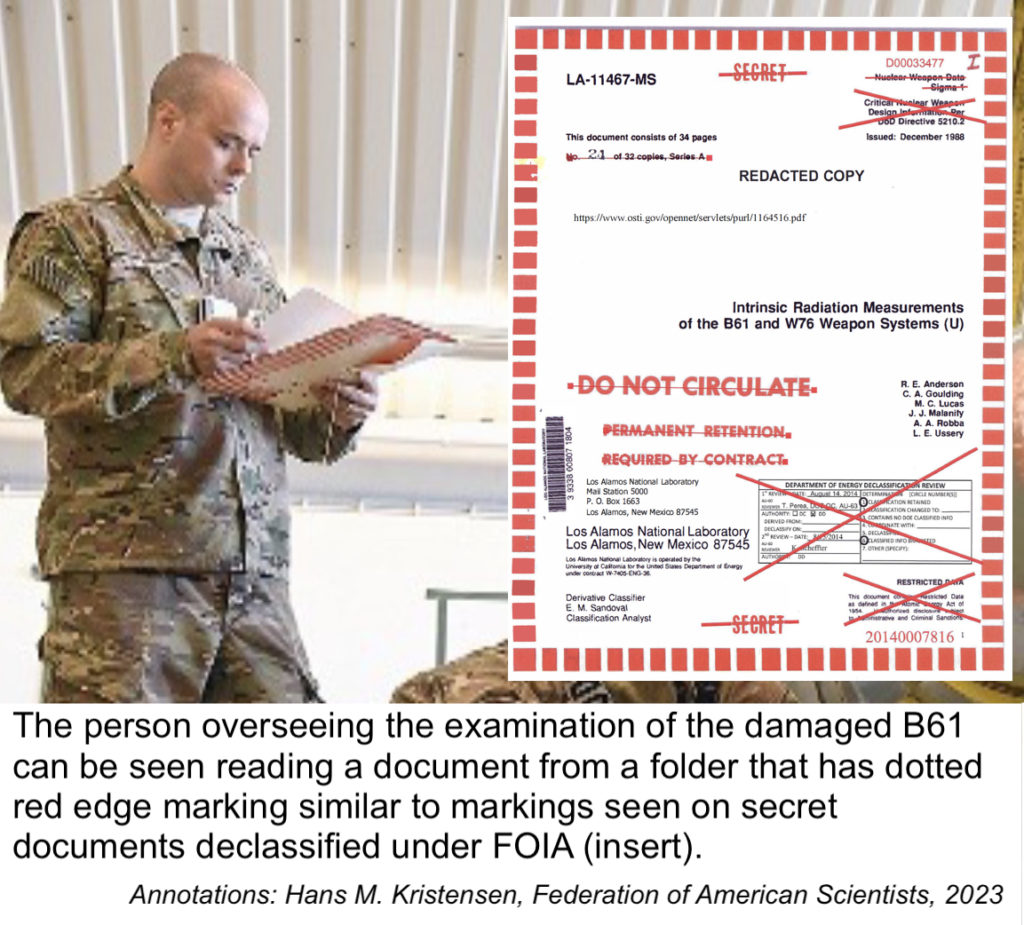
The personnel in the image also tell a story. The two individuals on the floor who appear to be inspecting the exterior damage on the weapon have shoulder pads with the letters EOD, indicating they probably are Explosive Ordnance Disposal personnel. According to the U.S. Air Force, “EOD members apply classified techniques and special procedures to lessen or totally remove the hazards created by the presence of unexploded ordnance. This includes conventional military ordnance, criminal and terrorist homemade items, and chemical, biological and nuclear weapons.”
The person to the left overseeing the operation appears to be holding a folder with red dotted color markings that are similar to color patterns seen on classified documents that have been declassified and released under the Freedom of Information Act (FOIA) (see image to the right). The civilian to the right is possibly from one of the nuclear weapons laboratories. Los Alamos and Sandia both produced components to the B61 bomb.
What caused the damage to the B61 shape is unknown, but it appears to have been a significant force. It could potentially have been hit by a vehicle or bent out of shape by the weapons elevator of the underground storage vault.
Photo Geolocation
There is nothing in the photo itself or the document in which it was published that identify the location, the weapon, when it happened, or what happened. I have searched for the photo in search engines but nothing comes up. However, other photos taken inside Protective Aircraft Shelters (PASs) at Volkel Air Base show features that appear to match those seen in the accident photo.
One of those photos is from April 2022 (the same month the Los Alamos briefing was published), when Dutch princess Catharina-Amalia visited Volkel Air Base and was taken on a flight in one of the F-16s. The Dutch Air Force commander highlighted the visit in a tweet that includes several photos, including one from inside an aircraft shelter. The photo shows the princess with Dutch air force officials including what appear to be the head of the Dutch air force and the commander of the nuclear-tasked 312th squadron at Volkel, an F-16 fighter-bomber, and part of the lid of an underground Weapons Storage System (WS3) vault built to store B61 nuclear bombs (see image below).
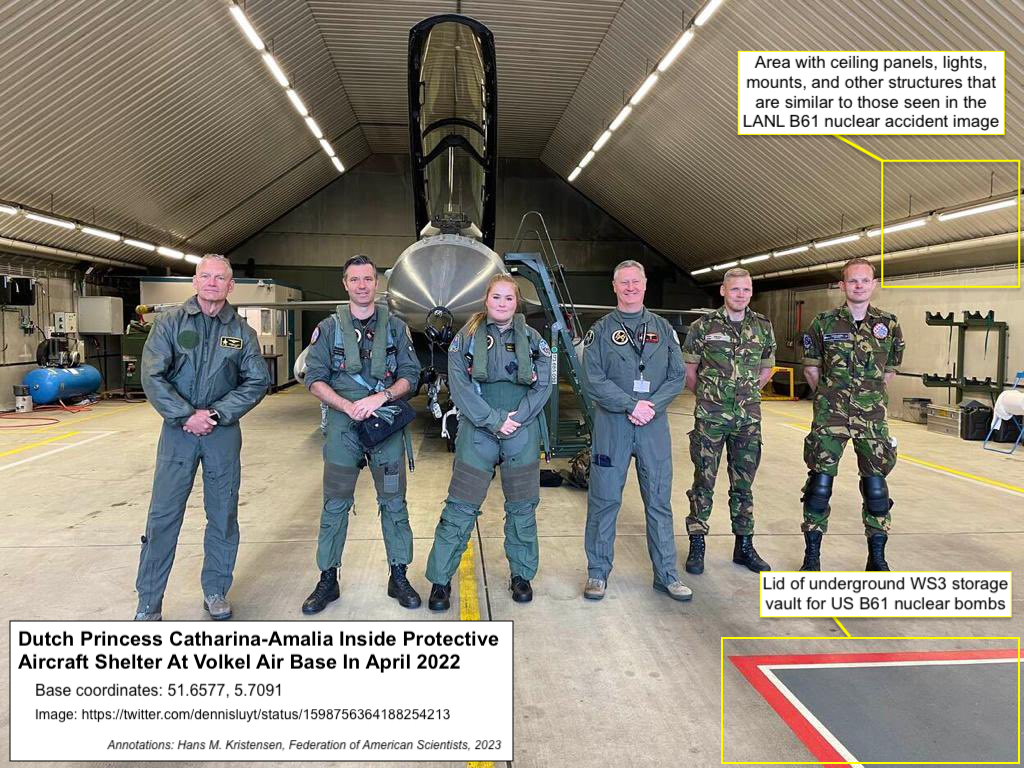
The 312th Squadron is part of the Dutch Air Force’s 1st Wing and is equipped with F-16 fighter-bombers with U.S.-supplied hardware and software that make them capable of delivering B61 nuclear bombs that the U.S. Air Force stores in vaults built underneath 11 of the shelters at the base. Dutch pilots receive training to deliver the weapons and the unit is inspected and certified by U.S. and NATO agencies to ensure that they have the skills to employ the bombs if necessary. In peacetime, the bombs are controlled by personnel from the U.S. Air Force’s 703rd Munition Support Squadron (MUNSS) at the base. If the U.S. military recommended using the weapons – and the U.S. president agreed and authorized use, the U.K. Prime Minister agreed as well, and NATO’s Nuclear Planning Group (NPG) approved – then the weapon would be loaded onto a Dutch F-16 and the strike carried out by a Dutch pilot. Such an operation was rehearsed by the Steadfast Noon exercise in October last year.
One of these pilots (presumably), the commander of the 312th squadron, appeared in a Dutch Air Force video published in February on the one-year anniversary of the (second) Russian invasion of Ukraine. In the video, the commander climbs into the F-16 and puts on his helmet. At first a visor cover can be seen showing an orange-yellow mushroom cloud illustrating a nuclear explosion. However, when the video cuts and the commander turns to face the camera, the nuclear mushroom cloud cover is gone, presumably to avoid sending the wrong message to Russia (see below). The nuclear mushroom visor cover was also seen during the NATO Steadfast Noon exercise at Volkel AB in 2011.

These pictures and videos show features that indicate the B61 nuclear bomb accident picture is from Volkel Air Base. Unlike aircraft shelters at other nuclear bases in Europe, the Dutch shelters have ceilings made up of three flat surfaces: the two sides and the top. The surfaces include unique light fixtures and meet the side walls with unique pipes and grids. Moreover, the shelter wall has a gray structure outline that is very similar to one seen in the video. These different matching features are highlighted in the image below.
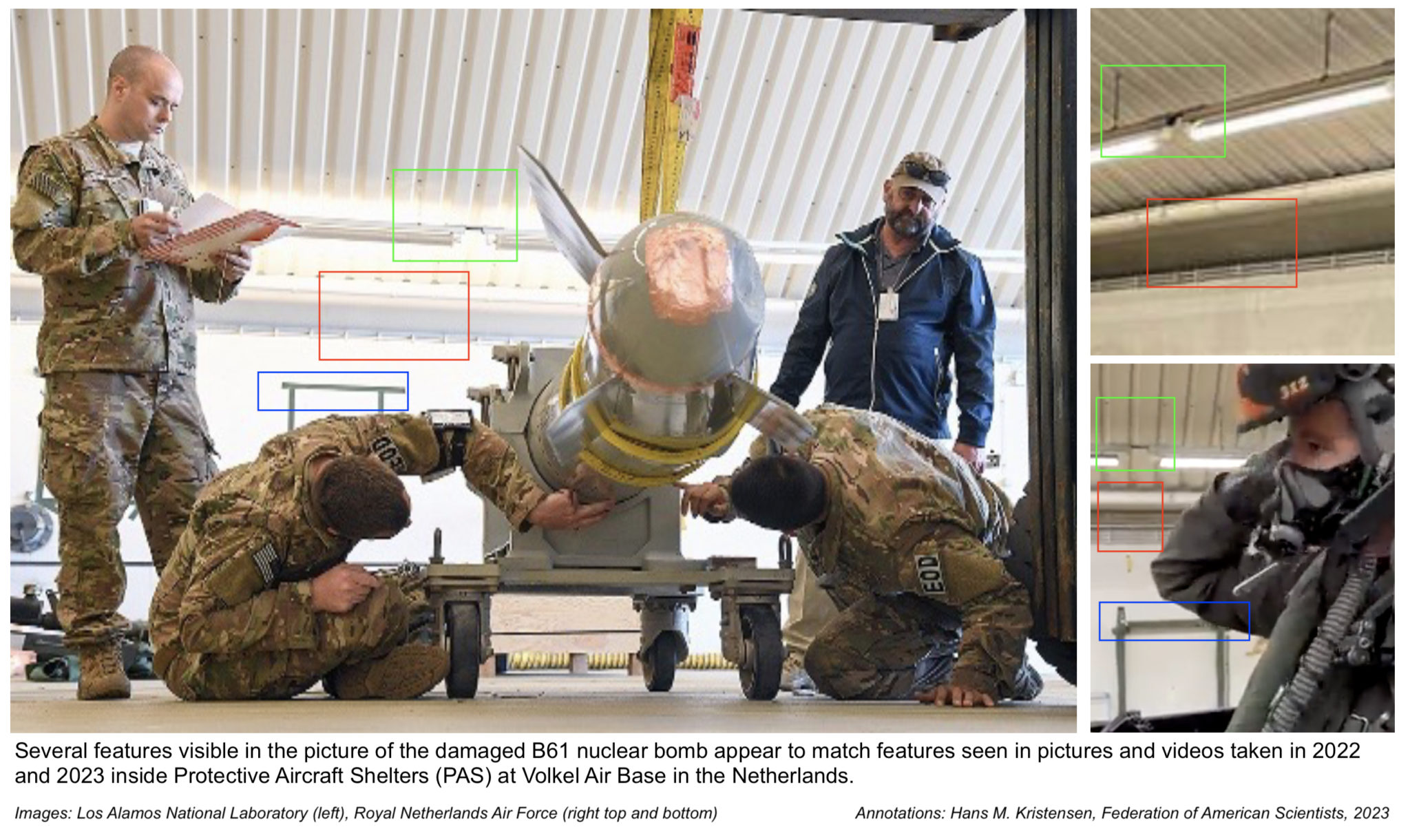
Nuclear Accident Management
Nuclear weapon designs such as the B61 are required to be “one-point safe,” which means the weapon must have a probability of less than one in one million of producing a nuclear yield if the chemical high explosives detonate from a single point. But if the weapon is not intact, such as during maintenance work inside a truck inside an aircraft shelter, a U.S. Air Force safety review discovered in 1997 – nearly three decades after the one-point safety requirement was established – that “nuclear detonation may occur” during a lightning storm. Improved lightning protection was quickly installed.
Management of accidents and incidents involving U.S. nuclear weapons at foreign bases is carried out in accordance with national and bilateral arrangements. The United States has held that the 1954 Status of Forces Agreement (SOFA) relating to the stationing of U.S. armed forces in the Netherlands was sufficient for regulating , but the Dutch government has been pressing for greater consultation in the Netherlands United States Operational Group (NUSOG), a special bilateral a coordinating body established to develop and manage U.S. nuclear weapons accident response plans, procedures, training, and exercises. Disclosure of a dispute in 2008-2009 once more confirmed the presence of nuclear weapons in the Netherlands.
Although nuclear detonation from an accident is unlikely, detonation of the chemical high explosives in the weapon would likely scatter plutonium and other radioactive materials. An accident inside a vault or shelter potentially would have local effect, while pollution from the crash of a C-17A cargo aircraft carrying several weapons could be a lot more extensive. A picture published by the Los Alamos National Laboratory in 2020 indicates that a single C-17A can carry at least 30 B61 nuclear bombs (see image below). That means that all the 10-15 B61 bombs estimated to be stored at Volkel Air Base could be moved in just one flight.
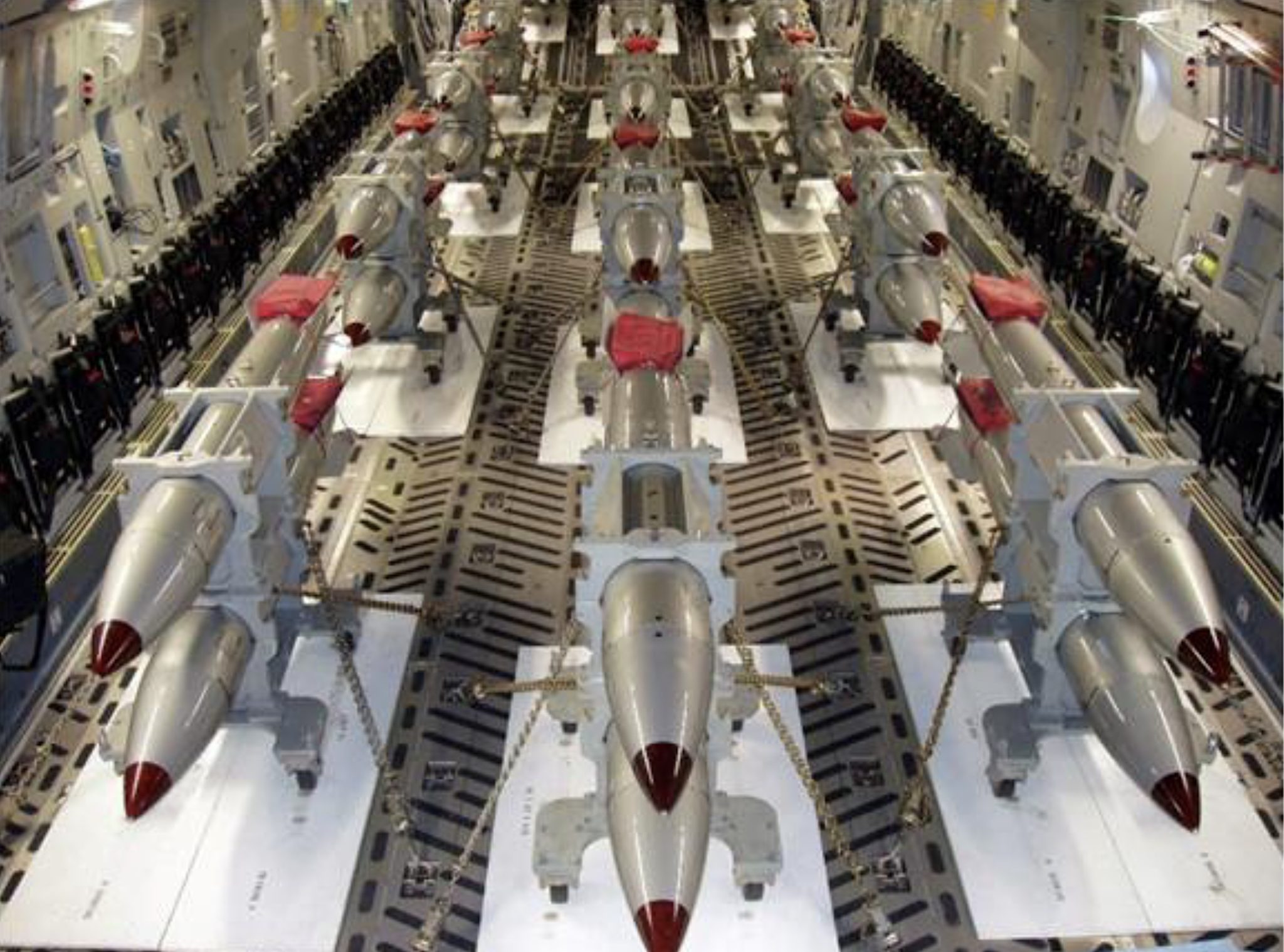
Background information:
FAS Nuclear Notebook: US Nuclear weapons, 2023
NATO Steadfast Noon Exercise and Nuclear Modernization in Europe
The C-17A Has Been Cleared To Transport B61-12 Nuclear Bomb To Europe
Lakenheath Air Base Added To Nuclear Weapons Storage Site Upgrades
This research was carried out with generous contributions from the John D. and Catherine T. MacArthur Foundation, the New-Land Foundation, Ploughshares Fund, the Prospect Hill Foundation, Longview Philanthropy, the Stewart R. Mott Foundation, the Future of Life Institute, Open Philanthropy, and individual donors.
The C-17A Has Been Cleared To Transport B61-12 Nuclear Bomb To Europe
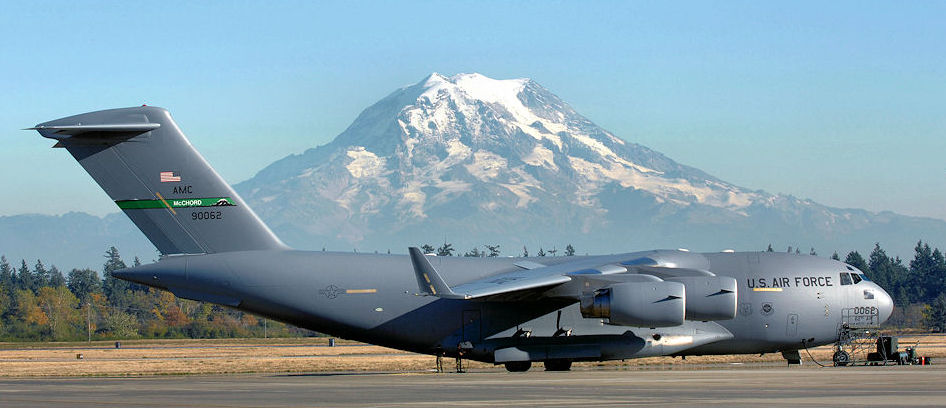
C-17As of the 62nd Airlift Wing at Joint Base Lewis-McChord near Seattle have been cleared to transport new B61-12 nuclear bomb.
In November 2022, the Air Force updated its safety rules for airlift of nuclear weapons to allow the C-17A Globemaster III aircraft to transport the new B61-12 nuclear bomb.
The update, accompanied by training and certification of the aircraft and crews, cleared the C-17A to transport the newest U.S. nuclear weapon to bases in the United States and Europe.
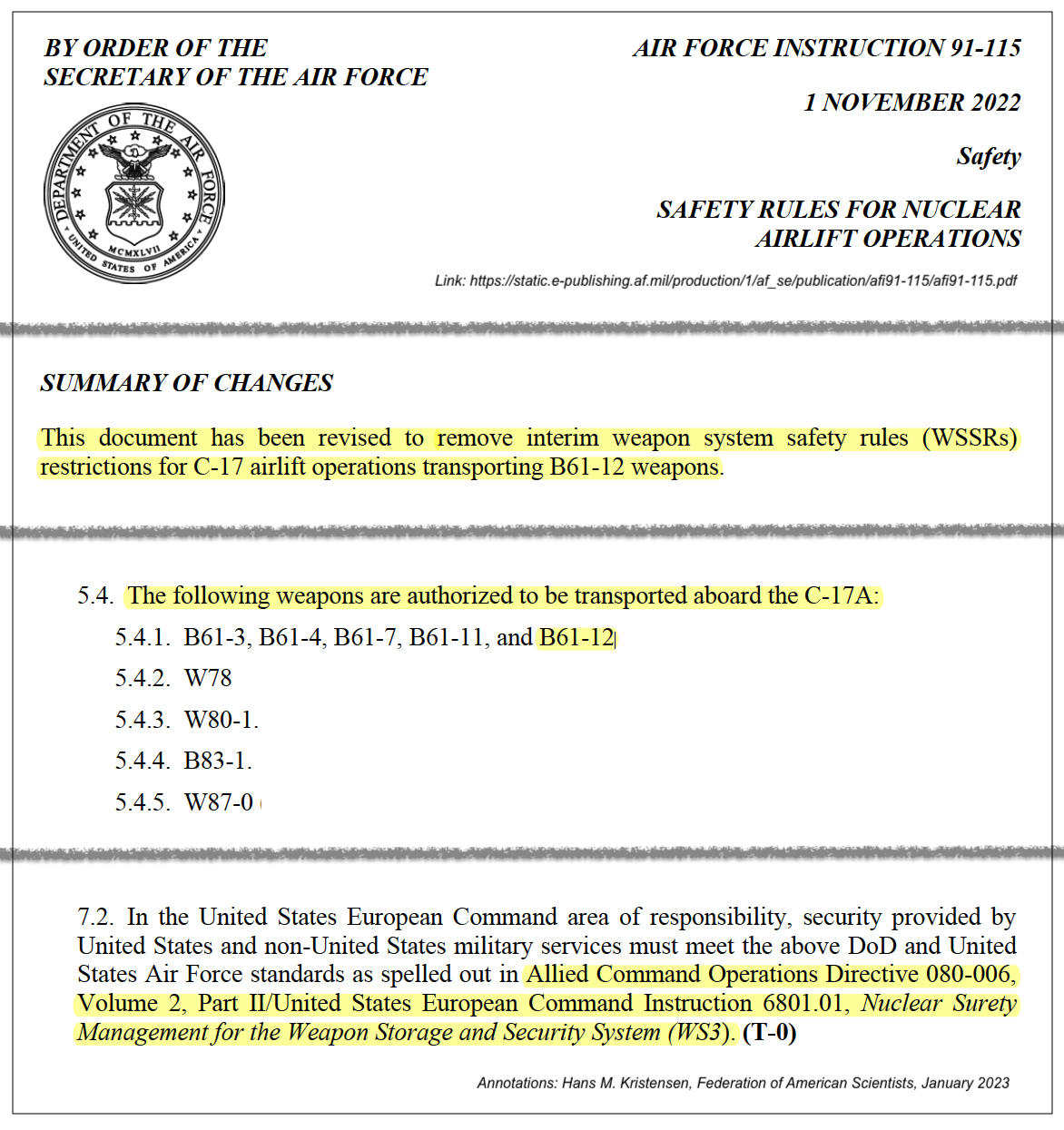
An updated USAF Instruction in November 2022 removed restrictions for C-17A transport of the new B61-12 nuclear bomb to bases in the United States and Europe.
The C-17As of the 62nd Airlift Wing at Joint Base Lewis-McChord serve as the Prime Nuclear Airlift Force (PNAF), the only airlift wing that is authorized to transport the Air Force’s nuclear warheads.
The updated Air Force instruction does not, as inaccurately suggested by some, confirm that shipping of the weapons began in December. But it documents some of the preparations needed to do so.
Politico reported in October last year that the US had accelerated deployment of the B61-12 from Spring 2023 to December 2022. Two unnamed US officials said the US told NATO about the schedule in October.
But a senior Pentagon official subsequently dismissed the Politico report, saying “nothing has changed on the timeline. There is no speeding up because of any Ukraine crisis, the B61-12 is on the same schedule it’s always been on.”
Although the DOD official denied there had been a change in the schedule, he did not deny that transport would begin in December.
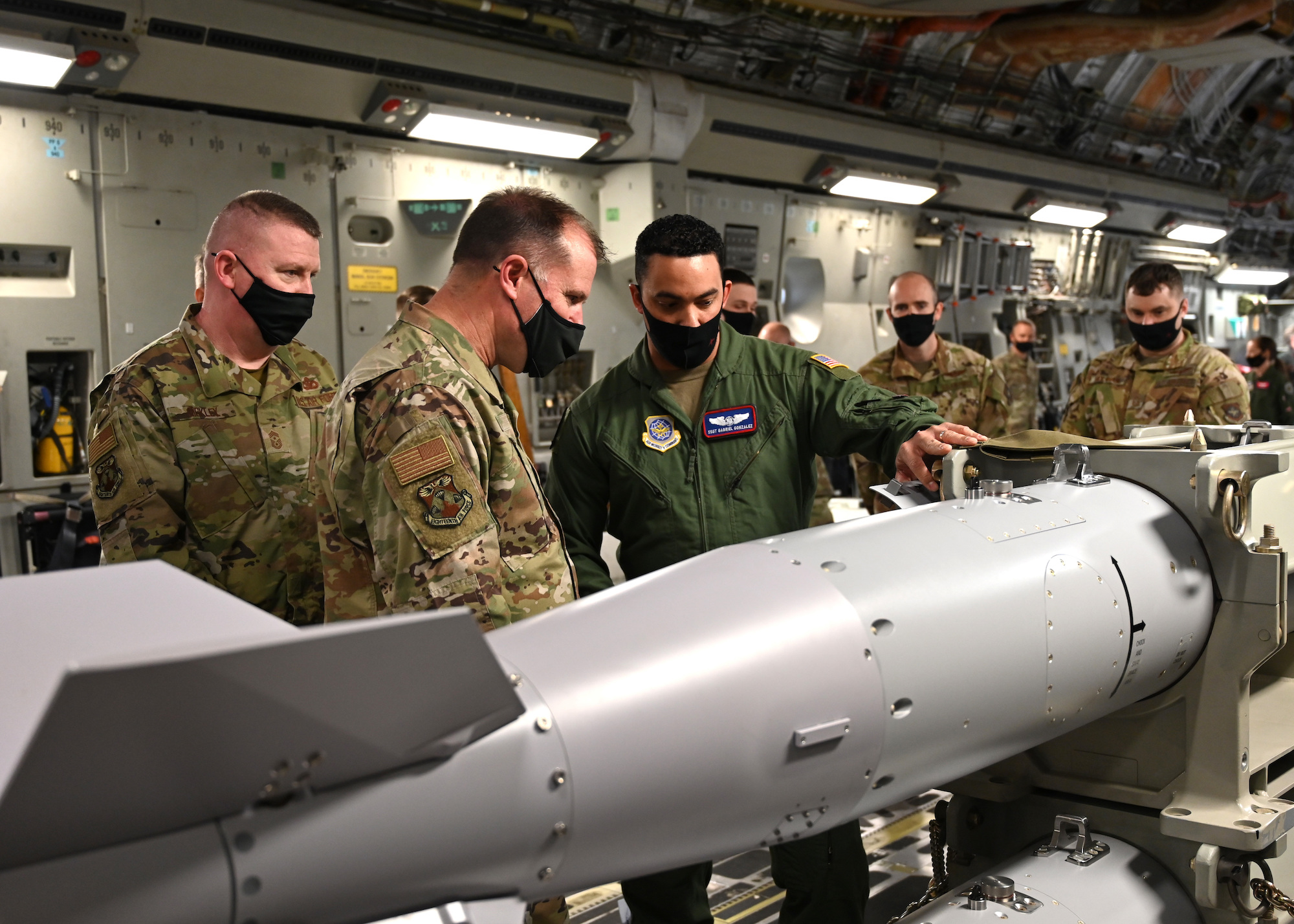
Two unarmed B61-12 trainers are loaded on a C-17A during an exercise at Joint Base Lewis-McChord AFB in April 2021. Image: U.S. Air Force.
The B61-12 production scheduled had slipped repeatedly. Initially, the plan was to begin full-scale production in early-2019. By September 2022, the National Nuclear Security Administration (NNSA) was still awaiting approval to begin full-scale production. Finally, in October 2022, NNSA confirmed to FAS that the B61-12 was in full-scale production.
The B61-12 is intended as an upgrade and eventual replacement for all current nuclear gravity bombs, including the B61-3, -4, -7, and probably eventually also the B61-11 and B83-1. To that end, it combines and improves upon various aspects of existing bombs: it uses a modified version of the B61-4 warhead with several lower- and medium-yield options (0.3-50 kilotons). It compensates for its smaller explosive yield (relative to the maximum yields of the B61-7 and -11) by including a guided tail-kit to increase accuracy, as well as a limited earth-penetration capability.
At this point in time, it is unknown if B61-12 shipments to Europe have begun. If not, it appears to be imminent. That said, deployment will probably not happen in one move but gradually spread to more and more bases depending on certification and construction at each base.
There are currently six active bases in five European countries with about 100 B61 bombs present in underground Weapons Storage and Security Systems (WS3) inside aircraft shelters. A seventh site in Germany (Ramstein Air Base) is active without weapons present and an eighth site – RAF Lakenheath – has recently been added to the list of WS3 sites being modernized. The revitalization of Lakenheath’s nuclear storage bunkers does not necessarily indicate that US nuclear weapons will return to UK soil, especially since as recently as December 2021, NATO’s Secretary General stated that “we have no plans of stationing any nuclear weapons in any other countries than we already have . . . ” However, the upgrade could be intended to increase NATO’s ability to redistribute the B61 bombs in times of heightened tensions, or to potentially move them out of Turkey in the future. In addition, four other sites have inactive (possibly mothballed) vaults (see map below).
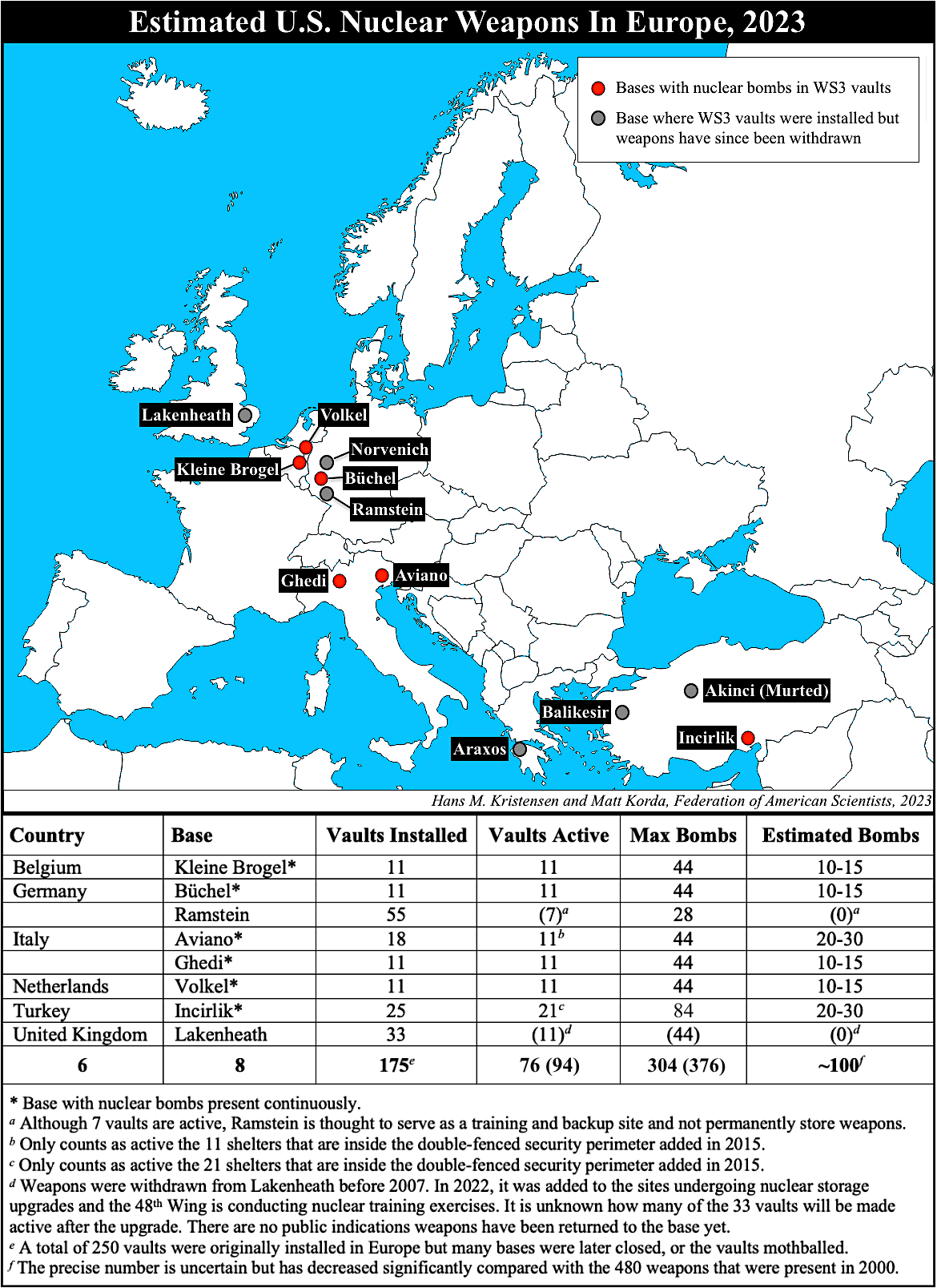
This research was carried out with generous contributions from the John D. and Catherine T. MacArthur Foundation, the New-Land Foundation, the Ploughshares Fund, the Prospect Hill Foundation, Longview Philanthropy, the Stewart R. Mott Foundation, the Future of Life Institute, Open Philanthropy, and individual donors.
NATO Steadfast Noon Exercise And Nuclear Modernization in Europe
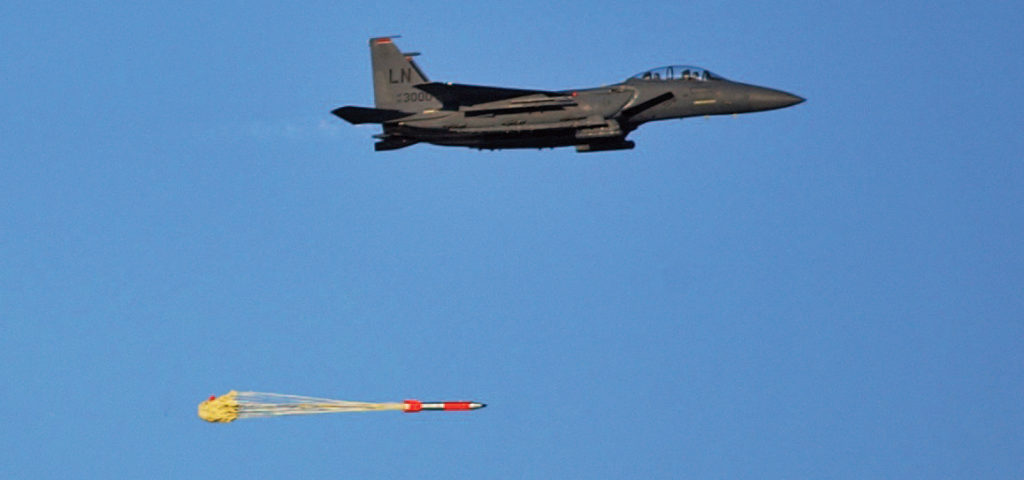
The Steadfast Noon exercise will practice employment of non-strategic nuclear weapons, like this unarmed B61-4 nuclear gravity bomb dropped by an F-15E from the 48th Fighter Wing at RAF Lakenheath. Image: Sandia National Laboratories.
[Updated version] Today, Monday October 17, 2022, the North Atlantic Treaty Organization (NATO) will begin a two-week long exercise in Europe to train aircrews in using U.S. non-strategic nuclear bombs. The exercise, known as Steadfast Noon, is centered at Kleine Brogel Air Base in Belgium, one of six airbases in Europe that store U.S. nuclear bombs. The exercise takes place midst significant modernizations at nuclear bases across Europe.
Steadfast Noon exercises are held once every year, but this year is unique because the exercise will take place during the largest conventional war in Europe since World War II with considerable tension and uncertainty resulting from Russia’s war in Ukraine. Moreover, Steadfast Noon is expected to more or less coincide with a large Russian strategic nuclear exercise. For NATO officials, other than Putin’s war in Ukraine, this is all routine. But for the public, it is but the latest development in rising tensions and unprecedented fears about nuclear war.
According to NATO, Steadfast Noon will involve 14 countries (less than half of the 30 NATO allies) and up to 60 aircraft. That involves fourth-generation F-16s and F-15Es as well as fifth-generation F-35A and F-22 fighter jets. A number of tankers and surveillance aircraft will also take part. Although the exercise is practicing NATO’s non-strategic nuclear forces, a couple of U.S. strategic B-52 bombers will also participate. Training flights will take place over Belgium and the United Kingdom as well as over the North Sea. There might also be flights over Germany and the Netherlands.
Practicing Nuclear Bomb Sharing
The Steadfast Noon exercise will practice a controversial arrangement known as nuclear sharing, under which the United States installs nuclear equipment on fighter jets of select non-nuclear NATO countries and train their pilots to carry out nuclear strike with U.S. nuclear bombs.
The arrangement is controversial because the United States as a party to the nuclear Non-Proliferation Treaty (NPT) has promised not to hand over nuclear weapons to other countries, and the non-nuclear countries in the sharing arrangement have promised not to receive nuclear weapons from the nuclear weapon states. In peacetime the nuclear weapons are under U.S. control, but the arrangement means that they would be handed over to the non-nuclear country in war time. The arrangement was in place before the NPT was signed so it is not a violation of the letter of the treaty. But it can be said to violate the spirit and has been an irritant for years.
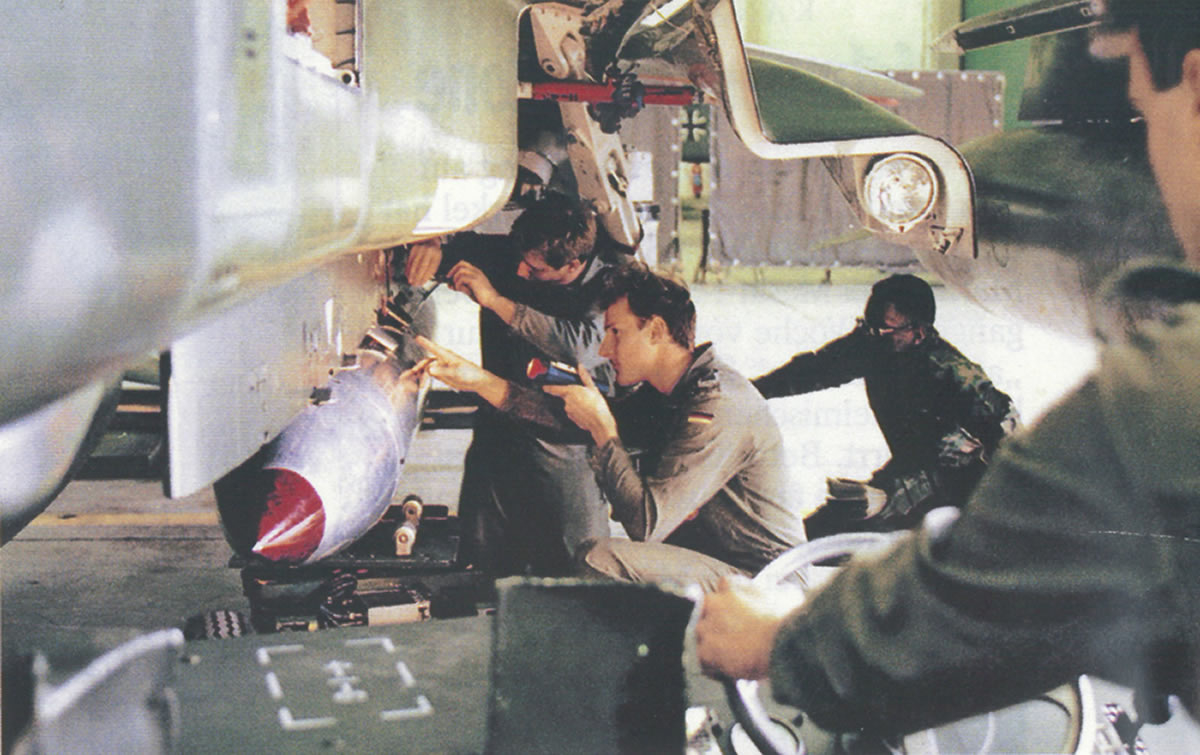
Under supervision by U.S. Air Force personnel, German Air Force personnel is practicing loading of a U.S. B61-4 nuclear bomb shape on a German Tornado fighter jet. In a war, German pilots could be given control of U.S. nuclear bombs. Image: Der Spiegel.
“If NATO was to conduct a nuclear mission in a conflict,” NATO says, “the B-61 [sic] weapons would be carried by certified Allied aircraft…However, a nuclear mission can only be undertaken after explicit political approval is given by NATO’s Nuclear Planning Group (NPG) and authorisation is received from the US President and UK Prime Minister.” It is unclear why the U.K. Prime Minister would have to authorize employment of U.S. nuclear weapons, and unless NATO territory had been attacked with nuclear weapons first, it seems unlikely that the 29 countries in the NPG would be able to agree to approve of employment of non-strategic nuclear weapons from bases in Europe.
NATO disclosed earlier this year that seven NATO countries contribute dual-capable aircraft to the nuclear sharing mission. The countries were not identified but five are widely known: Belgium, Germany, Italy, Netherlands, and the United States. The sixth country is probably Turkey (despite rumors that it was no longer part of the mission), in which case some Turkish F-16s are still equipped to deliver B61 bombs. The seventh country was a mystery, but it turns out it is Greece. Although Greece no longer stores nuclear weapons (they were withdrawn in 2001) and doesn’t have a committed fighter unit, it has a reserve units and a contingency mission. Like other allies (except France), Greece is fully involved in the NPG.]
Nuclear Base Modernizations
During the past several years, the nuclear bases and the infrastructure that support the nuclear sharing mission in Europe have been undergoing significant upgrades, including cables, command and control systems, weapons maintenance and custodial facilities, security perimeters, and runway and tarmac areas.
There are currently six active sites in Europe that store U.S. nuclear bombs: Kleine Brogel air base in Belgium, Büchel air base in Germany, Aviano and Ghedi air bases in Italy, Volkel air base in the Netherlands, and possibly Incirlik in Turkey. The estimated number of weapons at each site is based on the number of active vaults, aircraft, and other information.
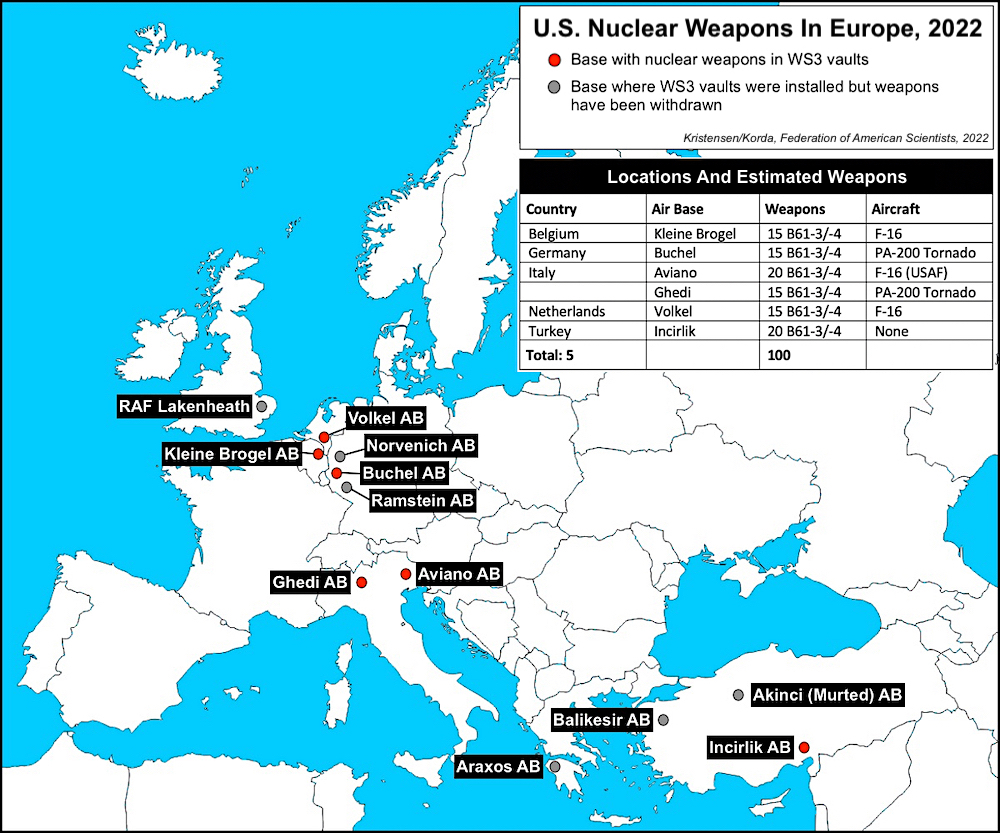
Each of these bases have one or two dozen active vaults (Weapons Storage Security System, WS3) inside as many protective aircraft shelters. Ramstein air base in Germany used to be the largest storage site in Europe but only 7 vaults remain active possibly for training and transfer. All weapons were withdrawn from Lakenheath before 2007 but the United Kingdom was recently added to the nuclear infrastructure storage modernization program, which means there are now eight active WS3 sites in Europe.

The modernizations at the various bases vary depending on capacity, location, and host country. At Kleine Brogel Air Base in Belgium, the host base for the Steadfast Noon exercise this year, the 701st Munition Support Squadron quarters have been significantly expanded with a drive-through facility for nuclear weapons maintenance trucks. Other construction includes a major facility inside the aircraft tarmac perimeter area, a new control tower, and upgrades of underground cables and the Alarm Communication & Display (AC&D) system.
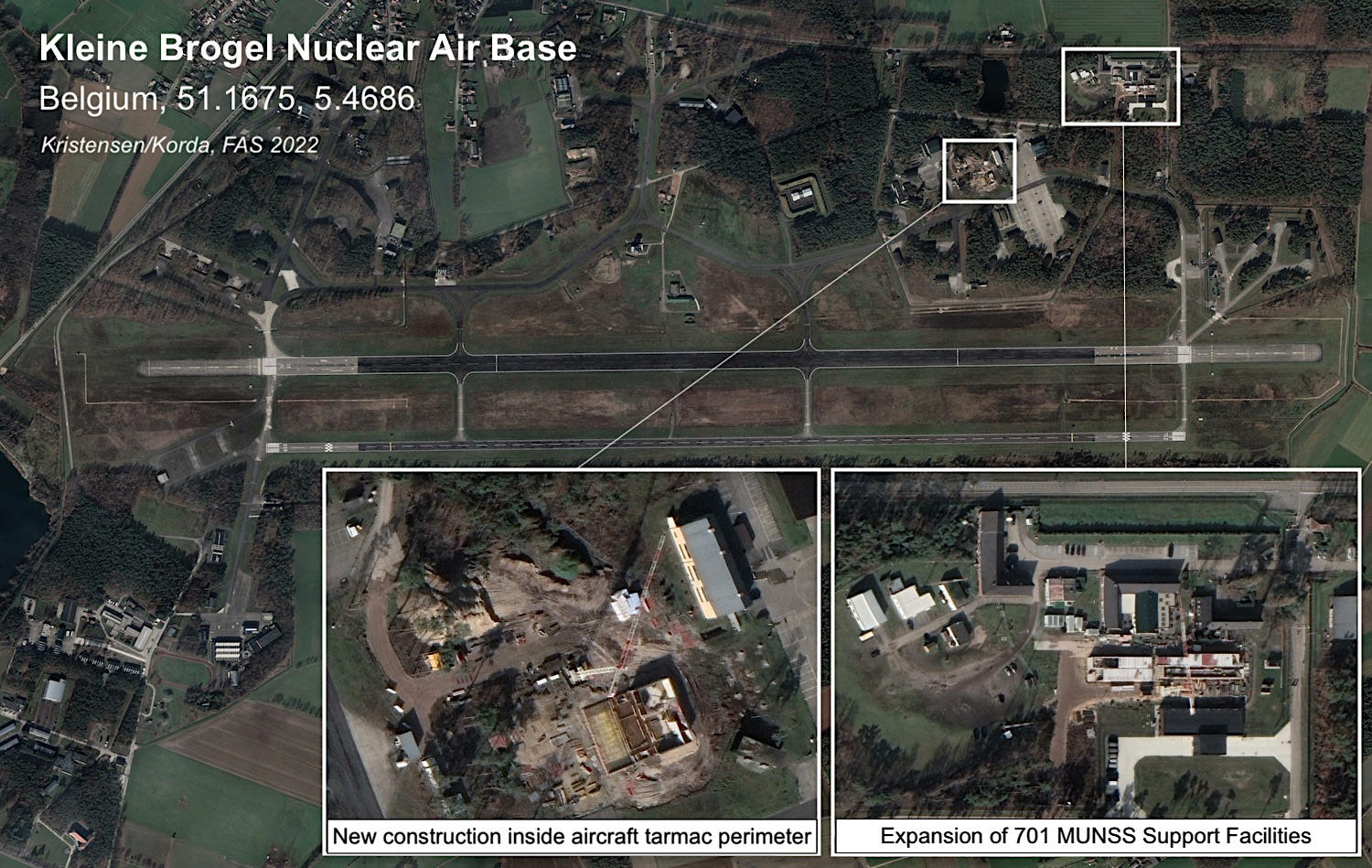
At Büchel Air Base in Germany, construction is underway on the runway. During construction, the Tornados of the 33rd Fighter Wing will be temporarily based at Norvenich Air Base. However, the 10-15 B61 nuclear bombs will remain in the vaults at Büchel. Other recent updates at the base have included underground cables and the Alarm Communication & Display (AC&D) system.
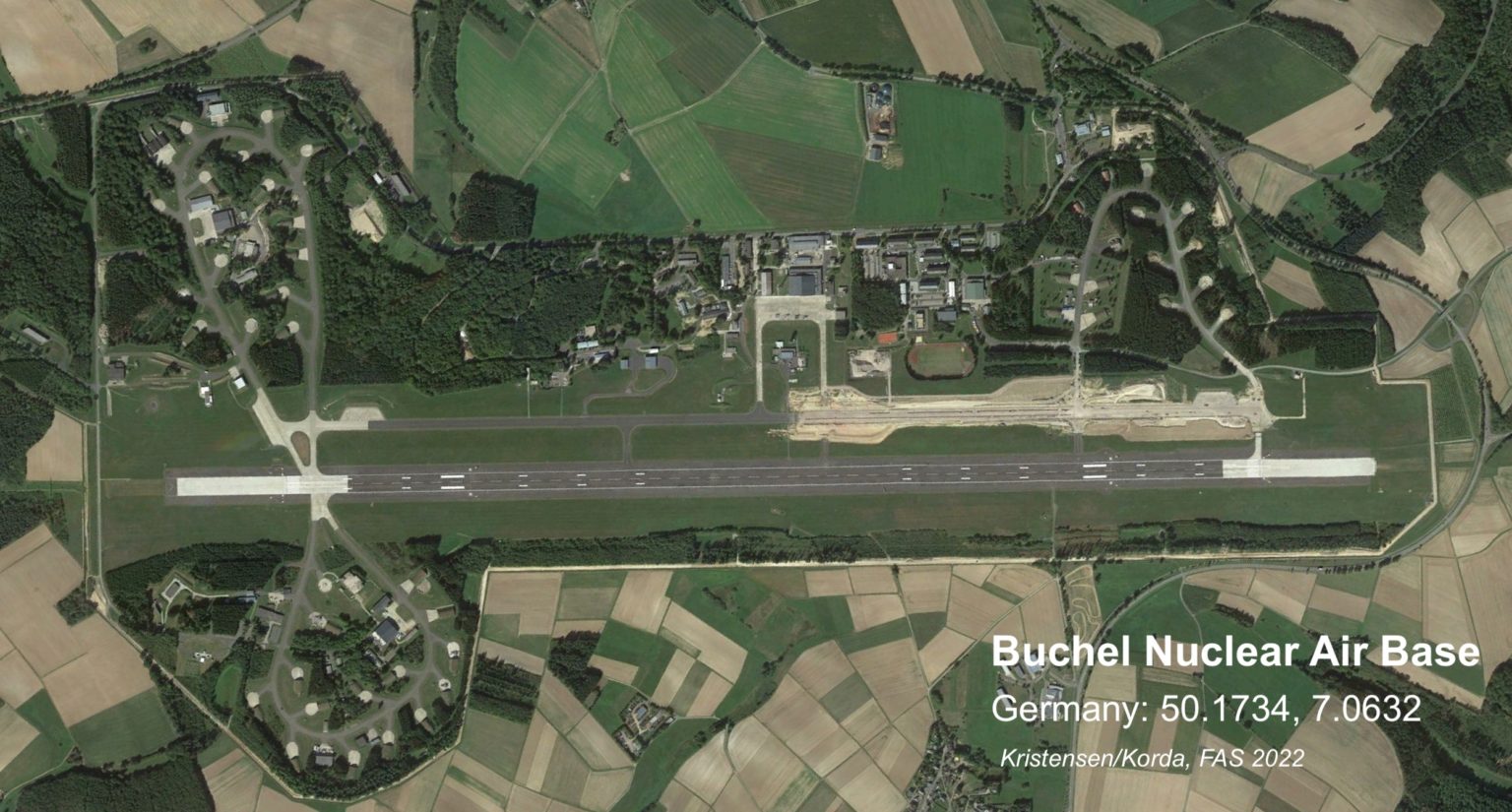
In 2020, as part of a series of visits to bases involved in the nuclear sharing mission, U.S. Air Force Maj. Gen. Derek C. France, the director of operations, strategic deterrence, and integration for U.S. Air Forces in Europe – Air Forces Africa Headquarters director of operations, strategic deterrence, and integration, visited Büchel Air Base where he received a tour and explanation of a protective aircraft shelter. A picture of the tour shows the vault open and a B61 nuclear bomb shape inside.

U.S. Air Force Maj. Gen. Derek C. France, U.S. Air Forces in Europe – Air Forces Africa Headquarters director of operations, strategic deterrence, and nuclear integration, received a tour of a Protective Aircraft Shelter at Büchel Air Base on October 15, 2020. The image shows a B61 nuclear bomb shape hanging in the elevated vault.
At Volkel Air Base in the Netherlands, the most visible modernization currently underway is a major new tarmac area. The construction includes security perimeters probably intended to protect the C-17 aircraft that transport weapons and components to and from the base. Other recent construction the base has included burying underground cables and upgrading the Alarm Communication & Display (AC&D) system used for the WS3 vaults.
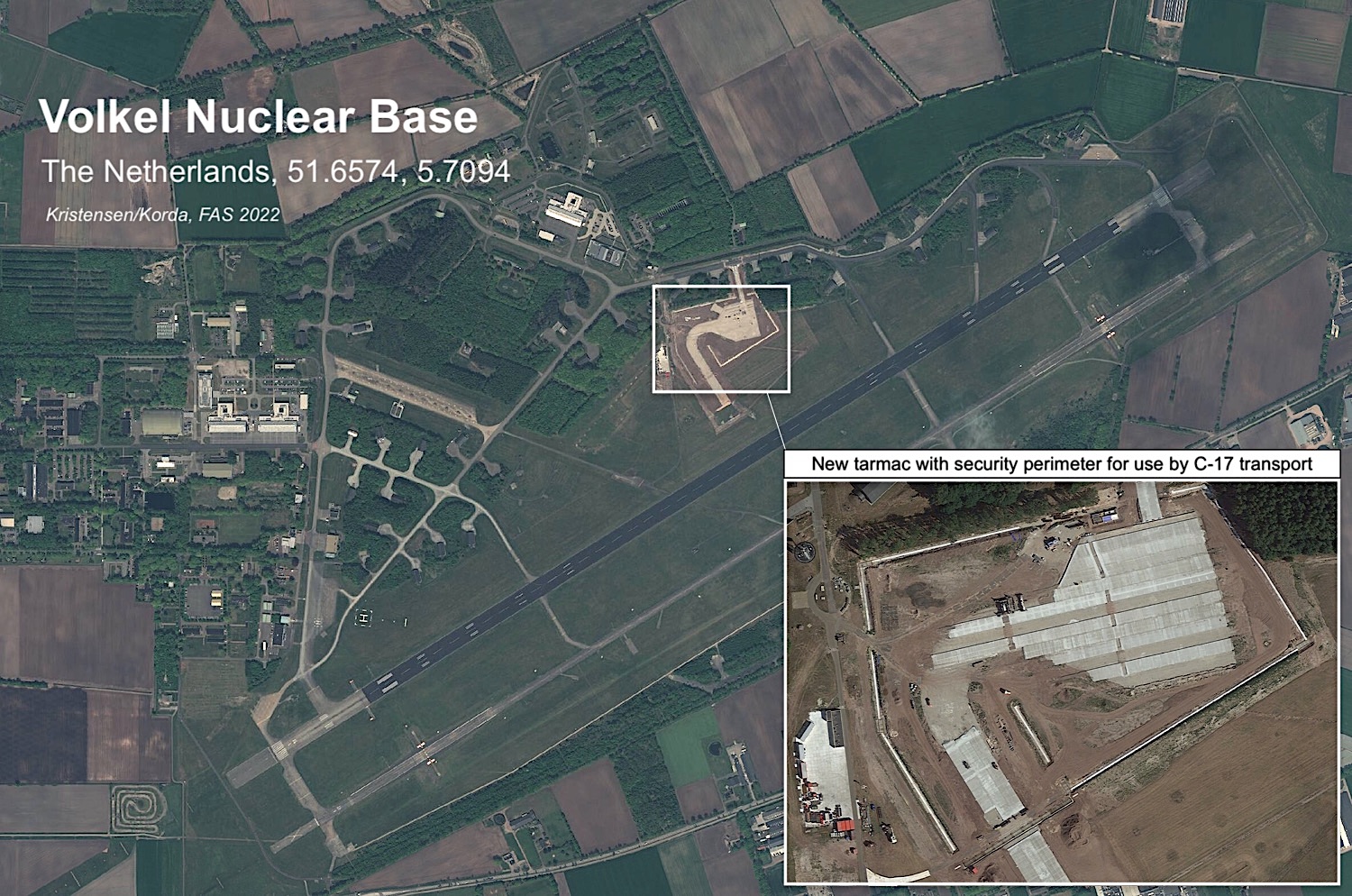
Ghedi Air Base in Italy is undergoing a dramatic upgrade that includes a new tarmac and shelter area for the new F-35A fighter jets that will replace the Tornado jets in the nuclear sharing mission. Work is also underway on what appears to be a drive-through facility for weapons maintenance trucks in the 704th MUNSS area. And a new high-security perimeter has been erected around eight vaults, possibly those of the 11 that are active. This perimeter is similar to perimeters that were constructed at Aviano and Incirlik air bases in 2014-2015. Finally, Ghedi also has received an upgrade of underground cables and the Alarm Communication & Display (AC&D) system used for the WS3 vaults.
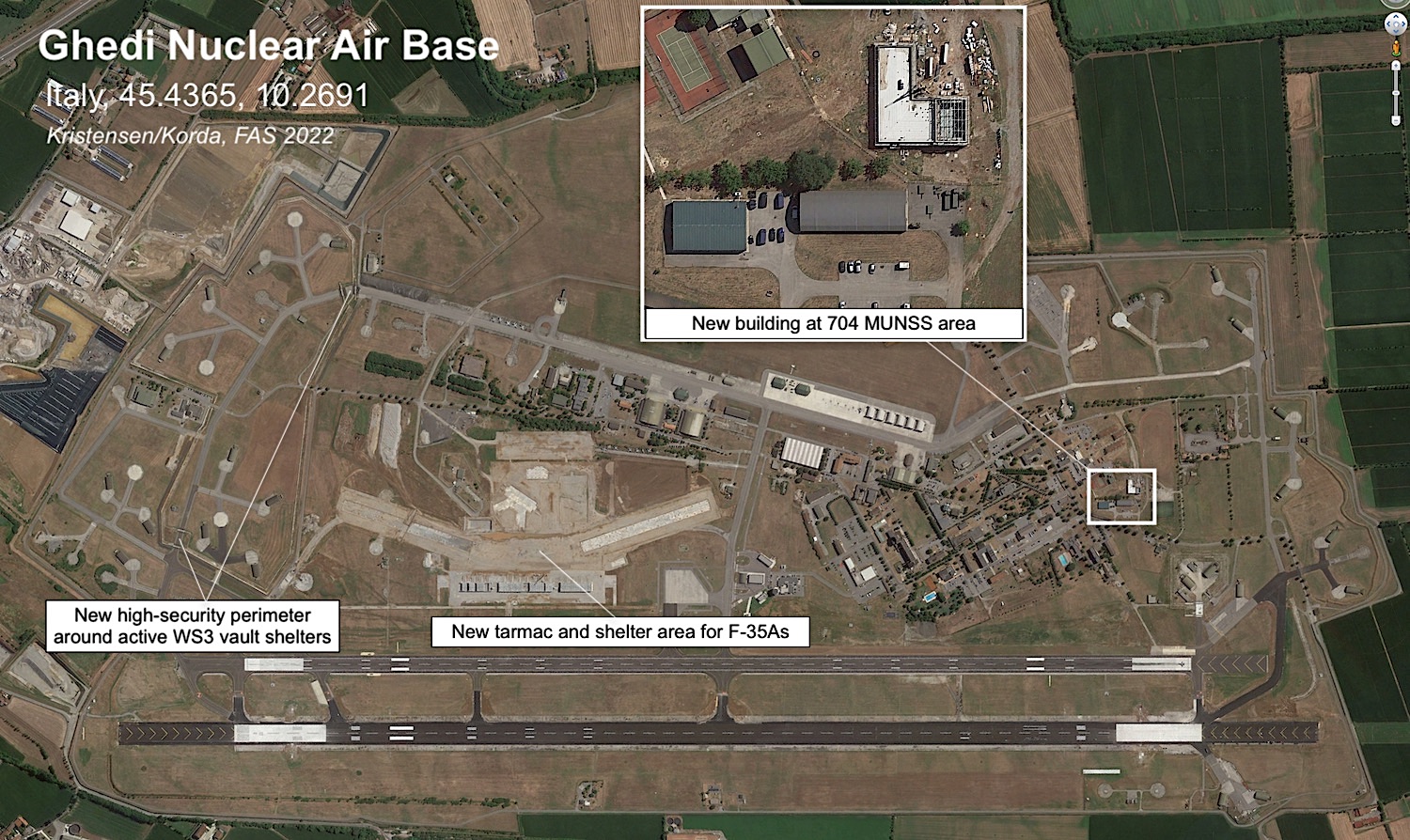
Upgrades of Aviano Air Base in Italy and Incirlik Air Base in Turkey happened around 2015 are described in this article: Upgrades At US Nuclear Bases In Europe Acknowledge Security Risk. Since then, installation of new cables between the nuclear vaults at Incirlik Air Base is visible on satellite images.
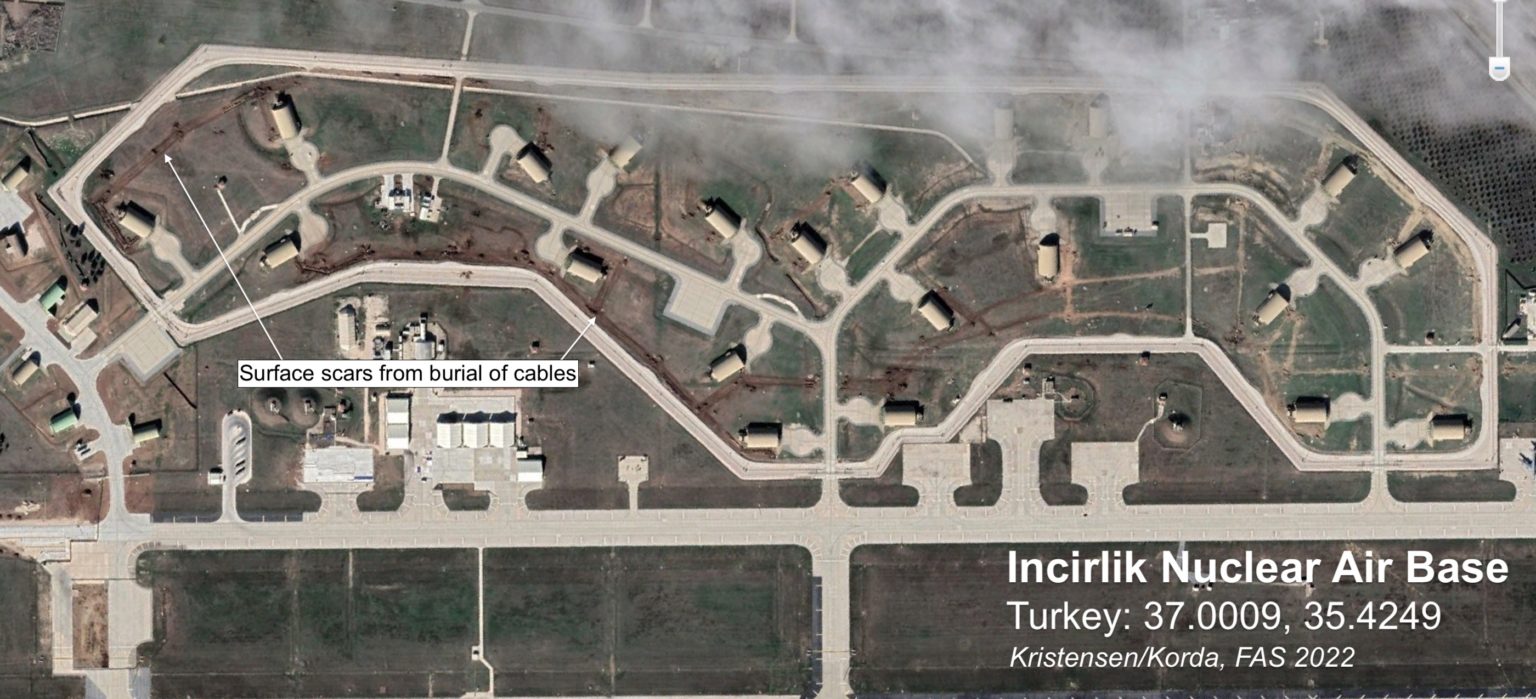
Weapons Modernization
In addition to modernization of bases and support facilities, delivery systems and weapons are also being upgraded. Five of the seven countries that contribute dual-capable aircraft to the nuclear sharing mission are upgrading to the F-35A fifth-generation fighter-bomber: Belgium, Germany, Italy, the Netherlands, and the United States. Turkey was scheduled to upgrade to F-35A but lost the contract after it purchased the Russian S-400 system.
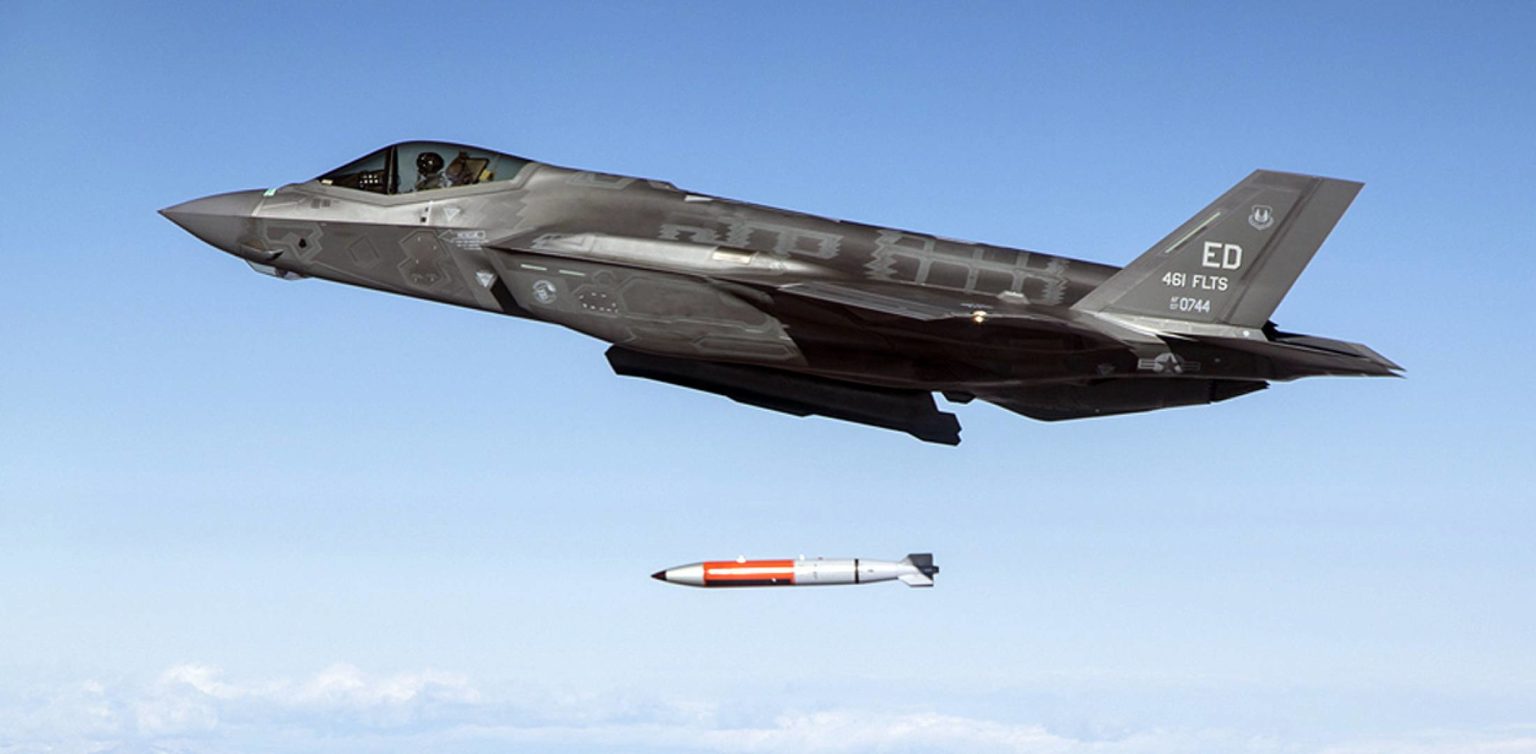
An F-35A test-drops a B61-12 guided nuclear bomb. The enhanced weapon will be compatible with both fighter jets and strategic bombers and begin replacing older B61 versions in Europe from 2023. Image: U.S. Air Force.
Finally, the existing B61 nuclear bombs will soon be replaced by the enhanced B61-12 guided nuclear bomb. Development is essentially complete and full-scale production of about 480 B61-12s is expected to begin soon. The new weapon is thought to have the same yield range as the current B61-4: 0.3, 1.5, 10 and 50 kilotons. Training of the units in Europe to receive the new weapon is scheduled to begin in early-2023 and the first weapons potentially arriving at the first base in late-2023 or 2024.
In addition to the non-strategic fighter jets F-15E, F-16, F-35A, and Tornado, the B61-12 will also be integrated on the B-2 and B-21 strategic bombers. Because of the increased accuracy provided by the tail kit, all the digital aircraft that can make use of it (all except F-16 and Tornado) will be able to hold at risk a wide range of targets. The combination of increased accuracy and lower-yield options on non-strategic and strategic stealth aircraft will significantly increase the capability of the gravity bomb mission.
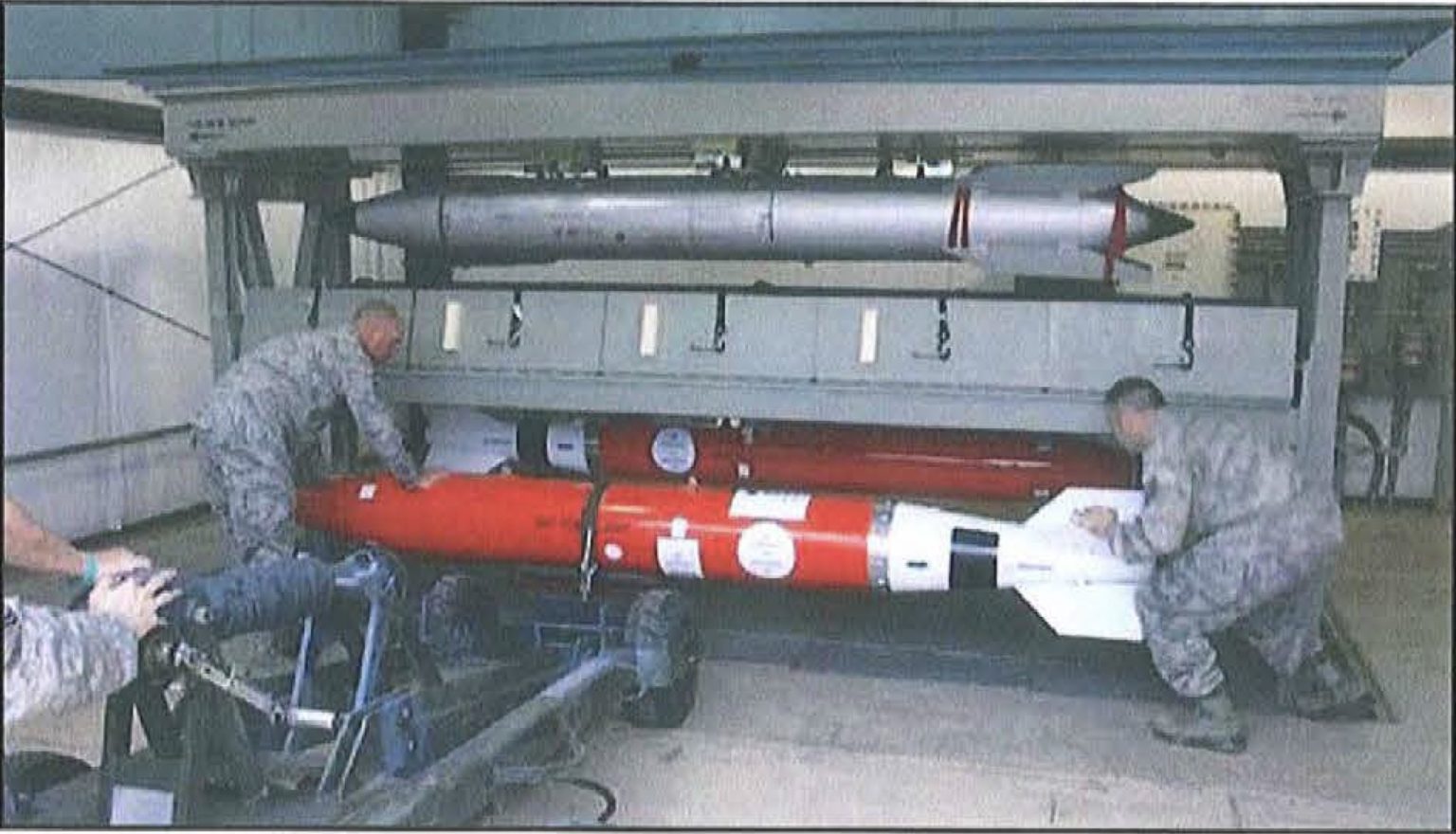
Each of the WS3 vaults at European bases can hold up to four nuclear bombs. Here crews are practicing loading B61 bombs into a vault: two B61-3/4 bombs on the top rack and two B61-12 bombs on the lower rack. Image: U.S. Air Force, obtained by Joseph Trevithick (The Drive) under FOIA.
This publication was made possible by generous contributions from the John D. and Catherine T. MacArthur Foundation, the New-Land Foundation, the Ploughshares Fund, the Prospect Hill Foundation, Longview Philanthropy, the Stewart R. Mott Foundation, the Future of Life Institute, Open Philanthropy, and individual donors. The statements made and views expressed are solely the responsibility of the author.
Lakenheath Air Base Added To Nuclear Weapons Storage Site Upgrades
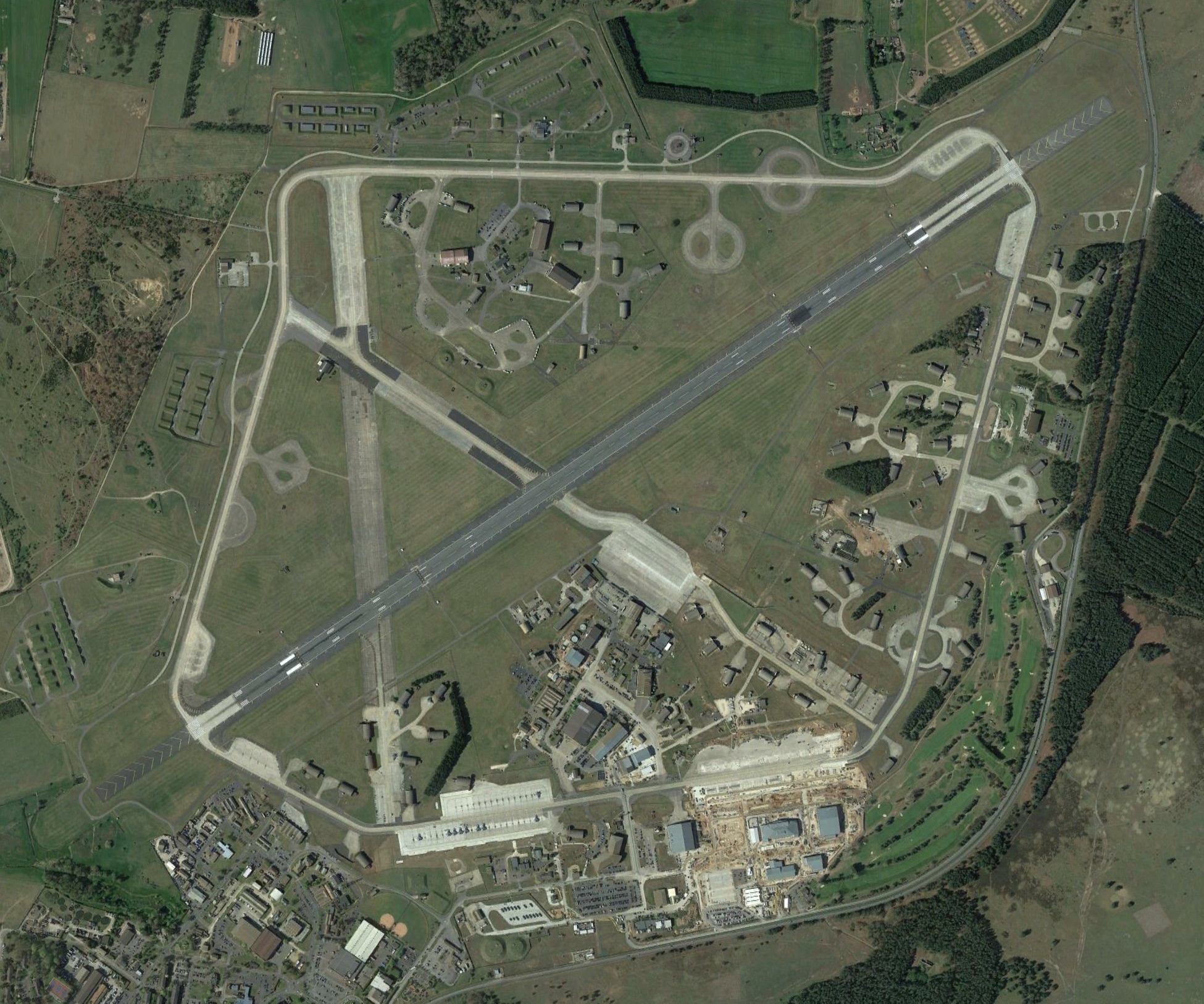
The US Air Force base at Lakenheath has been added to the list of nuclear weapons storage sites being upgraded in Europe.
US Defense Department documents show that NATO has quietly added the United Kingdom to the list of nuclear weapons storage locations that are being upgraded.
The documents do not identify the specific facility, but it is believed to be the US Air Base at RAF Lakenheath in southeast England approximately 100 kilometers northeast of London.
Previous budget documents listed “special weapons” storage sites in Belgium, Germany, Italy, the Netherlands, and Turkey as receiving upgrades under a 13-year NATO investment program. The Biden administration’s FY2023 defense budget request adds “the UK” to the list (see image below).

The United Kingdom has been added to the list of nuclear weapons storage site locations in Europe. Click on image to view full size.
RAF Lakenheath was not on the list of “active sites” in the 2016 contract for the upgrade of the nuclear weapons storage site in Europe. The budget documents indicate the base has since been added to the list.
The US Air Force used to store nuclear gravity bombs at Lakenheath, which in the 1990s was equipped with 33 underground storage vaults. By the early 2000s, there were a total of 110 B61 gravity bombs in the vaults for delivery by F-15E aircraft of the 48th Fighter Wing.
In 2008, I disclosed that the nuclear weapons had been withdrawn from RAF Lakenheath, the first time since 1954 that the United States did not store nuclear weapons in the United Kingdom.
What’s Going On?
The addition of the United Kingdom to the list of nuclear storage locations being upgraded in Europe signals a change in the nuclear status of RAF Lakenheath. It is unclear if nuclear weapons have been returned to the base yet or NATO is upgrading the base to be capable of receiving nuclear weapons in the future if necessary.
After nuclear weapons were withdrawn nearly two decades ago, the empty storage vaults were kept in caretaker status. The F-15Es fighter-bombers retained their nuclear capability but at a lower operational level. In recent years there have been rumors about nuclear exercises at the base.
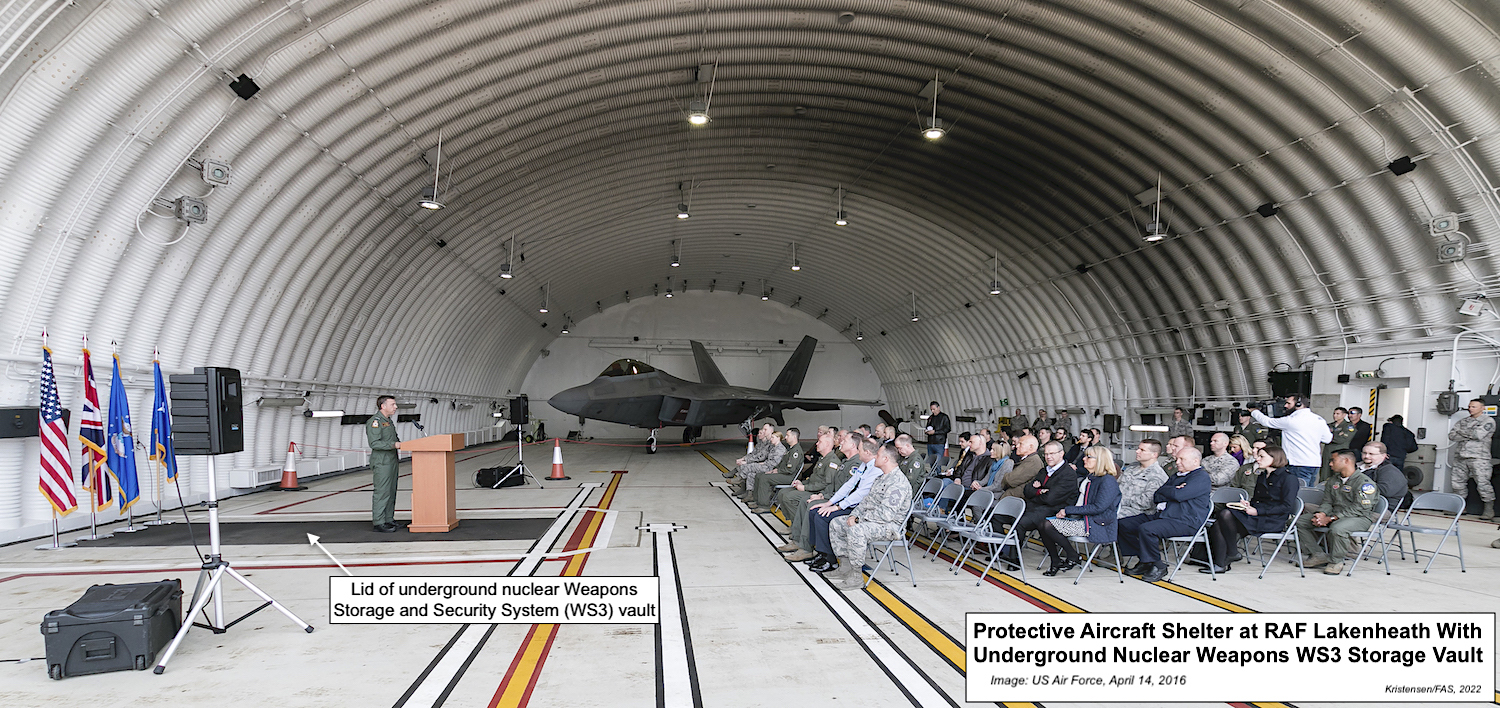
A ceremony during a F-22 Raptor visit to RAF Lakenheath in 2016 was held inside an aircraft shelter with an (empty) underground nuclear weapons vault. There are 33 vaults at the base.
The nuclear upgrade comes as RAF Lakenheath is preparing to become the first US Air Force base in Europe equipped with the nuclear-capable F-35A Lightning. The first of the fifth-generation fighter-bombers arrived in December 2021. A total of 24 F-35As will form the 495th Fighter Squadron of the 48th Fighter Wing at the base.
The US Air Force is scheduled to begin training the nuclear units in Europe within the next year to receive the new B61-12 guided nuclear bomb that will begin full-scale production next month. It is possible the first B61-12 bombs will be shipped to Europe in 2023, where they will replace the B61-3/-4 bombs currently deployed there.

The US will begin full-scale production of the new B61-12 guided nuclear bomb next month, start training units in Europe around the turn of the year, and potentially deploy the first weapons in 2023.
Given NATO’s cautious nuclear response to Russia’s nuclear saber rattling at the start of its invasion of Ukraine, it would be odd if the nuclear upgrade at RAF Lakenheath reflected plans to deploy additional US nuclear bombs to Europe. FAS estimates there currently are roughly 100 nuclear bombs deployed at six air bases in five European countries.
NATO Secretary General Jens Stoltenberg declared in December 2021, that “we have no plans of stationing any nuclear weapons in any other countries than we already have these nuclear weapons as part of our deterrence and that… have been there for many, many years.” Unless NATO has changed its plans since, that seems to be a clear signal that there are currently no plans to deploy nuclear weapons to RAF Lakenheath for now (see map below).

RAF Lakenheath has been an inactive nuclear weapons storage site for nearly two decades. There are currently an estimated 100 US Air Force nuclear bombs stored in Europe.
Rather, the upgrade at RAF Lakenheath could potentially be intended to increase the flexibility of the existing nuclear deployment within Europe, without increasing the number of weapons. Adding RAF Lakenheath as an active site would potentially allow it to receive nuclear weapons from other existing locations in Europe, if that became necessary. Such a contingency could potentially involve receiving weapons withdrawn from Turkey. There are unconfirmed rumors that many of the weapons at Incirlik Air Base in Turkey have already been withdrawn and moved to other bases in Europe.
Readying RAF Lakenheath could potentially also be intended to better realign the overall nuclear posture in Europe with the rapidly deteriorating relations with Russia. This is a delicate issue because changes in NATO’s nuclear posture in Europe might trigger retaliatory changes in Russia’s nuclear posture, including potentially deployment of nuclear weapons to Belarus, which recently changed its constitution to allow for just that.
This publication was made possible by generous support from the John D. and Catherine T. MacArthur Foundation, the New Land Foundation, the Ploughshares Fund, and the Prospect Hill Foundation. The statements made and views expressed are solely the responsibility of the author.
NNSA Removes F/A-18F Super Hornet From Nuclear Bomb Fact Sheet
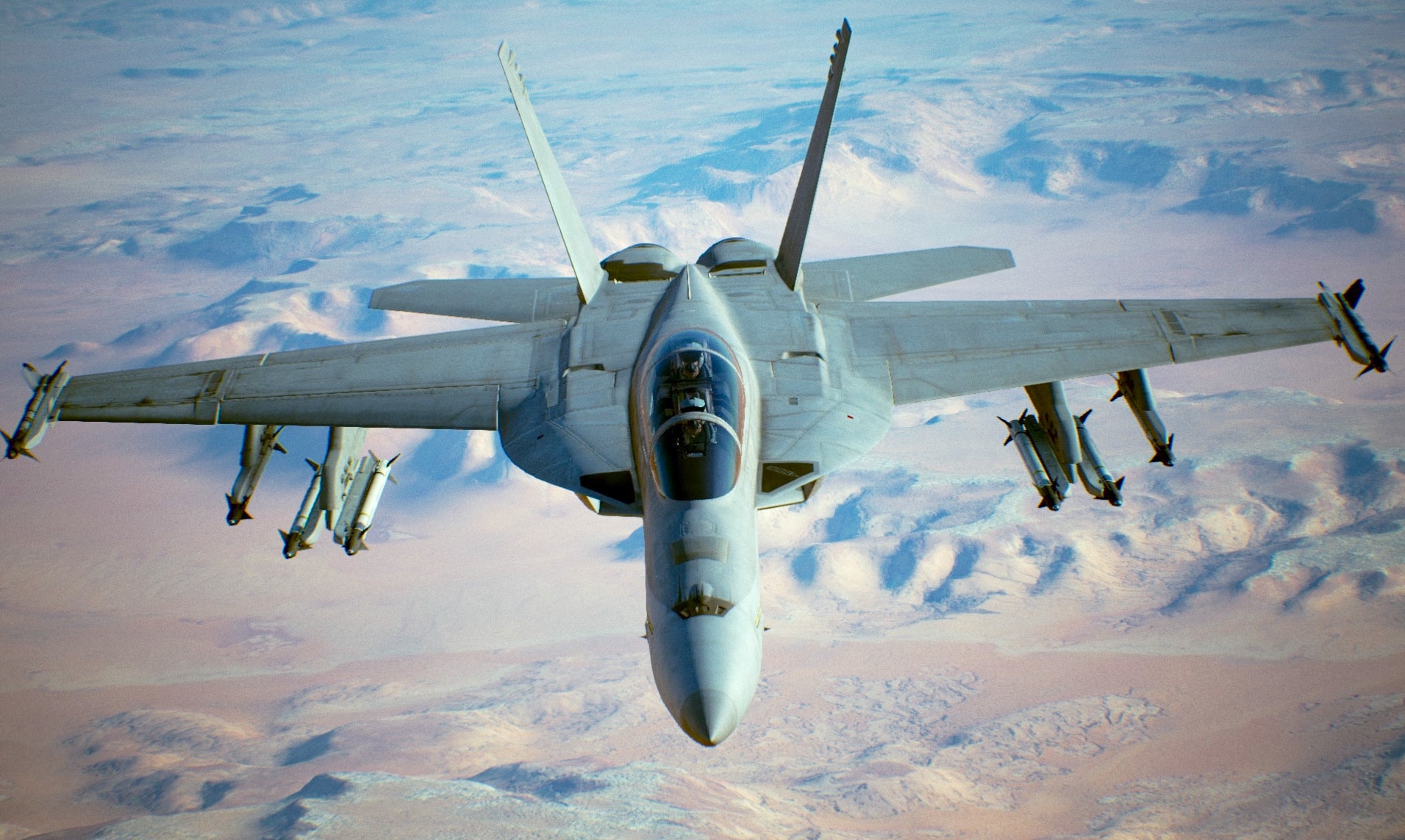
The F/A-18F is a two-seat version of the F/A-18E. Image: US Department of Defense
The National Nuclear Security Administration (NNSA) has quietly removed the F/A-18F Super Hornet from its B61-12 nuclear bomb fact sheet.
No public explanation has been offered for why the aircraft was removed or added in the first place.
The F/A-18F was added to a “November 2021” fact sheet published in early December, which listed the aircraft as one of three future aircraft platforms for the new B61-12 guided nuclear bomb (see image below). An earlier version from 2018 did not mention the F/A-18F.
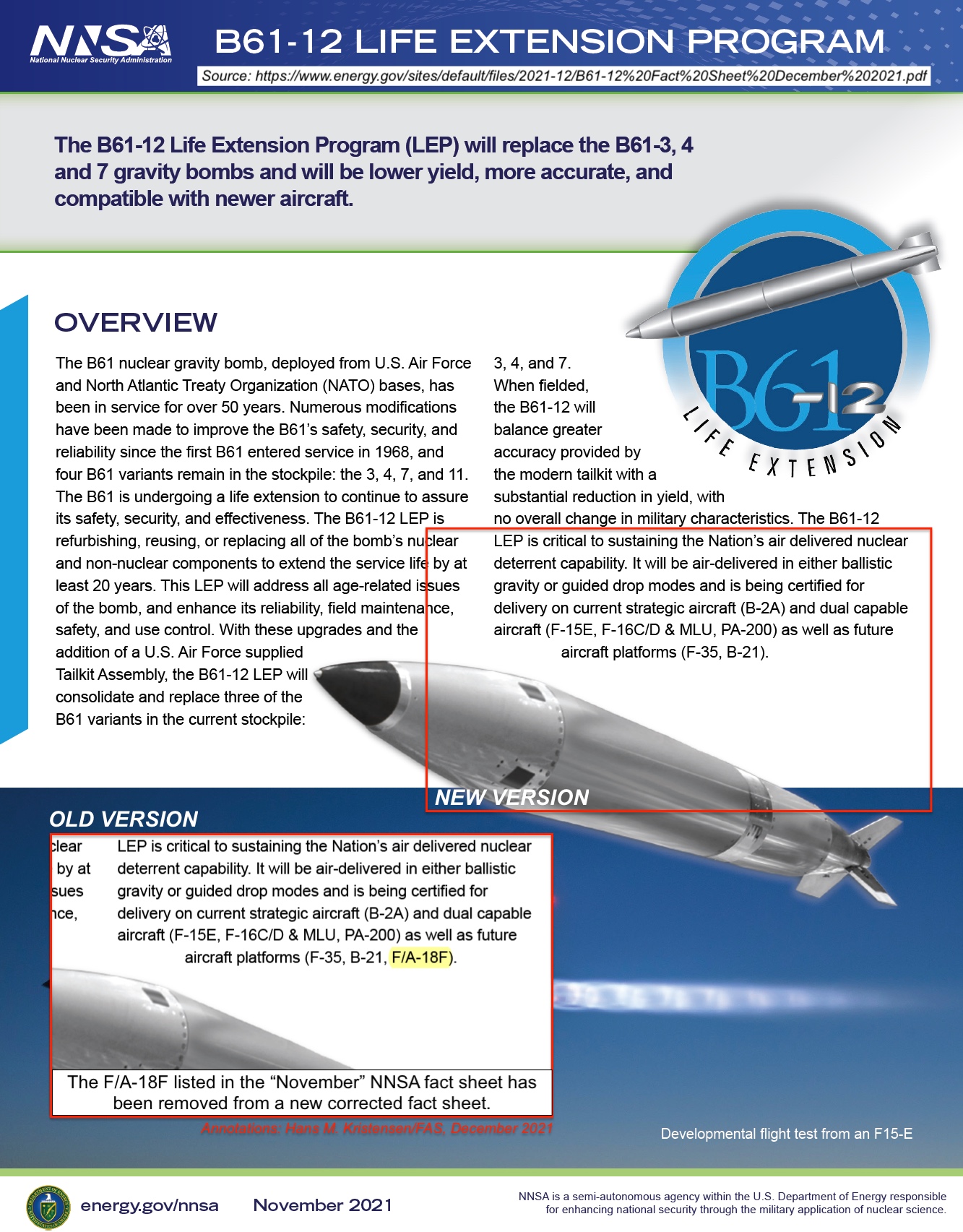
NNSA in 2021 added, and then deleted, the F/A-18F Super Hornet from its B61-12 nuclear bomb fact sheet.
The reason for including the F/A-18F was not stated. It could potentially indicate anticipated sale to Germany to replace its aging Tornado aircraft in the “nuclear sharing” strike mission, or that the U.S. Navy was planning to reintroduce nuclear capability on aircraft carriers (unlikely).
In response to questions from me, NNSA initially said neither of those were the reason for including the F/A-18F in the fact sheet. But after coordinating with the Defense Department, NNSA asked me to ignore that explanation saying the listing of the F/A-18 in the fact sheet was a mistake.
I have also asked the Defense Department, but it has not responded yet. Update: DOD said “there is not a requirement for the F/A-18F to be certified to carry the B61-12.”
What’s Going On?
The 2018 Nuclear Posture Review (NPR) considered many new nuclear weapons, but only two made it into the public version of the document as “nuclear supplements”: the low-yield W76-2 Trident warhead and the nuclear sea-launched cruise missile (SLCM-N). The W76-2 is already deployed, and the Biden administration’s NPR is currently considering whether to continue the SLCM-N. Doing so would violate the 1992 Presidential Nuclear Initiative.
One of the ideas proposed was reintroducing nuclear weapons on the aircraft carriers, an idea pushed by some former officials. The military rejected the idea. The carriers were denuclearized by the 1994 Nuclear Posture Review, the Navy does not want nukes back on them, but it would in any case probably have been the F-35C – not the F/A-18F.
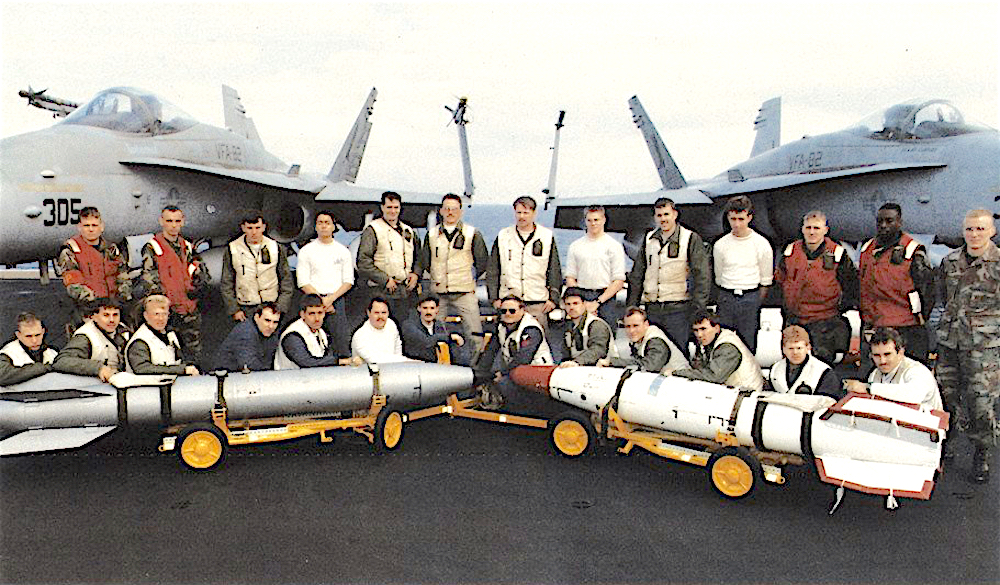
F/A-18 aircraft (background) used to be tasked with delivering nuclear bombs from aircraft carriers. The image shows B61 (left) and B43 nuclear bomb trainers on the deck of USS America (CV-66) during the 1991 Gulf War. Image: US Navy.
Instead, the appearance of the F/A-18F in the NNSA fact sheet probably reflected preparations to support Germany’s anticipated purchase the aircraft for its nuclear mission, and that the fact sheet was likely corrected because the German government has not publicly announced its selection of the F/A-18 (and the Parliament has not yet agreed to pay for it).
There is a lot of opposition in Germany to nuclear weapons and the question of whether to continue participation in the nuclear-sharing mission is politically sensitive. In 2020, Der Spiegel reported that the German defense minister had informed the Pentagon that Germany intended to buy the F/A-18 to replace the current Tornados (PA-200) in the “nuclear-sharing” strike mission. The report caused an uproar because the Parliament had not been informed or agreed. The minister later denied that a decision had been made, at least officially.
Pressure has been building on Germany to continue the nuclear-sharing mission. During the negotiations of the new coalition government, NATO secretary general Johan Stoltenberg issued what appeared to be an empty threat that “the alternative is that we easily end up with nuclear weapons in other countries in Europe, also to the east of Germany.”
The threat appeared empty because NATO had just endorsed a new defense plan to protect against “the growing threat from Russia’s missile systems” that included “improving the readiness” of NATO nuclear forces. Why NATO would choose to deploy its nuclear forces further east closer to those missiles is unclear. Moreover, deployment of nuclear weapons further east would require NATO consensus, which seems unlikely. But the threat was heard in Moscow and Stoltenberg later had to walk back his threat by reassuring that “We have no plans of stationing any nuclear weapons in other countries than [those that] already have these nuclear weapons….”
The tactical nuclear weapons mission in Europe was recently exercised in the Steadfast Noon exercise held in northern Italy in October. The exercise included German Tornado fighter-bombers. There are an estimated 100 US non-strategic B61 nuclear bombs deployed in Europe, including about 15 at Buchel Air Base in Germany (see map below).
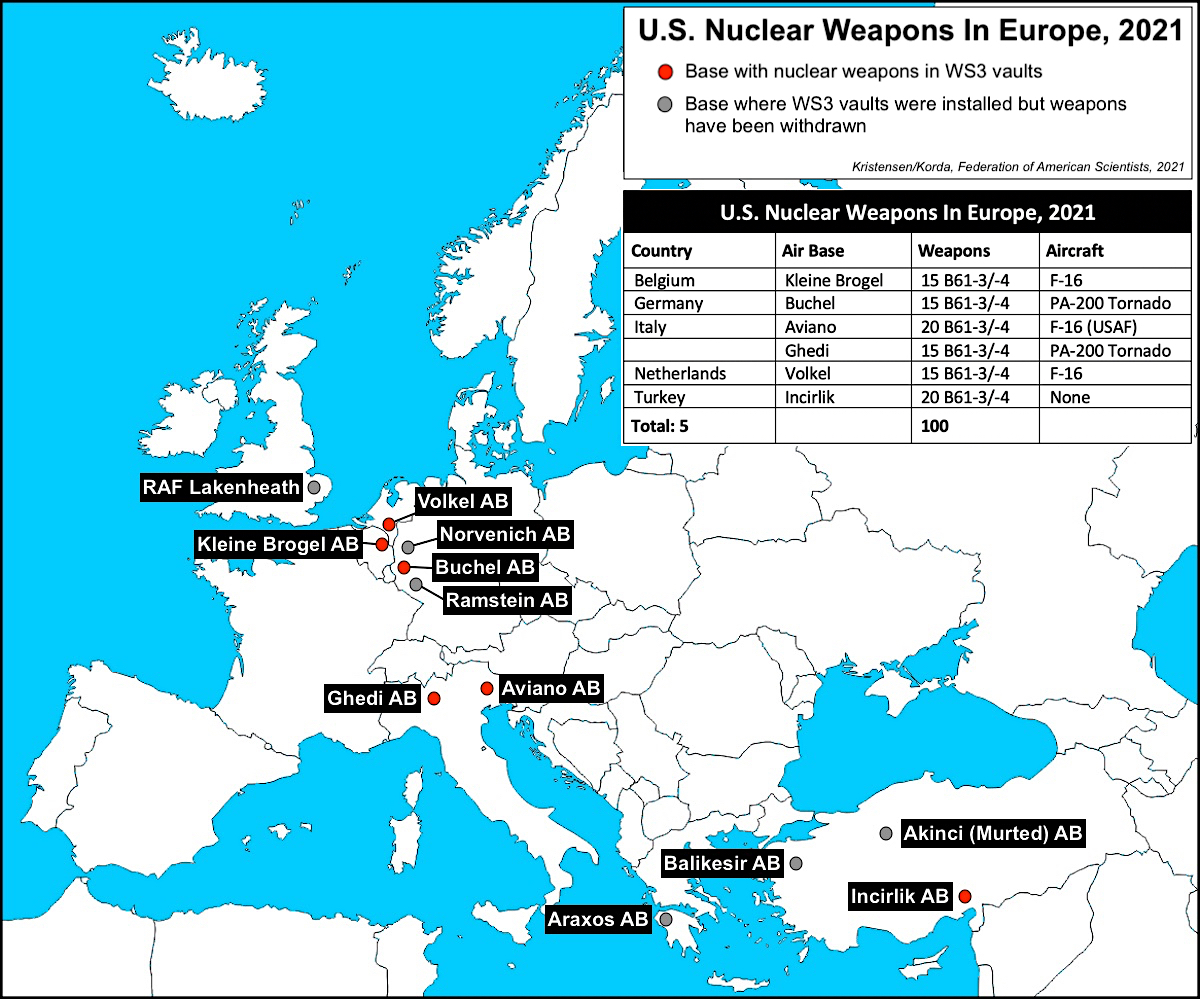
The US Air Force deploys an estimated 100 B61 nuclear bombs at five bases in six European NATO countries. There are no nuclear weapon storage facilities in the new Eastern European NATO countries.
The pressure apparently worked: The new German coalition government took office with a program that agreed to continue Germany’s participation in the nuclear-sharing mission. Although the US Navy has decided to end production of the F/A-18E/F after this year to focus resources on the F-35C, Boeing could continue production for foreign customers, including Germany. And Boeing officials reportedly expect Germany to issue a letter of request for the F/A-18F Super Hornet and EA-18G Growler in early 2022.
The F/A-18F has been removed from the fact sheet for now, but if Germany submits a formal request to buy the aircraft, NNSA will have to update the fact sheet once again.
Additional information:
- NNSA B61-12 Fact Sheet
- Video Shows Earth-Penetrating Capability of B61-12 Nuclear Bomb
- FAS Nuclear Notebook: United States nuclear weapons, 2021
- FAS overview: Status of World Nuclear Forces
This publication was made possible by generous support from the John D. and Catherine T. MacArthur Foundation, the New Land Foundation, the Ploughshares Fund, and the Prospect Hill Foundation. The statements made and views expressed are solely the responsibility of the author.
NATO Nuclear Weapons Exercise Over Southern Europe
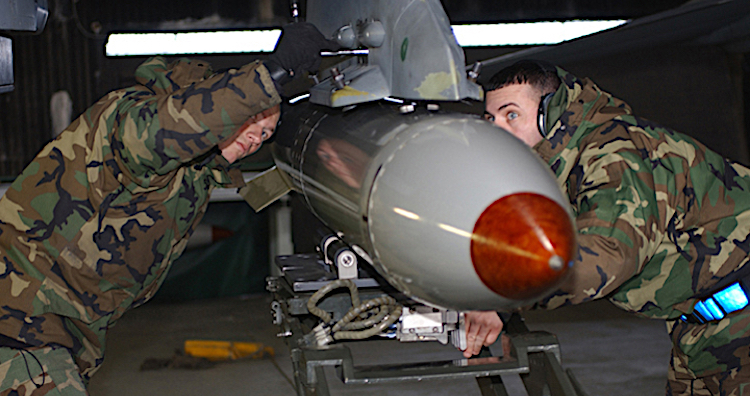
USAF personnel loading a B61 nuclear bomb trainer on an F-16 fighter-bomber at Aviano Air Base
NATO announced Monday that it had started its annual nuclear exercise code-named Steadfast Noon. The week-long exercise is taking place over Southern Europe and involves aircraft and personnel from 14 NATO countries.
According to the NATO statement, “Steadfast Noon involves training flights with dual-capable fighter jets, as well as conventional jets, backed by surveillance and refuelling aircraft. No live weapons are used. This exercise helps to ensure that NATO’s nuclear deterrent remains safe, secure and effective.”
The nuclear bases in southern Europe have received several upgrades during the past few years. This includes adding additional security perimeters to strengthen protection of the nuclear weapons stored at the bases. Two of these bases – Aviano in northeast Italy and Incirlik in southern Turkey, were upgraded over the past five years.
The second nuclear base in Italy – Ghedi near Brescia – that might be part of Italy’s hosting of this year’s Steadfast Noon exercise, is currently undergoing several important nuclear weapons related modernizations that are intended to serve the NATO nuclear strike mission for years.
Of the 14 nations involved, Dutch F-16s and German Tornadoes are operating out of Ghedi AB alongside Italian Tornados, while U.S. and Belgian F-16s and possibly Czech Gripen are operating out of Aviano AB.
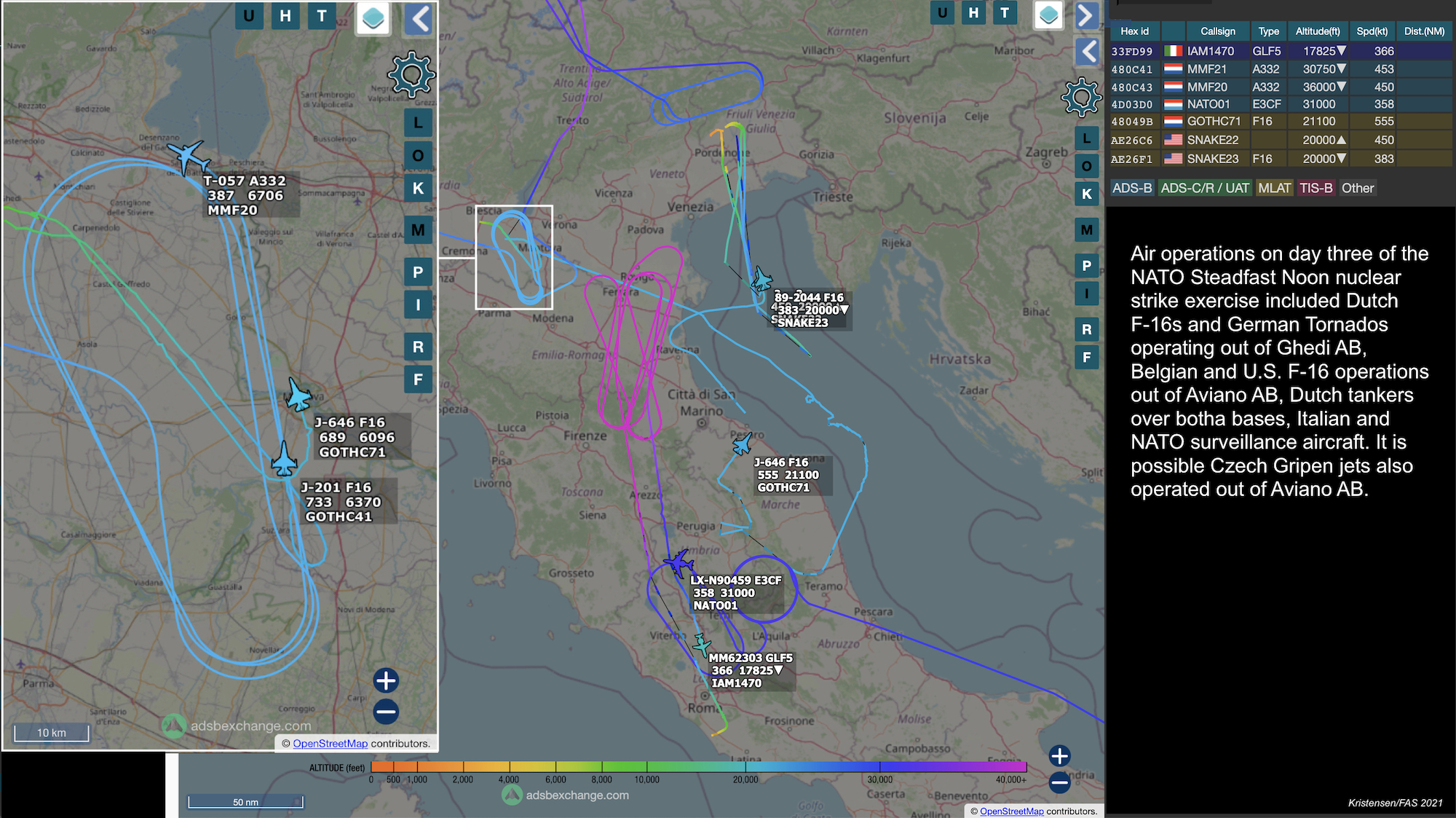
The Steadfast Noon exercise appears to involve operations out of both Ghedi AB and Aviano AB
The timing of the Steadfast Noon exercise coincides with the meeting of the NATO ministers of defense later this week, although it is unclear if the timing is coincidental. NATO has greatly reduced (as has Russia) the number of non-strategic nuclear weapons in Europe since the Cold War. The remaining weapons were probably headed for withdrawal had it not been for Russia’s invasion of Ukraine in 2014. And with claims that Russia is increasing its non-strategic nuclear arsenal, NATO has since reemphasized the importance of the U.S. tactical nuclear weapons in Europe. During the Steadfast Noon exercise at Volkel Air Base in 2020, for example, the NATO Secretary General showed up at the base for a photo-op.

The USAF currently stores an estimated 100 nuclear bombs in Europe, down from 180 in 2010 and 480 in 2000. Over the past decade, restructuring and uncertainty about Turkey have reduced the inventory.
Ghedi: Nuclear Base Profile
NATO announced the Steadfast Noon is taking place over southern Europe but did not identify the main operating base. Steadfast Noon exercises are hosted by a different country each year. Last year it was hosted by the Netherlands and centered at Volkel AB. The reference to southern Europe implies this year’s Steadfast Noon is hosted by Italy and probably centered at Ghedi AB and Aviano AB is northern Italy (Aviano hosted in 2010 and 2013).
Ghedi AB is home to the Italian Air Force’s 6th Stormo wing, which is tasked to employ U.S. B61 bombs with PA-200 Tornado of the 102nd and 154th fighter-bomber squadrons. There are an estimated 15 B61 bombs stored in underground vaults at the base. The bombs are in the custody of the USAF’s 704th Munition Support Squadron (MUNSS), a 130-personnel strong security and maintenance unit embedded at the base.
Ghedi AB is currently undergoing significant upgrades to receive the new F-35A fighter-bomber next year, installing double-fence security perimeters, and having recently completed modernizing the Weapon Storage and Security System (WS3) and Alarm Communication and Display (AC&D) system. The contract for the WS3/AC&D work, which was awarded in September 2016, provided for sustainment upgrades to the WS3 cryptographic system used to encrypt WS3 alarm data, and will perform an AC&D system upgrade by replacing obsolete components and the buried cable. These upgrades are clearly visible on satellite images, as are a new “bunker building” under construction in the 704th MUNSS area along with the new Secure Transportation and Maintenance System (STMS) trucks (see images below).
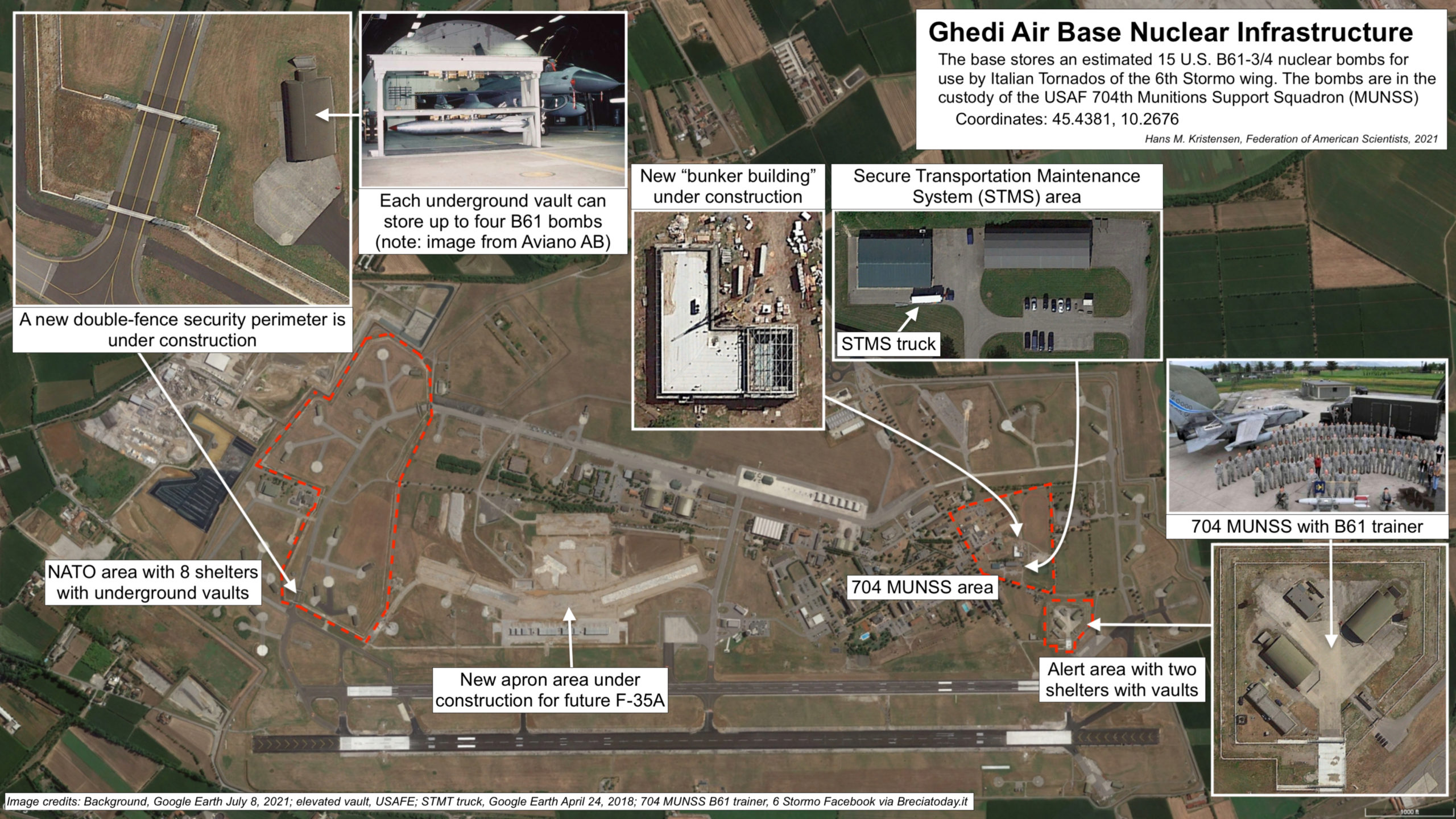
Several nuclear weapons related upgrades are underway at Ghedi Air Base.
The new double-fence security perimeters around eight protective aircraft shelters (left side of image) as well as the former nuclear alert area (lower right side) are similar to the security upgrades previously completed at two other bases in southern Europe: Aviano and Incirlik air bases. The area inside the perimeters is commonly referred to as the NATO area, a reference to the NATO nuclear strike mission they support. In the 1990s, NATO installed a total of 11 underground vaults inside 11 protective aircraft shelters at Ghedi AB. Each vault can store up to four B61 bombs (normally only one or two bombs are present).
But there’s a mystery: The new security perimeters only surround 10 of the 11 shelters. One possibility is that the remaining vault in the 11th shelter is a training vault, or that the number of active vaults has been reduced. But a satellite image from April 2018 might provide a hint. The image appears to show the markings from the burying of the new AC&D cables that connect the vaults in the shelters with the monitoring and communications facilities at the base. By retracing the cables markings, a pattern emerges: the cables appear to connect exactly 11 shelters, including seven inside the new security perimeter. Moreover, the cables appear to form two loops, possibly so that damage to a cable in one spot won’t cut off communication with the vaults on the other side (see image below).
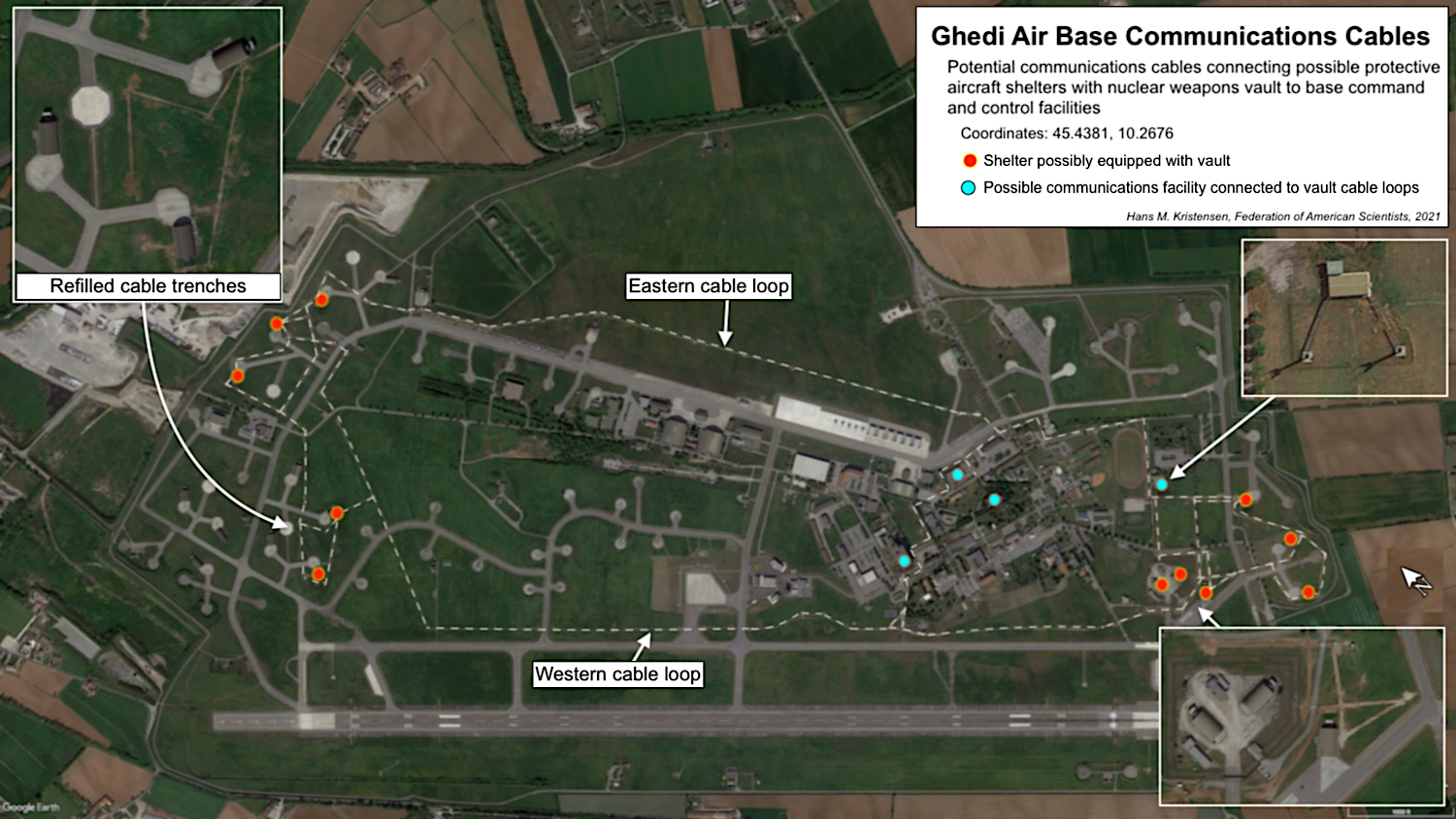
A satellite image appears to show which shelters are connected to the nuclear command and control system at Ghedi Air Base. Image: Google Earth, April 24, 2018.
There is another mystery: Several shelters connected to the apparent AC&D cable grid are located outside the new security perimeters (right side of image), and several shelter that do not appear to be connect to the grid are inside the perimeter (left side of image). Since survivability was one of the justifications for building vaults instead of a central weapons storage area, it would make sense that vaults would be scattered across the base. But the 11 vaults were completed at a time when there were many more nuclear bombs stored at Ghedi AB than today: over 40 bombs in 2000 compared with about 15 bombs today.
Perhaps the four vaults outside the perimeters are backup vaults that do not contain bombs under normal circumstances. All remaining weapons would be stored in the seven vaults inside the perimeters under normal circumstances. With a capability to store up to four B61 bombs each, even the five vaults inside the main security perimeter have more than enough capacity to store the 15 bombs currently estimated to be located at Ghedi AB.
Weapons And Capabilities
These upgrades at Ghedi AB are intended to support the NATO nuclear strike mission at the base for decades into the future. The F-35A, which will begin arriving at the base probably as early as in 2022, is significantly more capable than the Tornado aircraft it replaces.
Moreover, the B61-12 gravity bomb is about three times as accurate as the B61-3/-4 bombs current stored at the base. The increased accuracy is achieved with a new guided tail kit that will enable strike planners to hold at risk targets more effectively with the B61-12 than with the current B61 versions. Like the B61s currently at the base, the B61-12 is thought to have four selectable yield settings ranging from less than 1 kilotons to about 50 kilotons. But with the increased accuracy, a strike planner would be able to select a lower yield option for the attack and therefore create less radioactive fallout, or attack targets that currently require a higher-yield strategic bomb from a B-2 bomber.
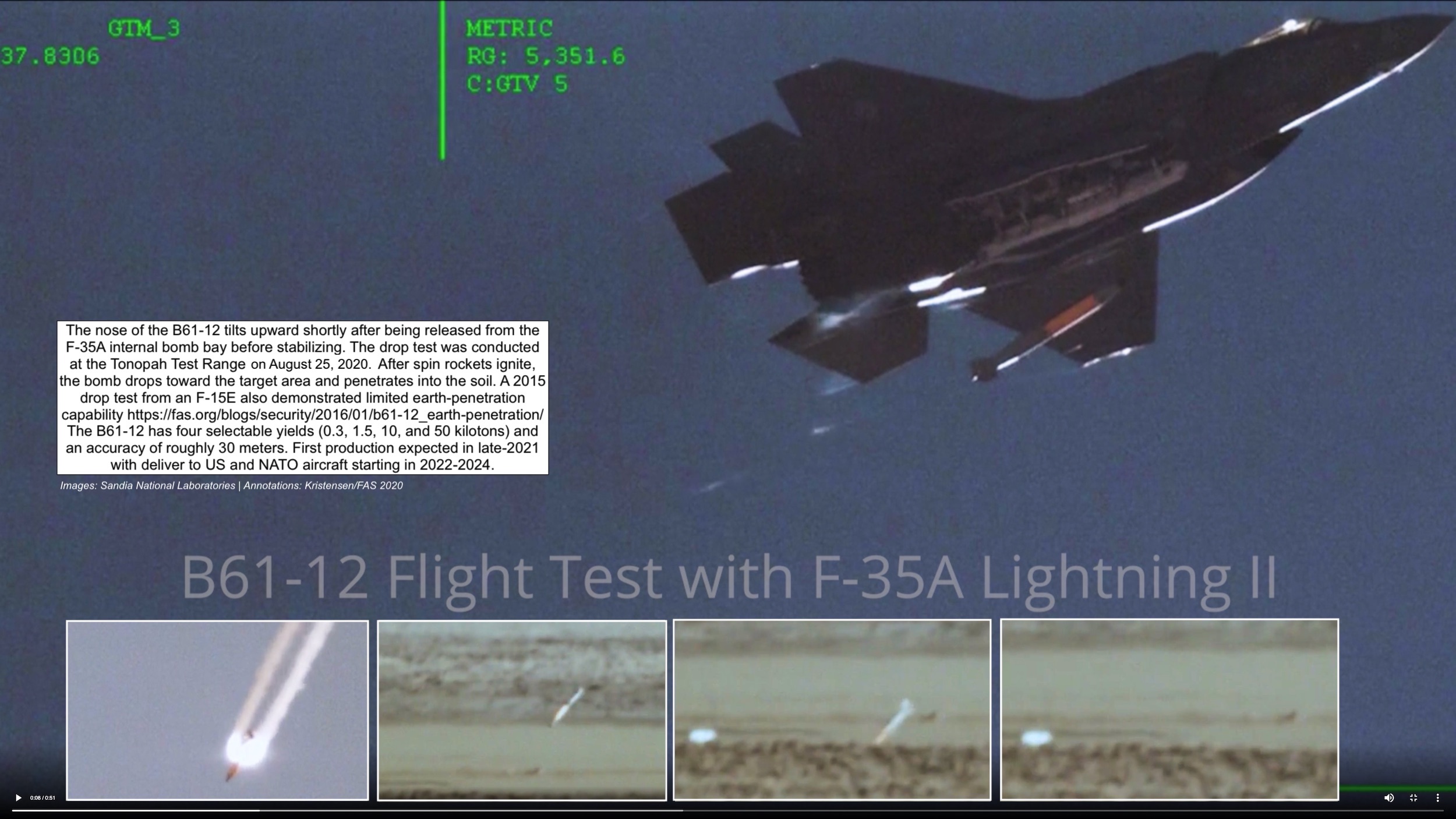
The F-35A with the B61-12 “brings an entirely new strategic-level capability.”
The combination of the F-35A and B61-12 represent a significant improvement of the military capability of the NATO dual-capable aircraft posture in Europe. Following the final drop test from an F-35A in a few weeks ago, for example, the chief of the U.S. Air Force Air Combat Command’s strategic deterrence and nuclear integration division, Lt. Col Daniel Jackson, said that “Having a 5th Generation DCA fighter aircraft with this capability brings an entirely new strategic-level capability.” He explained further: “The B-2 bomber was the prominent nuclear capable stealth aircraft, but “Adding ‘nuclear capable’ to a 5th-Gen fighter that already brings several conventional-level capabilities to the table adds strategic-level implication to this jet.”
Additional information:
- United States Nuclear Weapons, 2021
- Tactical nuclear weapons, 2019
- Video Shows Earth-Penetrating Capability of B61-12 Nuclear Bomb
- Upgrades at US Nuclear Bases in Europe Acknowledge Security Risk
This publication was made possible by generous support from the John D. and Catherine T. MacArthur Foundation, the New Land Foundation, the Ploughshares Fund, and the Prospect Hill Foundation. The statements made and views expressed are solely the responsibility of the author.
The State Department’s Compliance Report Plays the Blame Game, Despite Offering Little Evidence
The State Department’s Bureau of Arms Control, Verification and Compliance yesterday released its annual “Compliance Report,” which provides a detailed overview of US (and other countries’) adherence to various treaty and agreement commitments.
The report’s publication comes at a critical time, as the Trump administration has spent the past few years––and the past three months in particular––dismantling the last vestiges of US commitments to the international arms control regime. The administration has recently declared that it is unlikely to extend New START, has withdrawn from the Open Skies Treaty, has alluded to an intent to resume nuclear testing, and has announced that it will “reinterpret” the Missile Technology Control Regime in order to allow the United States to sell armed drones to previously-forbidden countries.
In addition to its intended purpose––providing the official public US assessment of how other countries adhere to arms control treaties and agreements––the administration clearly sees the Compliance Report as a tool to provide justification for shedding treaties. As such, other countries might question the report’s conclusion that the United States is in full compliance with all of its international obligations, but that other treaty parties are not.
Several sections of the Compliance Report are missing both critical context about how and why certain treaties met their eventual ends, as well as actual evidence for some of its claims about the actions of its arms control partners. To that end, we have tried to fill in some of the blanks below.
The Intermediate-Range Nuclear Forces (INF) Treaty
The report assesses that throughout 2019, the United States was in full compliance with the INF Treaty––the landmark Cold War-era treaty that eliminated and banned all US and Russian ground-launched missiles with ranges between 500 and 5,500 kilometers.
Although this assertion appears to be technically correct and provides an extensive overview of Russian activities, it is missing some critical context. Both the United States and Russia suspended their respective obligations under the treaty in February 2019, and the treaty officially died in August 2019. Although it appeared that Russia had been violating the treaty for many years, we have argued that the Trump administration’s decision to finally kill the treaty was the wrong move, for several reasons.
Firstly, withdrawal established a false moral equivalency between the United States, who probably was not violating the treaty, and Russia, who probably was. It also put the United States in conflict with its own key policy documents like the Nuclear Posture Review and public statements made last year, which emphasized staying in the treaty while trying to bring Russia back into compliance through diplomatic, economic, and military measures. NATO preferred this approach until the Trump administration changed its mind and decided to withdraw, at which point NATO followed suit to avoid being seen to be in conflict with Washington.
The 2020 Compliance Report states that withdrawal from the INF Treaty was intended as a “remedy” for Russia’s material breach. But if the ultimate goal was to coax or coerce Russia back into compliance, then killing the treaty did the opposite. Instead, it legally freed Russia to deploy even more INF missiles on land, something the report explicitly warns that Russia might do by converting the SS-N-30a/Sagaris (Kalibr) sea-launched cruise missile into a land-based system. It also allowed the United States to explore developing INF-range missiles of its own. Only 16 days after the treaty’s collapse, the United States test launched a crudely-fashioned missile that would have certainly violated the INF treaty––if it had still existed.
New START
The 2020 Compliance Report notes that both Russia and the United States are in full compliance with the New START treaty, which caps the number of strategic nuclear warheads and delivery vehicles that each country is allowed to deploy. This is not newsworthy in itself; mutual compliance was confirmed by State and Defense Department officials during Senate testimony in 2018, after the February treaty deadline had passed.
It is bizarre that the Trump administration is using alleged Russian non-compliance with other treaties in order to undermine the one treaty with which Russia is actually complying. Moreover, unlike any other treaty mentioned in the Compliance Report, the strategic forces limited by the New START treaty are the only weapons of mass destruction that can threaten the very existence of the United States.
New START expires in less than a year, and while Russia has agreed to extend it unconditionally, the Trump administration has been dragging its feet. This should be a no-brainer: the treaty is a good deal for both parties, it offers a critical source of predictability and transparency into Russia’s nuclear forces, and extension is widely supported across the country, even among Trump voters; in fact, it’s one of the very few bipartisan issues still remaining in Congress. Senior military leaders, such as the Vice Chairman of the Joint Chiefs of Staff and the commander of Air Force Global Strike Command, have declared their full support for the treaty, largely because it offers a critical source of transparency and stability in the US-Russia nuclear relationship.
Specifically, during the 2018 Senate hearing, then-Under Secretary of State for Arms Control and International Security Affairs noted “The United States benefits from the Treaty’s 18 annual on-site inspections, notifications, and biannual data exchanges, which give us insight into the number of Russia’s strategic offensive arms subject to the Treaty and where they are at any given time.” She further noted, “Should the Treaty expire, U.S. inspectors would lose their current access to Russian strategic nuclear warheads and delivery systems, bases, and infrastructure, as well as the Treaty’s biannual exchange of data and associated updates on the location and status of Russia’s strategic offensive arms subject to the Treaty.” However, this fact hasn’t stopped Trump’s new arms control envoy Marshall Billingslea––an ardent opponent of arms control who opposed US ratification of the 1993 Chemical Weapons Convention and the 1996 Comprehensive Test Ban Treaty, and supported US withdrawal in 2002 from the 1972 Anti-Ballistic Missile Treaty––from inexplicably arguing the opposite point. In an interview with The Washington Times last month, he claimed that “The Obama administration negotiated a very weak verification regime […] which the Russians have been exploiting.” The basis for this claim has not been substantiated by other senior administration or military officials, and is not presented in the Compliance Report itself.
In his recent interview, Billingslea noted that a new or extended New START-style deal would necessarily have to include China. This makes no sense. The entire Chinese arsenal is thought to include about 320 warheads––a fraction of the 4,000-4,500 in the US and Russian arsenals––which is why China’s position has consistently been the same: it will not take part in trilateral arms control negotiations while this strategic imbalance remains.
Therefore, as we have previously argued in Forbes, killing New START because it doesn’t include China would do nothing to address the United States’ security concerns about Chinese nuclear forces. Instead, if limits on US and Russian strategic nuclear forces fell away and caused both countries to increase their nuclear forces, China might decide that it would need to increase its stockpile even further in order to adjust to the greater nuclear threat. This would further exacerbate a post-New START nuclear crisis.
Extension does not require Congressional approval; it simply requires a presidential stroke of a pen. Given that both countries benefit from the treaty, that both countries are in compliance, and that the United States’ NATO allies strongly favor an extension, this is a ripe piece of low-hanging fruit.
The Joint Comprehensive Plan of Action
The JCPOA (commonly known as the Iran Nuclear Deal), is not mentioned at all in the Compliance Report. This is not necessarily surprising, as the Trump administration officially withdrew from––and then violated––the deal in 2018. However, in recent weeks, Secretary of State Mike Pompeo has argued that the United States remains a party to the deal, and therefore could demand a reimposition of sanctions on Iran if an arms embargo is not extended past October. As Senator Elizabeth Warren correctly tweeted in response, “This makes no sense.” “To extend this arms embargo,” she noted, “the Trump admin is suddenly arguing that the US is a party to the same Iran Deal it abandoned.”
Pompeo’s unconvincing argument is undermined by his own former State Department top arms control official, who noted in her 2018 Senate testimony that the United States completed its “withdrawal from the arrangement on May 8.” Additionally, if the Secretary of State truly believed that the United States was still party to the treaty, why would it be excluded from his own department’s comprehensive annual assessment of US treaty obligations?
The absence of JCPOA is even more curious because Iran’s nuclear activities are covered extensively over seven full pages in the Compliance Report.
Nuclear Testing
The Compliance Report does not assess any country’s compliance with the Comprehensive Test Ban Treaty (CTBT) because the United States has not ratified it. The report repeats the Trump administration’s statement that it has no intentions to ratify the treaty, but nonetheless assesses that Russia and China may have conducted nuclear weapons tests that fail to meet the United States’ “zero-yield” standard. This assertion echoes the claims initially made by DIA Director Ashley during his remarks at the Hudson Institute in May 2019.
On Russia, the report states that the “United States assesses that Russia has conducted nuclear weapons-related experiments that have created nuclear yield.” But it adds in the next sentence that the “United States does not know how many, if any [emphasis added], supercritical or self-sustaining nuclear experiments Russia conducted in 2019.” A test that released nuclear energy from a canister would require Russian notification under the Threshold Test Ban Treaty (TTPT), which Russia has not provided. But the Compliance Report does not present any evidence but says additional information is included in a classified annex.
On China, the report is even more vague and circumstantial. It doesn’t explicitly accuse China of having conducted low-yield nuclear tests nor present evidence to that effect. Instead, the Compliance Report says a number of other activities “raise concern” about China’s adherence to the zero-yield standard of the United States and that “the United States cannot rule out the possibility that China could have conducted activities at its test site that are inconsistent with its moratorium commitment…” Details are hidden in a classified annex.
Open source analysists have not detected “any alarming activity” in this regard. Absent public evidence, both China and Russia have rejected the claims, with the Russian Deputy Foreign Minister “[urging] the United States to abandon the growing practice of misinforming the global community about what is happening,” and the Chinese Foreign Ministry spokesperson “[refusing] to dignify the groundless US allegation with a refutation.”
Claims about Chinese and Russian low-yield testing are not new, but are occasionally used by anti-arms control hawks working to hype the Russian or Chinese threat, in addition to pushing for the United States to resume nuclear weapons testing. It is unfortunate that this year’s Compliance Report echoed these claims without offering any public proof to back them up, and that would-be arms control killers are subsequently using them as “evidence” of cheating.
Presidential Nuclear Initiatives
A new addition to this year’s Compliance Report is a large section (three and a half pages) on the 1991-1992 Presidential Nuclear Initiatives (PNIs). This is an oddball because the PNIs were unilateral declaration, not treaties, without any verification. Apparently, including the PNIs is part of the administration effort to make the case that Russia is cheating and therefore can’t be trusted with other treaties such as the New START treaty.
Russia is cheating on one part of the PNIs, the report says, because Russia hasn’t eliminated all nuclear warheads for Ground Forces as it promised in 1991. The report explicitly identifies the SS-21 and SS-26 short-range ballistic missiles (the SS-26 is replacing the SS-21) as dual-capable. The report does not explicitly say Russian ground-forces have retained nuclear artillery, a frequent rumor on the Internet. Curiously, the SSC-8 GLCM is not mentioned in the PNI section, even though it is a ground-launched dual-capable weapon (it is addressed in the INF section of the report).
The big picture, of course, is that Russia has fulfilled most of the PNI promises and significantly reduced its inventory of non-strategic nuclear weapons since the 1990s. The Compliance Report only mentions in passing that “Russia continues to abide by some PNI pledges, such as warhead consolidation and likely the declared reduction in stockpiles…” Although Russia retains more non-strategic nuclear weapons than the United States (up to 2,000 according to the Nuclear Posture Review), that has been the case for the past three decades. Statements by US government officials indicate that Russia reduced its inventory of non-strategic nuclear weapons between 2009 and 2019 by more than one-third.
One thing completely missing from the Compliance Report’s assessment of the PNI issue is that US planned production of a new nuclear sea-launched cruise missile––as recommended by the Nuclear Posture Review––would be in violation of the United States’ own PNI pledge.
The Role of the Compliance Report
Violations of treaties and agreements must be addressed and resolved, which requires a persistent and professional level of engagement with other countries. Because the Trump administration is focused on abandoning treaties and reinvigorating “Great Power Competition” with Russia and China, however, the Compliance Report may increasingly be seen as a means to provide a justification for that agenda.
Even if Russia is cheating on some agreements, that doesn’t mean they will cheat on all of them, or that it is no longer worth it to retain the ones that are working. Russia has a clear interest in limiting US nuclear forces just as the United States and its allies have an interest in limiting Russian forces.
And even though China is slowly increasing its nuclear arsenal, that doesn’t mean that it is necessarily sprinting to parity. Even if the DIA’s projection that China will “at least double the size of its nuclear stockpile” over the next decade were to happen, that would still not bring the inventory anywhere near the size of the US or Russian stockpiles, which are currently estimated at 4,310 and 3,800 warheads, respectively.
There is also an expectation that if China increases its arsenal it will inevitably result in the abandonment of its no-first-use policy. In February, the head of US STRATCOM offered Senate testimony that he “could drive a truck through that no-first-use policy.” But others, such as Gregory Kulacki, have noted that China’s nuclear strategy is more restrained than what the public debate often assumes.
In sum, the annual Compliance Report should function as a way for the United States and its arms control partners to get on the same page about the status of their respective obligations and anticipate where future compliance issues might arise––not as a way to offer justifications for its own misdeeds. Otherwise, its publication may soon contribute to a breakdown in arms control altogether, rather than function as a mechanism to save it.
Urgent: Move US Nuclear Weapons Out Of Turkey
Should the U.S. Air Force withdraw the roughly 50 B61 nuclear bombs it stores at the Incirlik Air Base in Turkey? The question has come to a head after Turkey’s invasion of Syria, Erdogan’s increasingly authoritarian leadership and deepening discord with NATO, Trump’s inability to manage U.S. security interests in Europe and the Middle East, and war-torn Syria only a few hundred miles from the largest U.S. nuclear weapons storage site in Europe.
According to The New York Times, State and Energy Department (?) officials last weekend quietly reviewed plans for evacuating the weapons from Incirlik. “Those weapons, one senior official said, were now essentially Erdogan’s hostages. To fly them out of Incirlik would be to mark the de facto end of the Turkish-American alliance. To keep them there, though, is to perpetuate a nuclear vulnerability that should have been eliminated years ago.”
That review is long overdue! [Actually, I’ve heard there have been several reviews and a lively internal debate since the 2016 coup attempt.] Some of us have been calling for withdrawal for years (see here and here), but officials have resisted saying it wasn’t as bad as it looked and that the deployment still served a purpose. They were wrong. And by waiting so long to act, the United States has painted itself into a corner where the choice between nuclear security and abandoning Turkey has become unnecessarily stark and urgent.
The situation is even more untenable because Incirlik in just a few years is scheduled to receive a large shipment of the new B61-12 guided nuclear bomb, which would be a recommitment to nuclear deployment in Turkey.
This year is the 60th anniversary of the first deployment of nuclear weapons to Turkey. It is time to bring them home.
Nuclear Weapons At Incirlik
The specific reference in the New York Times article made by officials to nuclear weapons at Incirlik is the most recent and authoritative confirmation that nuclear weapons are still stored at the base. That confirms what I have been hearing and sources at US Air Forces Europe confirmed the report, telling William Arkin the weapons are still there. There have been rumors the weapons were removed after the coup attempt in 2016 (and some really bad disinformation that they had been moved to Romania). All of those rumors were wrong. An article on the official Incirlik Air Base web site even confirms that the mission of the 39th Operations Support Squadron is “to orchestrate and control US, Turkish, and coalition forces operating at Incirlik Airbase in the execution of full-spectrum airpower and nuclear deterrent operations” (emphasis added). Given that the article will likely be removed now that I have pointed this out, it is reproduced in full below:
I have estimated for the past several years that the Air Force stores about 50 B61 nuclear gravity bombs at Incirlik, one-third of the 150 nuclear weapons currently deployed in Europe (see figure below). This estimate has been used by a wide range of news reports and commentators. The number of bombs at Incirlik has decreased over the past two decades from 90 in 2000. In those days, 40 of the 90 bombs were earmarked for delivery by Turkish F-16s. Those 40 bombs used to be stored in 6 vaults at both Akinci AB and Balikesir AB (20 at each) until they were moved to Incirlik when the US Air Force withdrew its Munition Support Squadrons from the Turkish bases in 1996. The 40 “Turkish” bombs remained at Incirlik until around 2005 when they were shipped back to the United States as part of the Bush administration’s unilateral nuclear reduction in Europe.
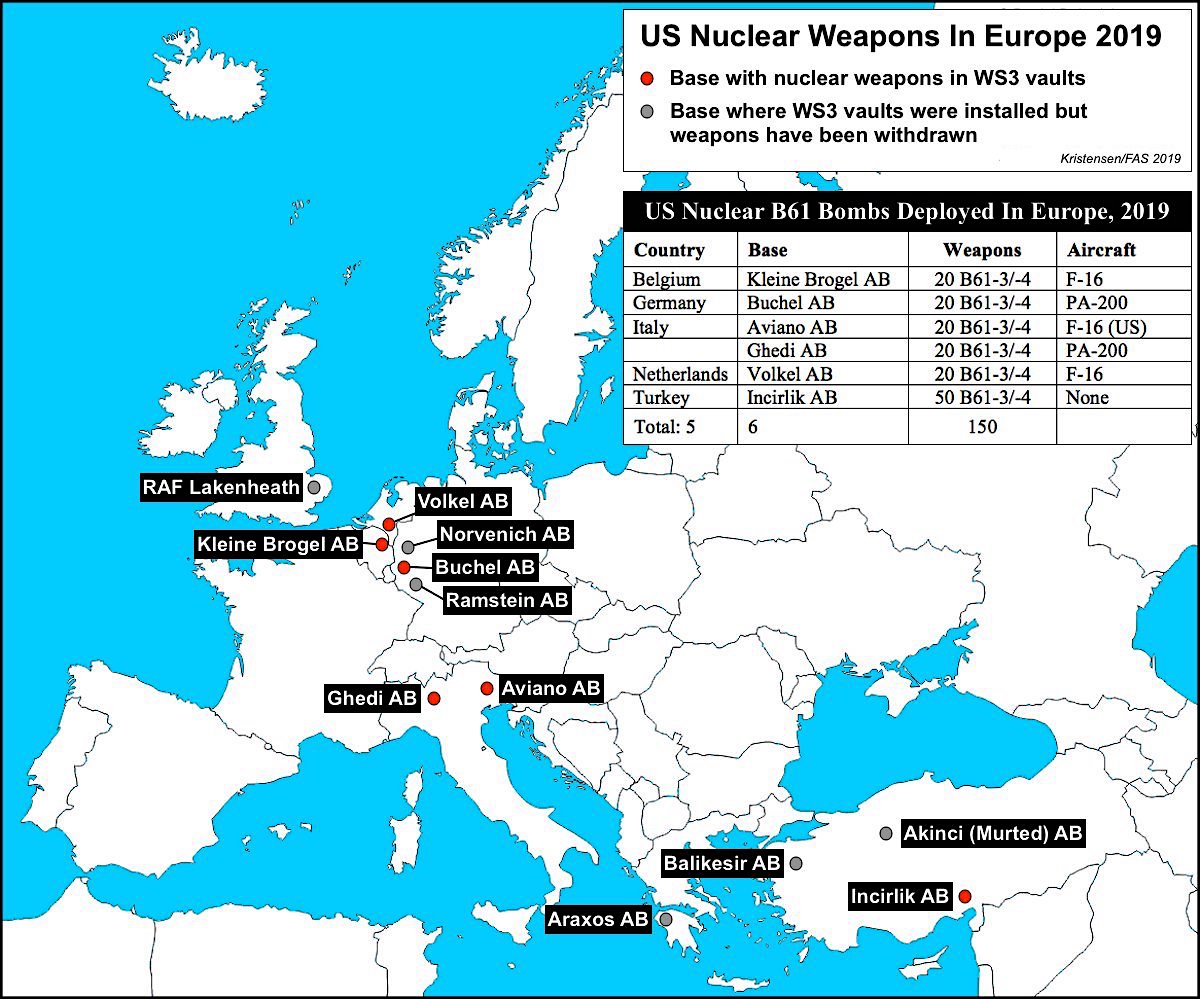
The US Air Force stores 150 nuclear bombs at six bases in five NATO countries. Click on map to view full size.
The remaining 50 bombs are for use by US jets, even though Turkey never allowed the US Air Force to permanently base fighter-squadrons at Incirlik. Jets would have to fly in during a crisis to pick up the weapons or they would have to be shipped to other locations before use. As a result, the nuclear posture at Incirlik has been more a storage site than a fighter-bomber base during the past two decades.
Although the Turkish participation in the NATO nuclear sharing mission was lessened (some would say mothballed) by the withdrawal of the “Turkish” weapons, the Turkish F-16s continued to serve a nuclear role. Despite local reports that F-16s never had a nuclear role, the US Air Force in 2010 informed Congress that “Turkey uses Turkish F-16s to execute their nuclear mission,” and that some of the F-16s would be upgraded to be able to deliver the new B61-12 bomb until the F-35A could take over the nuclear strike mission in the 2020s. That is now not going to happen after the Trump administration canceled the F-35 sale.
In 2015, satellite images revealed construction of a new security perimeter around most of the aircraft shelters with nuclear weapons storage vaults. Of the 25 shelters that originally were equipped with vaults, only 21 were included in the new security area with a capacity to store up to a maximum of 84 nuclear bombs. Normally only about two bombs are stored in each vault, for a total of inventory of 40-50 bombs at Incirlik.
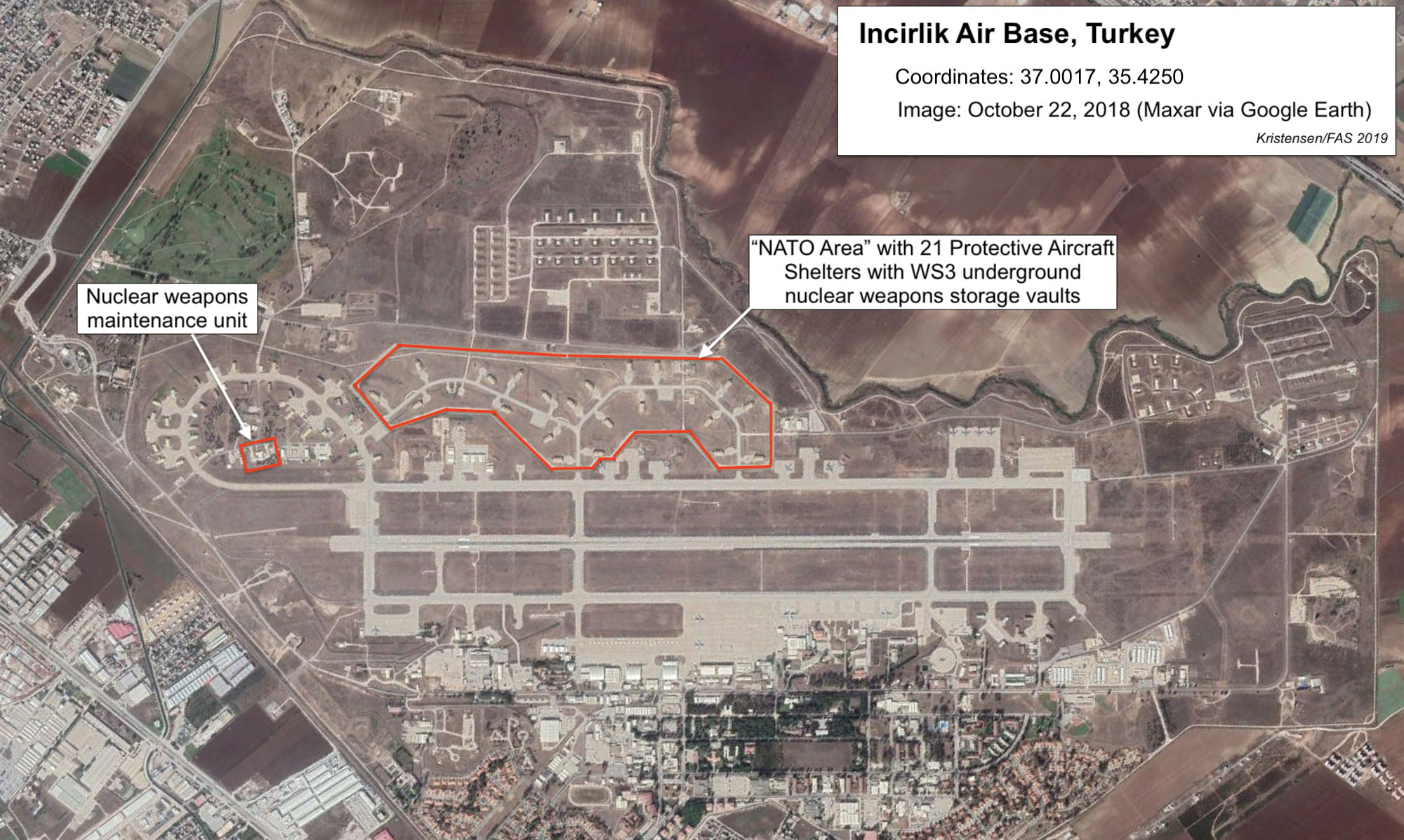
The nuclear weapons mission areas at Incirlik AB include the “NATO Area” where nuclear weapons are stored and the nuclear weapons maintenance unit that manages the underground storage vaults
As recently as last month, Vice Chief Staff of the Air Force, Gen. Stephen W. Wilson, visited Incirlik and was given tours of the various functions and facilities at the base. One of these was Protective Aircraft Shelter H-2 inside the “NATO Area” where he spoke to members of the 39th Security Force that protects the nuclear weapons (see below). He was likely also shown the inside of the shelter and the weapons in the vault.
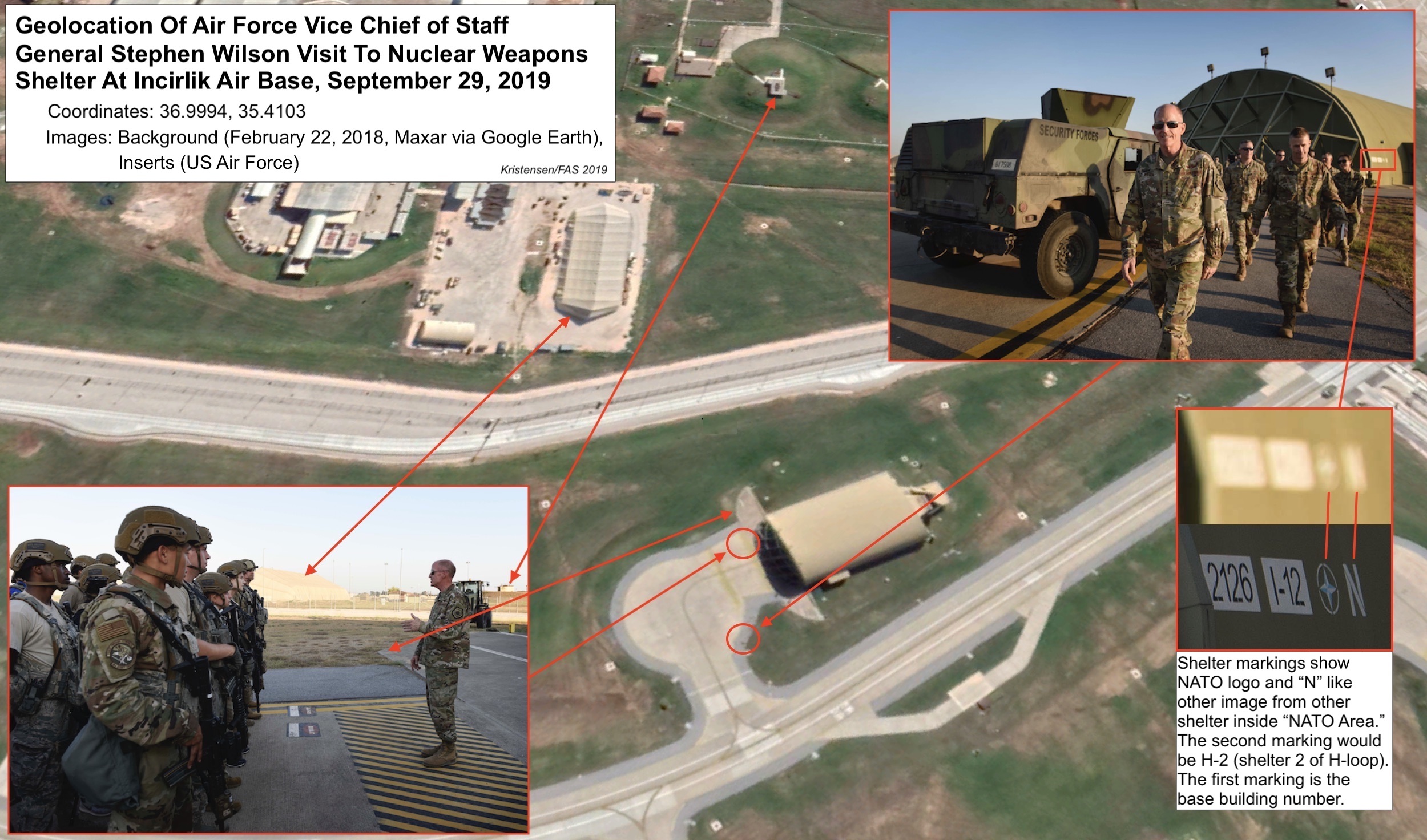
Last month, the Air Force Chief of Staff was taken to a nuclear weapons storage shelter at Incirlik AB. Click on image to view full size.
Recent Activities
If the Air Force decided to withdraw the B61 bombs from Incirlik, it would look pretty much like activities captured by Maxar’s satellites in 2019 and 2017. Those images show what appears to be either actual nuclear weapons movements or training to remove them.
One photo from March 22, 2019, shows a C-17 transport aircraft – likely from the 4th Airlift Squadron of the 62nd Airlift Wing at Joint Base Lewis-McChord in Washington – parked right outside the main gate to the NATO Area. The 4th Airlift Squadron, which is the only unit in the Air Force that is qualified to airlift nuclear weapons, flies Prime Nuclear Airlift Force (PNAF) and Emergency Nuclear Airlift Operations (ENAO) missions (see images below).
The satellite image shows the C-17 and gate area surrounded by armored vehicles and armed guards of the 39th Security Force as well as technicians to protect and carry out the weapon movement. One of the unique vehicles seen is an 18-meter truck lined up with the loading pad of the C-17. The same type of truck can be seen parked at the weapons maintenance unit building a few months later (see image below).
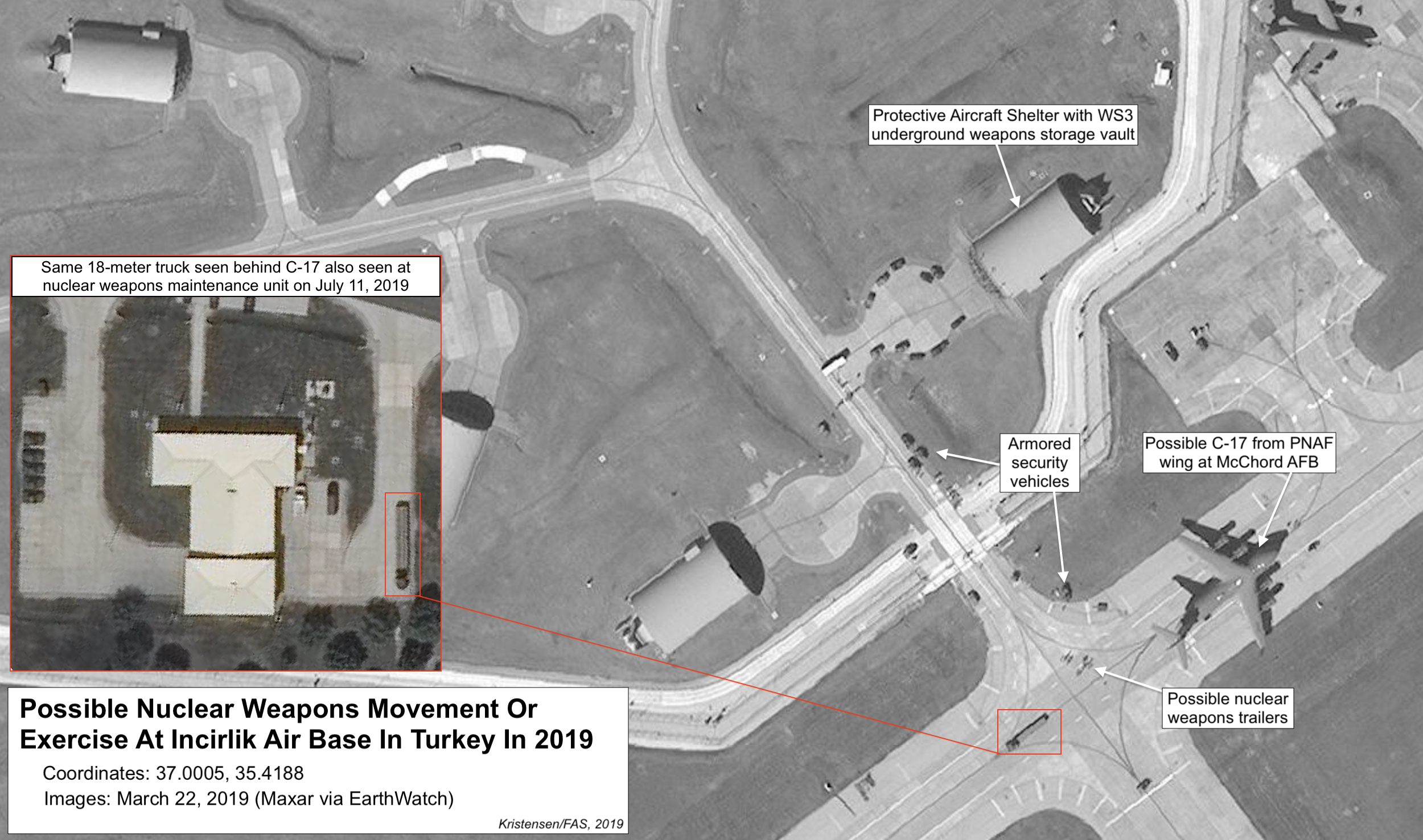
This Maxar satellite image acquired via Earth Watch shows what appears to be a nuclear weapons movement or exercise in March 2019. Click on image to view full size.
Another set of Maxar satellite photos of a possible nuclear weapons movement or exercise is from December 2017. A Nuclear Security Inspection that year (and 2014) reportedly included weapons emergency evacuation drills. The scenario on the 2017 image is similar to that on the 2019 image: a C-17 parked outside the gate, security vehicles surrounding the scene, and transporters for moving weapons. But the 2017 photos are unique because they were taken moments apart as the satellite passed overhead. As a result, movements become visible: On the first image, a possible weapons trailer towed behind a truck in a column of armored security vehicles is moving toward the outer gate of the NATO Area. On the second photo, the column has passed through the gate onto the tarmac and the towed trailer is turning toward the rear of the C-17. The aircraft shadow shows the loading ramp is open and ready to receive the weapons (see image below).
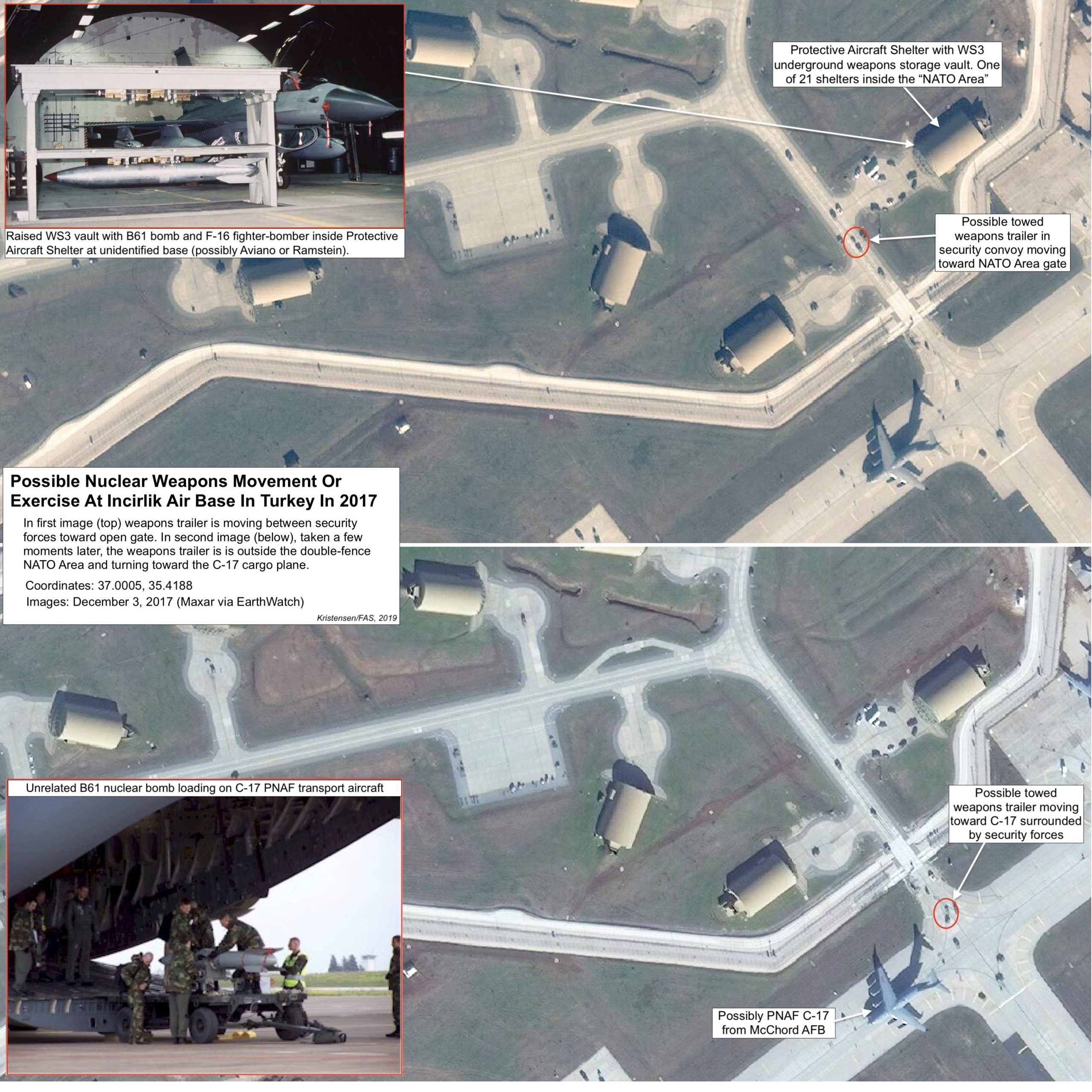
This unique double-image shows what appears to be a nuclear weapons movement or exercise in December 2017. Click on image to view full size.
The Task At Hand: Withdraw The Weapons!
The B61 nuclear bombs at Incirlik should have been withdrawn long ago but tradition, Cold War thinking, and bureaucratic inertia prevented officials from doing the right thing. Now things have come to a head where the United States is faced with the choice of securing its weapons or be seen as abandoning Turkey.
Withdrawing the weapons does not, of course, mean the United States is abandoning Turkey. That relationship is already in serious trouble and keeping the weapons at Incirlik based on the idea that it will somehow counterweight Turkey’s further drift away from NATO is probably an illusion. That boat seems to have sailed; the relationship is likely to deteriorate whether or not there are nuclear weapons at Incirlik. That is the reality the Air Force must relate to now.
Another argument against withdrawal will be that moving them out of Turkey will cause the other members of the so-called nuclear sharing arrangement (Belgium, Germany, Holland, Italy) to question why they should continue to store U.S. nuclear weapons. Withdrawal from Turkey could, so the argument goes, trigger a domino effect of withdrawal from other countries as well.
But the withdrawal of U.S. nuclear bombs from Greece in 2001 and from England five years later did not cause the other countries to demand withdrawal as well or the collapse of NATO. If they truly believe deployment of U.S. nuclear weapons is important for NATO security, then they will stay. If the mission falls with withdrawal from Turkey, then they obviously don’t think it’s important and the weapons should be withdrawn from all the countries anyway. The U.S. extended deterrence posture in Europe can adequately be maintained with advanced conventional forces backed up by strategic forced in the background.
The B61 bombs at Incirlik could easily be dispersed to empty storage vaults in the other countries. Space is not a problem. There are a total of 96 empty weapon slots in the active WS3 vaults in Belgium, Germany, Holland, and Italy. Moreover, there are 25 empty and inactive WS3 vaults with room for 100 bombs at RAF Lakenheath. But public and parliamentary opposition would likely prevent increasing the number of nuclear bombs stored in those countries. If the order goes out to evacuate Incirlik, it seems more likely the bombs would be returned to the United States.
There will be some people who will argue that deteriorating relations with Russia and Moscow’s alleged increased reliance on a so-called “escalate-to-deescalate” strategy of using tactical nuclear weapons first prevent the United States from reducing – certainly withdrawing – its tactical nuclear weapons from Europe. Those are curiously the same people who also argue that the United States should deploy a new low-yield warhead on its strategic submarines and a new nuclear cruise missile on its attack submarines to better counter Russian tactical nuclear weapons – a thinking that was recently endorsed by the Trump administration’s Nuclear Posture Review. That seems to signal to the European allies that the United States actually no longer believes the deployment of B61 nuclear bombs in Europe is credible and that other and better weapons are needed.
Whatever one might think about U.S. tactical nuclear weapons in Europe, Turkey is no longer an acceptable location. Erdogan’s confrontational and authoritarian leadership is rapidly undermining Turkey’s status as a reliable NATO ally, and the deteriorating security situation in the region presents a real physical threat to the weapons at Incirlik. That threat is real and the U.S. military sees it as real. So much so that an extra security force squadron deployed to Incirlik from Aviano Air Base in Italy to beef up nuclear security in response to “regional turmoil and government instability” according to USAF source, and Ohio Army National Guard military police reportedly were dispatched to Incirlik specifically to increase base security.
The security threat to the weapons at Incirlik is urgent and the continued deployment of nuclear weapons at the location is unjustifiable and incompatible with U.S. nuclear security standards. If you don’t believe that, ask yourself this question: If there were no U.S. nuclear weapons in Turkey and someone asked for them to be deployed to Incirlik, would the Pentagon approve?
I doubt it. It’s time to face reality and withdraw the weapons from Turkey before they have to be evacuated under fire.
Additional information:
- US nuclear weapons, 2019
- Tactical nuclear weapons, 2019
- Upgrades At US Bases In Europe Acknowledge Security Risk (2015)
This publication was made possible by generous contributions from the Carnegie Corporation of New York, the John D. and Catherine T. MacArthur Foundation, the New Land Foundation, the Ploughshares Fund, and the Prospect Hill Foundation. The statements made and views expressed are solely the responsibility of the authors.
Russia Upgrades Western Nuclear Weapons Storage Sites
Amidst a deepening rift between the United States and Russia about the role of non-strategic nuclear weapons, Russia has begun to upgrade an Air Force nuclear weapons storage site near Tver, some 90 miles (145 kilometers) northeast of Moscow.
Satellite photos show clearing of trees within the site as well as the construction of a new security fence and guard post. The upgrade, which started late-2017 and was completed late last year, was followed by the arrival of what appears to be weapons transport and service trucks earlier this year (see image below).
The Tver site includes two nuclear weapons bunkers as well as service and security buildings. The new security fence and gate added within the site separates the bunker area from the service area. The site is near the Migalovo Air Base, which is not thought to be housing nuclear strike aircraft but might serve a nuclear weapons transport function. If so, it could potentially be responsible for the distribution of nuclear warheads to tactical air bases in north-western Russia in a crisis.
It is impossible to determine from the satellite images if the Tver site stores nuclear weapons at this time, but it is clearly active with considerable personnel and activities indicating weapons might be present. Alternatively, Tver could serve as an Air Force storage site in a crisis. Tver is one of several dozen nuclear weapons storage sites operated by the Russian ministry of defense and military services (see here and here.
There are also important upgrades underway at the Mozhaysk-10 storage site about 70 miles (114 kilometers) west of Moscow, including addition of new support facilities as well clearing of a previously tree-covered weapons storage igloo. Mozhaysk-10 is one of a dozen national-level nuclear weapons storage site and includes six underground igloos and appears to be expanding (see below). Mozhaysk-10 might be used to store both strategic and tactical nuclear weapons.
The upgrades at the Tver and Mozhaysk-10 sites follow an ongoing upgrade to a nuclear weapons storage site in Kaliningrad that began in 2016 and appears intended to support nuclear-capable forces in the isolated enclave.
Russia is estimated to possess approximately 6,500 nuclear warheads, of which an estimated 4,330 are thought to be available for use by the military. We estimate that Russia has about 1,830 nuclear warheads assigned to non-strategic forces; the Pentagon says the number is “up to 2,000” warheads. The US Defense Intelligence Agency (DIA) recently said it expects to see “a significant projected increase in the number of Russia’s non-strategic nuclear weapons” over the next decade, although some past DIA growth projections have turned out to exaggerated.
In response, the United States has begun to increase the upgrade of its non-strategic nuclear weapons beyond the already-planned B61-12 guided gravity bomb for stealthy F-35 fighter-bombers. New weapons with “tactical” missions include the W76-2 low-yield warhead on the Trident II D5LE SLBM and a new nuclear sea-launched cruise missile. And NATO has been upgrading US nuclear weapons storage sites in Europe.
Russia and the United States refuse to disclose how many tactical nuclear weapons they have or where they are stored, and none of these weapons are limited by arms control agreements.
We will further describe these developments, and much more, in our upcoming Nuclear Notebook on tactical nuclear weapons scheduled for publication in the Bulletin of the Atomic Scientists in September 2019.
Additional information:
This publication was made possible by generous contributions from the Carnegie Corporation of New York, the John D. and Catherine T. MacArthur Foundation, the New Land Foundation, the Ploughshares Fund, and the Prospect Hill Foundation. The statements made and views expressed are solely the responsibility of the authors.
NATO’s Approach to Defense Innovation, & More from CRS
“In the future, NATO might have to rely as much on its agility and capacity for innovation as it has previously relied on its military technological advantage,” says a new report from the Congressional Research Service that reviews NATO’s response to the current threat environment and the changing technological landscape. See Transatlantic Perspectives on Defense Innovation: Issues for Congress, April 24, 2018.
Other new and updated publications from the Congressional Research Service this week include the following.
Law Enforcement Access to Overseas Data Under the CLOUD Act, CRS Legal Sidebar, May 2, 2018
The Travel Ban Case and Nationwide Injunctions, CRS Legal Sidebar, May 2, 2018
Federal Disaster Assistance After Hurricanes Katrina, Rita, Wilma, Gustav, and Ike, updated May 1, 2018
Issues in International Corporate Taxation: The 2017 Revision (P.L. 115-97), May 1, 2018
CRS Products on North Korea, updated May 1, 2018
The Expanding Secrecy of the Afghanistan War
Last year, dozens of categories of previously unclassified information about Afghan military forces were designated as classified, making it more difficult to publicly track the progress of the war in Afghanistan.
The categories of now-classified information were tabulated in a memo dated October 31, 2017 that was prepared by the staff of the Special Inspector General for Afghanistan Reconstruction (SIGAR), John Sopko.
In the judgment of the memo authors, “None of the material now classified or otherwise restricted discloses information that could threaten the U.S. or Afghan missions (such as detailed strategy, plans, timelines, or tactics).”
But “All of the [newly withheld] data include key metrics and assessments that are essential to understanding mission success for the reconstruction of Afghanistan’s security institutions and armed forces.”
So what used to be available that is now being withheld?
“It is basically casualty, force strength, equipment, operational readiness, attrition figures, as well as performance assessments,” said Mr. Sopko, the SIGAR.
“Using the new [classification criteria], I would not be able to tell you in a public setting or the American people how their money is being spent,” Mr. Sopko told Congress at a hearing last November.
The SIGAR staff memo tabulating the new classification categories was included as an attachment for the hearing record, which was published last month. See Overview of 16 Years of Involvement in Afghanistan, hearing before the House Government Oversight and Reform Committee, November 1, 2017.
In many cases, the information was classified by NATO or the Pentagon at the request of the Government of Afghanistan.
“Do you think that it is an appropriate justification for DOD to classify previously unclassified information based on a request from the Afghan Government?,” asked Rep. Val Demings (D-FL). “Why or why not?”
“I do not because I believe in transparency,” replied Mr. Sopko, “and I think the loss of transparency is bad not only for us, but it is also bad for the Afghan people.”
“All of this [now classified] material is historical in nature (usually between one and three months old) because of delays incurred by reporting time frames, and thus only provides ‘snapshot’ data points for particular periods of time in the past,” according to the SIGAR staff memo.
“All of the data points [that were] classified or restricted are ‘top-line’ (not unit-level) data. SIGAR currently does not publicly report potentially sensitive, unit-specific data.”
Yesterday at a hearing of the House Armed Services Committee, Rep. Walter Jones (R-NC) asked Secretary of Defense James N. Mattis about the growing restrictions on information about the war in Afghanistan.
“We are now increasing the number of our troops in Afghanistan, and after 16 years, the American people have a right to know of their successes. Some of that, I’m sure it is classified information, which I can understand. But I also know that we’re not getting the kind of information that we need to get to know what successes we’re having. And after 16 years, I do not think we’re having any successes,” Rep. Jones said.
Secretary Mattis said that the latest restriction of unclassified information about the extent of Taliban or government control over Afghanistan that was withheld from the January 2018 SIGAR quarterly report had been “a mistake.” He added, “That information is now available.” But Secretary Mattis did not address the larger pattern of classifying previously unclassified information about Afghan forces that was discussed at the November 2017 hearing.


